The True Grimoire - Stratton-Kent Jake 2009
My profound gratitude to all those who helped make this book possible against all the odds, through many setbacks and disappointments, To Michelle Newitt for love, support and encouragement, and her painstaking work on many dozens of sigils and their Brazilian equivalents; to Juliette and Mark Williams for their very generous assistance in many details relating to African Traditional Religions, for locating and providing access to many rare documents, and for general encouragement; to Joseph Peterson - masterly occult archivist - for his friendly and helpful response on discovering we were preparing editions of Verum simultaneously, and for supplying high resolution images of important symbols; to Mary Guyver for valuable assistance in translating old French, and the first redrawing of the Armadel sigils; to Brendan Hughes for his multi-lingual skills, his substantial help and support and his belief in the author; to Emanuel Moura for his kind assistance in researching Brazilian and African terms and traditions; to 'Zadkief for pointing me at Trithemius as rhe source of Verum conjurations; and to loannis Marathakis for valuable pointers regarding the history of invisibility spells.
Many thanks also to Peter and Alkistis of Scarlet Imprint for not starting the revolution without me, as well as to David Beth and Tim March for recommending them. To friends, sisters and brothers, past and present, for their work and encouragement at various times. To all those, over several centuries, who have done their best to preserve and elucidate old lore for generations to come, whose work has encouraged and inspired me in this project. Last, but by no means least, to the spirits of the Grimorium Verum, who have led me into deep waters while keeping my head above the waves.
THE TRUE GRIMOIRE
Bhe True Grimoire has been called a book by the devil’ and’par excellence the magical workbook of Europe’. In his introduction to the Key of Solomon, published in 1889, Samuel Liddell MacGregor Mathers described the True Grimoire as 'full of evil magic’ and stated,’I cannot caution the practical student too strongly against [it]’. A.E. Waite considered the Grimorium Verum one of the,’specific and undisguised handbooks of Black Magic] and incorporated sections into his which has the distinction of being named in Aleister Crowley's autobiographical notes, its reading marking the official commencement of his magical career.
Original manuscripts of the Grimoire were unknown to these authors, as they are to the present writer. There are many inaccuracies and omissions in the quite widely differing French and Italian printed versions and perhaps even more so in their English derivatives. Indeed, many of these were catchpenny affairs, exhibiting no care whatever in editing the various materials at their disposal. In consequence a great many important characters and sigils had been lost, substituted, reversed or mislabelled. Idries Shah wrote in his Oriental Magic of:
...the much-coveted Grimorium Verum, [that] by means of it rhe sorcerer may prepare himself for the difficult exercise of the Art, can make the various instruments which are essential to the difficult art of raising spirits, and can evoke and dismiss a large number of powerful beings. Although the title-page says that it was collected and published by'Alibeck the Egyptian' in 1517 (in Memphis), it is more likely to date from the eighteenth century, and was probably printed from a much earlier manuscript. No collated version of the True Grimoire is known,
though parts which are missing in this [French] edition arc apparently available in the more modern Italian editions.
A survey of the variants indicated that to even partially recover the core of a lost 'original’ would require more than a collated edition of the printed versions as suggested by Shah; rather a critical reconstruction was needed. This process of reconstruction has been, hitherto, an unsurmounted obstacle to the production of a definitive edition.
Although writers such as Shah have claimed to synthesise elements of the printed Italian and French editions this has not really served a useful purpose, as often reproducing rhe faults of both as rectifying one by the other. So while his readers may have been led to believe that rhe Italian editions supply deficiencies in the French regarding characters and sigils, in fact they are missing key elements and mislabel others which the French preserves in better order. In addition we find sometimes the French and Italian versions of a particular sigil are reversed in relation to one another, or even that part of one sigil has become attached to another.
Essentially, the problem of characters involves the following:
A) The nature and appearance of the character to be worn by rhe operator when commencing the process of the Grimoire. I shall call this the first character as it is the first to be mentioned and of the first importance in beginning the work. A figure bearing this name, and with identical purpose, appears in the Grimoire of Armadel.
B ) The correct identification of sigils belonging to several spirits in the hierarchy, several of which are attributed to different spirits from one version to another, or rendered backwards or in a mutilated form.
C) Having achieved B, the identification of which of these characters are intended for various magical operations, which use is of two kinds, first for inscribing on various magical tools, and second for use in spells.
Many of the versions published in English during the 20th century failed to note any of these difficulties. Primarily this is because most have drawn from one source, being derived from a single French edition without comparison with the Italian editions which makes rhe discrepancies more apparent. Nevertheless, it appears not to have been noticed that some spirits have been given sigils that are also attributed to another spirit in the same book! This discrepancy becomes more glaring when variants are compared, but is detectable with close examination within each of them.
In one influential French version we have an apparently random selection of fifteen sigils, most of them apparently from a set of eighteen spirits, two from a second set of fifteen who otherwise have none. Both the latter two are actually misattributed, to Minoson and Bucon, which becomes obvious by comparison with the sigils of Bechaud and Frimost.



Top row, ’Bucon’ ami Frimost sigils, ami below, Frimost wand sigil, reversed
The Frimost sigil, despite all difficulties in the variant texts, is particularly consistent in appearance. It is also among the sigils that ap
pear on magical instruments, even in the version where the clearer form of his sigil is misattributed to Bucon. This, taken with the use of his sigil and others as inscriptions on instruments, may point to the source of confusion among the figures. Of the confused sigils, almost every case is to be found among the first eight spirits. Often also we find that the plates illustrating the symbols of the three chiefs in the French editions have additional characters underneath them that are not theirs but those of three of these eighteen spirits. Taken together these facts suggest a misreading of a now lost plate of illustrations.
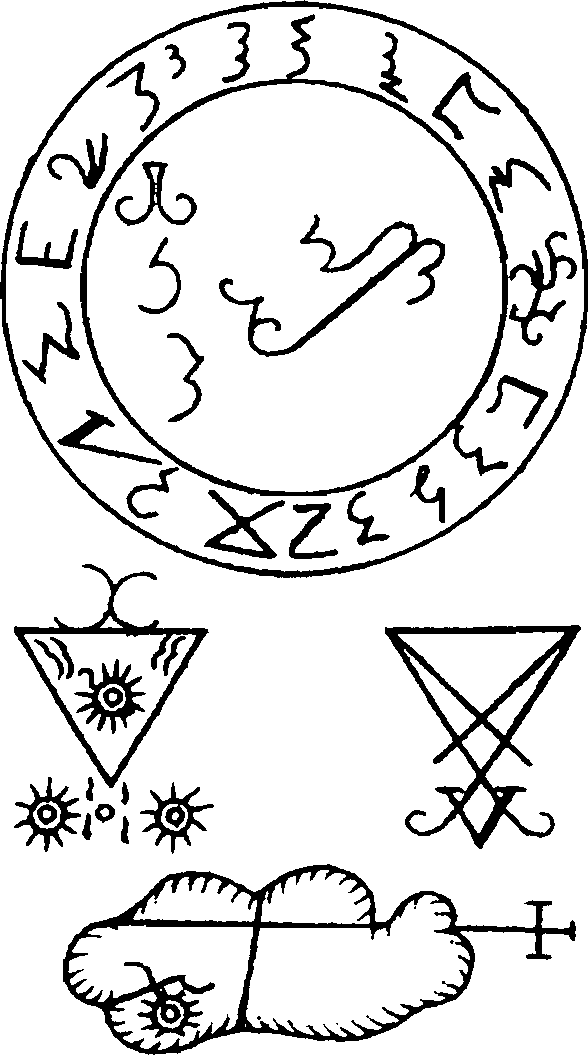
Figure from the French edition: the circular figure is that of Lucifer, the central figure of the three below it is the sigil of Claunech, while the left hand figure represents Lucifer in Europe and that on the right his dominion in Asia.
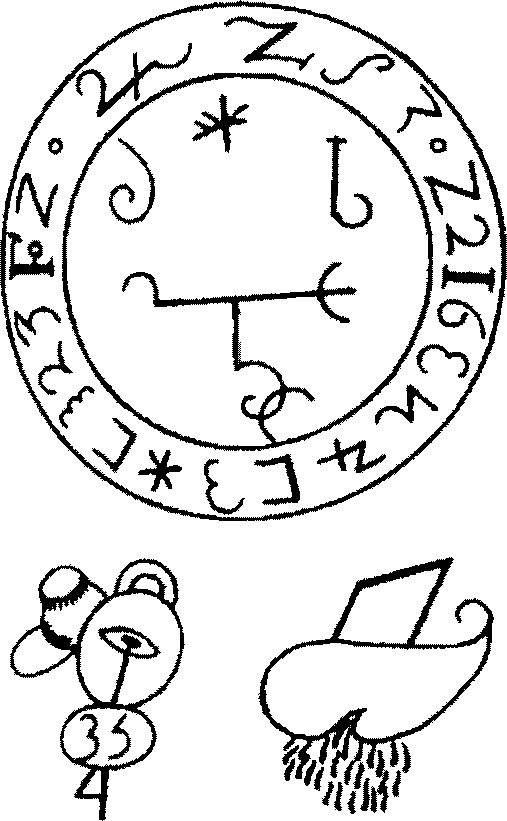

Characters of Belzebuth and Aflaroth from the French edition, with misplaced sigils beneath.
Thus we find mistakenly included beneath the symbol of Lucifer a character that is elsewhere attributed to Claunech, beneath the symbol of Belzebuth a sigil of Musisin, and beneath Astarorh a character that in the Italian is attributed to the spirit Khil, whom in the French is given quite another sigil, which has been copied by most published editions.
These three spirits are among the first eight, as are Bechaud, Friniost and Klepoth, whose symbols would have been given later on because of their relation to the knife and the wands. Another difficulty arises here, for Klepoth has been allocated two different sigils in rhe various editions. I shall refer to these as the dancing and divining sigils. Hie dancing sigil is undoubtedly apt to the functions of the spirit in the editions in which it appears. On rhe other hand, the other sigil has an established relationship with the hazel wand. Klepoth’s dancing role only appears in the editions of the Grimoire with the
dancing sigil. Those versions of Verum with the alternative sigil credit her with the power to provide dreams and visions. This offers a partial resolution of the difficulty, two sigils for two different functions of the same spirit or two Klepoths.
French and Italian variants of Dancing Klepoth sigils


Divining Klepoth sigil
There are also the difficulties in deciding whether rhe French or the Italian version of the Segal and Khil sigils is the correct one. The sigil of Khil in the French is certainly given to Segal in the Italian. Meanwhile the Lansdowne ms in the British Library gives a form for Khil that clearly includes the French Verum sigil. On the other hand the Italian attribution of the figure beneath the sigil of Astaroth to Khil makes a great deal of sense. The preference in this reconstruction, if not necessarily in practice, is to follow the Italian version in this instance. This reading conforms to the hypothetical misreading of the lost plate. In the present writer’s view this hypothesis partially or completely explains the majority of mislabelled cases. A theoretical and partial reconstruction of the plate resolves a great many difficulties. Textual analysis resolves other discrepancies.
Ca>S?2

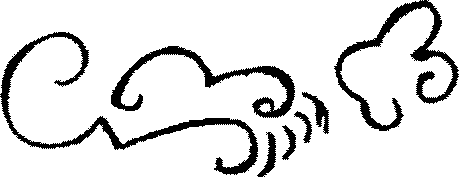
Three variants of the Khtl sigil


French Khil sigil
French Segal sigil


Another French Khil sigil anil the Italian Segal sigil
This reconstruction of the plate places the Lucifer, Belzebuth and Astaroth sigils above those ofClaunech, Musisin and Khil, as already illustrated. The symbols of Bechaud, Frimost and Klepoth would have been omitted as they were to appear accompanying the sections concerning the knife and wands. The remaining symbols would then follow in rows conforming to the order of names given by the French edition, thus:
Semi
Choosing between the variant sigils for Khil and for Segal remains a problem, since there are clearly three sigils between two spirits, with one sigil competed over and another Segal sigil found only in the French editions. The operative reader must resolve this for themselves, and a most straightforward solution is supplied by another aspect of reconstruction of which mention follows in the notes (see Singambuth and Aabidandes, page 132).
Despite these difficulties, it deserves saying that the apparent difficulty surrounding the two spirits from the second list, who are deprived of sigils by rhe hypothesis of the broken plate and by comparative deduction, is resolved nor by characters in rhe Italian version, bur by irs text. There is a collective conjuration in rhe Italian of this entire group of spirits and various superiors, not given in the French. This indicates a different means of employment from those for whom characters are given. The suggested identification of two names, in an obscure parr of the Preamble of the Grimorium Verum, with two superiors among these spirits surmounts a major obstacle to reconstructing the original modus operandi in its entirety. Something along these lines may be rhe clarifying material in rhe Italian which Shah referred to in The Secret Lore of Magic. In that book also he refers to the Grimorium Verum as:
... one of rhe most interesting of magical rituals which include the famous grimoires or black books of the sorcerers. It is, in fact, nothing less than a magician’s handbook, containing in small compass the entire rites of preparation, identification of spirits, [and the process of] conjuration.
In this assessment he is undoubtedly correct, and this compact completeness underlines its importance both to magicians and to students of magic.
Despite its small size it touches on many matters which other more frequently cited grimoires avoid. For whatever reason, by omitting Qabalistic and Hermetic systems that are of more recent vintage than the roots of Goetic practice, while integrating and even highlighting negative Christian interpretation of forbidden magic, it retains what is useful from - or compatible with - themes central to Goetic traditions. Tire Grimoire deals with significant themes that other, often larger, texts have lost, omitted or obscured. By doing so it encourages and assists investigation in precisely those areas. By opening these lines of investigation it helps us engage with themes that larger, apparently more comprehensive texts either will not or cannot
elucidate. It enables the persistent seeker to see, essentially, what many have tailed to see, that underlying Goetic magic is a hidden tradition of great depth and significance. It possesses a traditional methodology that confronts and deals directly with the same primal realities faced by our most remote ancestors; in which all later magic and religion had their original impetus, but which in the West is primarily preserved in Goetic magic alone. As the anthropology' of prehistory has shown, it was this rejected knowledge that initiated human evolution, giving the capacity for abstract or symbolic thought first activated in magic and ritual, and thus for all subsequent scientific and cultural advances. In these elements, its integrated completeness and primal power, lays the importance, and the Truth, of the True Grimoire.
GOETIA AND SIGILS

NL OF THE LEAST UNDERSTOOD aspects of Goetic systems concerns the Magical Parchment. The more gruesome aspects of its preparation in traditional sources so blinded and intimidated previous commentators on the grimoires that they missed
a fair sized baby when throwing out the gory bathwater. Whatever other value it may possess, the work of the editors of the grimoires in the 19'1' century occult revival is wholly inadequate in terms of elucidation. In particular, as an examination of these cryptic documents shows, there was a central role for this prepared parchment and its intended use that was almost entirely missed by Waite, Mathers and Crowley. Indeed, Goetic magic as a whole was largely underestimated and superficially delineated by all these authors.
From one perspective the most relevant exponent of rhe magical revival when considering the grimoires is Austin Osman Spare. His use of sigils and self-devised Magical Alphabets has many points of contact with Goetia. It is not unlikely that he intuitively grasped some principles of Goetic magic underlying the Grimorium Verum itself. However, as Spare was not directly concerned with elucidating older traditions, speculations regarding the origins of his practical insights cannot detain us here.
Waite, eager to show that Western esotericism involves a spiritual path or Secret Tradition comparable with respectable religions, was convinced only that Goetic magic constituted a negative aspect of it, irreconcilable with mystical endeavour. While deserving considerably more respect than he often receives, he was unable to trace the real links with Cabalistic magic within these texts. In my opinion these links are centred on the matter of the parchment.
Despite his dark reputation what little Crowley contributed to the study of Goetic magic is derived largely from MacGregor Mathers. Mathers himself, having substituted new paper for the strenuous task
of preparing lambskin, overlooked the relevance of what is meant to be written on it and why so much is made of it from one grimoire to the next. Now considering the many links between the acts of writing and of performing magic - exemplified by such words as spell, the fact that grimoire means grammar and that the gods of magic in many cultures are also the gods of writing - one might have expected them to have looked deeper, but since they didn’t we must now do so together.
The later grimoires, such as the Grand Grimoire, the Red Dragon &.C. are in many ways corrupt and reduced redactions of such works as the Key of Solomon, but — due perhaps to their closer proximity to our rimes — some illuminating insights into obscure matters in the older texts can be gleaned from them. They are, so to speak, the closest stepping stone to the riverbank, and careful use of them offers a useful first step to understanding older themes. Io illustrate, the key document in these later texts is undoubtedly the Diabolical Pact, which in this context is essentially the source of the magician’s power and a statement of his magical intentions. This is, despite the gross simplifications inherent in these texts, a major clue to the significance of the parchment and its inscription in earlier texts, lhe implication is that the prepared document describes the powers and intentions of the magician; in Verum this is exemplified by the sigils of the spirits written upon the pact, which are also used as inscriptions on magical weapons and in spells, which are the agents of chose powers and of realising those intentions.
In other words, rhe magician’s intent, all rhe instruments and many of the critical operations undertaken, are symbolically stared in a central document whose preparation is thus rhe principal and central act of the entire work. Once understood this role is very apparent, though manifested in variant forms, in rhe majority of Solomonic and related texts. For example, in Verum the operator must first make all the weapons and have them on the altar at the time of preparing the parchment. The main feature of the inscription in this case is a large and elaborate sigil. Ihis is the signature of an intermediary spirit who gives access to all the others, akin in a real sense to rhe Holy Guardian Angel in the Abramelin system; in addition, the conjurations and sigils
Goethi and Sigils
of the spirits whose presence is specifically required in the operations immediately following are also drawn on rhe parchment. This document may be used only once, though several agencies may be conjured at a time. Subsequent operations, and the summoning of other entities from the Verum hierarchy, require the manufacture of another such document. Although it is likely that the magician using this grimoire might need parchment or paper for other subsidiary purposes there is no doubt that such a document as rhis is the reason for the central role given such materials throughout rhe grimoire genre.
Of unique importance in the case of Verum, the inscriptions on several of the magical tools and rhe characters drawn in several of the minor operations are in fact rhe sigils of demons from its hierarchy. All the various actions and intentions involved in Verum style sorcery are directly related ro a series of sigils. Or, to put it another way, everything the operator desires and the operations necessary to achieve it can be reduced to a set of magical characters that can subsequently be employed in attaining those ends. This is why the magical parchment is central to evocation, and why it is the most powerful symbol of rhe magicians will and authority.
THE CONTEXT OF THE GRIMOIRE
HHE USE OF SIGILS as described above resembles the use of various magic squares or characters, often associated with spirits, in the system of Abramelin. In other words, where Verum performs its magic through the sigils of the spirits, Abramelin does the same with magic squares associated with them. Whatever the precise relation of their two approaches, this is not the only linkage of Verum with Abramelin, nor even the most important. The foremost parallel between Abramelin and Verum is the central role of an intermediary spirit to contact the others; the Holy Guardian Angel in Abramelin, the spirit Scirlin in the Grimoire. While Scirlin and the Holy Guardian Angel are distinct in nature their central intermediary role is nor found in any other major grimoire. Interconnection of Verum with one or other text of Abramelin is also found regarding elements of the Character of Scirlin, the name of the spirit Aglasis, and the names of several of the chief spirits. While most recent interest in Abramelin has been focussed on a translation of German manuscripts, certain details unique to the French text are particularly relevant to the study of Verum and Goetic magic. It is true that many magic squares from the German have been badly handled in the French. What is less well appreciated is that the French possesses some squares unique to itself. Among these are the squares of Uriel and Adam that completely distinguish the French ritual equipment and procedure from rhe German, and are powerfully reminiscent of the Divination by the Word of Uriel in the Supernatural Secrets of Verum. Seven other squares are formed from the names of chiefs of the spirits, of which only one originates in the German, also there is in the French a second square of Uriel. The adaptation of Abramelin in the French
manuscript undoubtedly involved elements of a system of Goetic magic closely allied to Verum.
The relationship of Verum with Abramelm is important, but there are significant relations with other texts. In my estimation, the numerous textual correlations of Verum with the mss of the Key of Solomon indicate that Verum connects with an early stage in the development of the latter. The Operator of this system may find it useful to compare the various stages with their equivalents in the Key q/ Solomon. Many of the ritual tools and their preparatory rituals have equivalents in the Key, and aspects of its procedure may also be used to supplement the Verum process. For example, as well as the two inscriptions for the Liming Pot given in Verum, a completely different set of characters is given in the Key. Since the parchment has to be quite large, when making the pot that accommodates it is no trouble to incorporate these in addition to the Verum characters.
In addition, should we be using clay or other materials to make our pot or other required item, there are procedures in the Key with which to facilitate the Verum process. In considering the relationships of the various grimoires it is perhaps more useful not to consider the Key q/ Solomon as a single book, but as the titular archetype of a genre; many books sharing one title. Some manuscripts of the Key of Solomon in fact contain completely distinct ritual systems. Mathers’ supposed master edition succeeds by omission rather than inclusion. Where he distinguishes material from our Grimoire and the Key itself he is not to be entirely trusted. Verum represents a stage in the development of the archetypal Key, and evil spirits aside, is as deserving of our attention as Mathers’ somewhat rigidly defined Key.
Clavicules du Roi Salomon — Livre Troisieme: Lansdowne ms 1202 The first two books of this version of the Key of Solomon, which is lodged in the British Library, were consulted by Mathers in preparing his edition of the Key of Solomon. He noted in his introduction that the third part of the work contained sigils from the Grimorium Verum, and he thus omitted it. The manuscript is some twenty years
older chan rhe printed versions of Verum, although based on internal evidence it is not the original text. In any case, Mathers was of the opinion that anything too strongly suggesting ’black magic’ was nor a real part of rhe Key, and some of his opinions and editorial decisions in this respect are most certainly mistaken. While it is possible that the book represents a compilation of Verum and the Key it is more likely to represent evidence of their common evolution. The importance of this third part lays in two principal departments. Firstly, it supplies the first character which is either erroneously substituted or simply omitted in published editions of the Grimorium Verum. This character plays a substantial role in the process by which the initial pact is formed; in this and other ways the Third Book o/ the Key is useful and important in the task of reconstructing the lost original.
Secondly, by reducing the paraphernalia of evocation to a bloodstone and a single wand it shows itself a more serious relative of the Grand Grimoire, which employs a similar pair of implements. This suggests that at least some of the materials of the Grand Grimoire were collated from or inspired by serious sources. Also among the material Mathers omitted is a close relation of the main Verum hierarchy. Together these details suggest a real familial relationship between these black books, which, for some purposes at least, are better considered together than apart. Given its close relationship with Verum I have employed this manuscript in my reconstruction.
The Steganographia
Illis work of the Abbot Trithemius, a friend and magical mentor of Agrippa, influenced numerous grimoires which incorporated various elements from it. In the case of Verum this involves the conjurations of the Three Chiefs and of Inferior Spirits. It is possible that these elements are deliberate substitutions for conjurations from a lost original, and were perhaps not actually meant to be used by those in the know. Tie operator of the rite in present times can substitute conjurations from the Greece-Egyptian Papyri and elsewhere.
Substitute conjuration of Subordinates:
I call ye: the holy, great of power, great of glory, great of strength, the holy autocthons, that art the assistants of the great god, the powerful chief datmons: Ye who art inhabitants of Chaos, of Erebos, of the abyss, of the depth, of earth, dwelling in the recesses of heaven, lurking in the dark corners of houses, shrouded in dark clouds; Who art watchers of hidden things and guardians of secrets; Ihe leaders of those in the underworld, and administrators of the infinite, wielding power over earth; who shake the earth and did lay its foundations; Thou servants in the chasm, shudderful fighters, fearful ministers; That turn the spindle, loosing the snow and the rain, air-transversers, causing summer heat, wind-bringers, Lords of Fate, inhabitants of dark Erebos, bringers of compulsion, sending flames office, bringing snow and dew, wind-releasers, disturbers of the deep, treaders on the calm sea, mighty in courage, grievers of the heart, powerful potentates, cliff-walkers, adverse demons, iron-hearted, wild-tempered, unruly, guarding Tartarus, misleading Fate, all-seeing, all-hearing, all-subjecting, heaven-walkers, spiritgivers, existing from the beginning, heaven-shakers, gladdening the heart, those who join together death, revealers of angels, punishers of mortals, sunless revealers, rulers of daimons, air-transversers, almighty, holy, unconquerable AOTH ’E ABAOTFi BASUM * JSA K * SABAOTH * 1AO, Come N.
Pseudomonarchia Dcemonum
Part of the Magnum Opus of Johann Weyer (1515-1588) Pnestigiis Dcemonum (1565) is a catalogue of demons, which he called Pseudomonarchia Dcemonum. 'Ihe spirits named are for the most part to be found in the Goetia of Solomon the King (the first book of the compilation known as the Lemegeton) which is generally better known to English-speaking occultists. Several of these spirits names are also found in the Grand Grimoire whose upper hierarchy resembles the Grimorium Verum, leading some commentators to confuse the two
and suggest quite erroneously that Verum is derived From the Goetia. However, no version of Verum 1 have inspected contains this particular group of spirits. In addition, Weyer had a source document of his own, and it was not called the Goetia of Solomon the King. Weyer named his source: Liber officiorum spirituum, sen Liber dictus Empto. Salomonis, de principibus & regibus dxmoniorum (The Book of the offices of spirits, or the Book of sayings of Empto. Solomon concerning the princes and kings of the demons). In private correspondence Joseph Peterson suggested to me that ’Empto.’ derives from a contraction of a Latin term meaning apprentice; this is consistent with elements of the text that make it clear that the author claims to be not Solomon himself but his student in magic. Among the significant differences between Weyer's text and the Goetia of Solomon the King is the absence from the latter of the spirit Pruslas or Busas, who is present in the Grand Grimoire. This spirit is also missing in Reginald Scot's Discocerie of Witchcraft which relies on an incomplete (and highly imperfect) English translation of Weyer’s text. It has been suggested that Scot’s corrupt source may also have provided material for the Goetia. It is equally, if not more possible, that the Goetia derives its hierarchy directly from Scot, just as Shakespeare obtained his references from the same hierarchy. At the same time, it is certain that the well known text of the Goetia currently available did not provide material for Verum or the Grand Grimoire. It is significant too that Colin de Plancy's Infernal Dictionary (first edition 1818) with Louis Breton s famous and often reproduced illustrations of demons, draws directly on Weyer, Illis too is demonstrated by the inclusion of Pruslas as well as giving Weyer as a reference. It is also clear that he drew on both Verum and lionorius (Lucifer's rule of Europe and Asia is cited, along with other details that make this certain). So although Breton's illustrations often accompany recent editions of the Goetia it is apparent that they represent a much wider tradition. Interestingly De Plancy refers in passing to ’English traditions’, and it is to such traditions that rhe Goetia actually belongs, as indicated by all manu scripts of the book being in English, rather than French or Latin.
The Grimoire of Pope Honorius
Also relevant to studies of Verum is the Grimoire of Pope Honorius. The difficulties with printed editions of the grimoires mentioned earlier become acute with this grimoire. Relations between Honorius and Verum are complex, though Verum is demonstrably the older, and a primary source for the compiler of the Honorius grimoire. Seven spirits from the Verum hierarchy are found in editions of the Honorius grimoire, in every case there is some confusion of sigils. The later Italian editions of Verum seem to have absorbed this material back from Honorius because of this connection with Verum spirits. Several Verum spells also find their way into some editions of Honorius; though always without the correct symbols (attempts to rectify poor editions of Verum via Honorius add to rather than diminish confusion). Various editions of Honorius include illustrations from other Goetic texts, chiefly True Black Magic, without regard for accuracy or even honesty. Symbols are inserted haphazardly into one from the other. In one of the later editions an illustration is deliberately doctored (by superimposing the letters NN over a diagram of a magic circle, see illustration opposite) to represent a missing symbol from a Verum spell. The double irony is that the symbol employed in this deception has been lifted from an earlier edition of the Grimoire of Honorius itself! It is for these and similar reasons that I have been selective in using text and entirely avoided using illustrations from Honorius to assist my reconstruction of Verum.
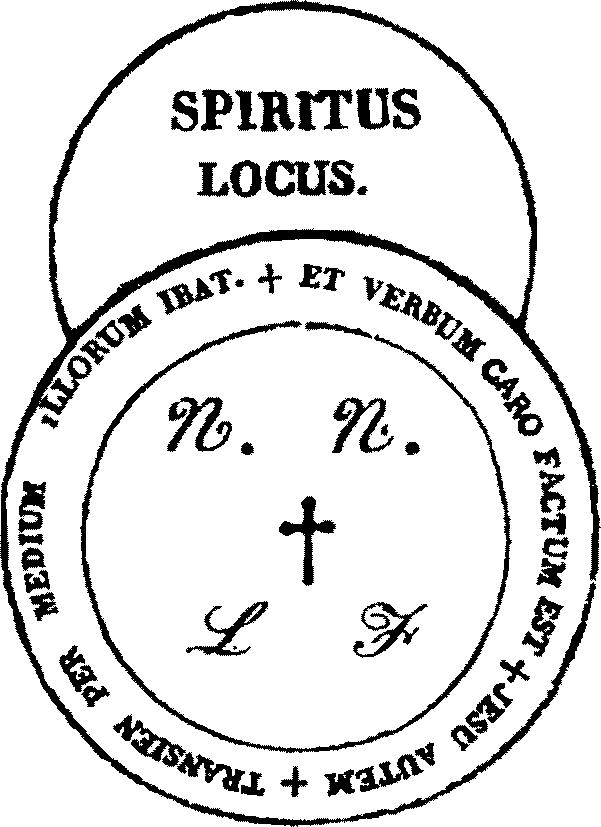
Magical figure Jrom the Grimoire of Pope Honorius
Tlx Book of Saint Cyprian
In Spain and Portugal Saint Cyprian replaces King Solomon as magical hero and as author of magical texts. His Book is a popular grimoire in these countries and their former colonies, especially Brazil. It has many variants, and while well known from the 19th may originate in some form as early as the i6:h century. Tire folk magic core of the book is close in type to'John George’Hohman's 1820 classic Pow-Wows, and the related Egyptian Secrets of Albertus Magnus er al, as indeed to the Supernatural Secrets of Verum itself. Similar secrets are found in the Grand Grimoire, which in fact mentions Saint Cyprian in its Prelude. Some resemblances are generic, the instructions for the invisibility spell has much in common with rhe Verum version, but both reflect a long-lived genre going back to Greek sources. More importantly, the text includes instructions for writing the pact that strongly resembles
those in Verum, and do not appear to be generic. Interestingly, some Spanish versions of the Book oj Saint Cyprian are said to include spirit hierarchies taken from Verum. It is also significant that the Book of Saint Cyprian is a standard feature of Brazilian Umbanda, which may have assisted the diffusion of spirits from Verum within that tradition.
In closing this section of our introductory remarks it as well to say a few words about the probable date and origin of the Grimoire. Understanding the relationship between Verum and Abramelin may cast additional light on this question in future. At present my research has led me to the conclusion that the original much more complete text was very likely French, for a variety of reasons, prominent among them rhe French titles for the four directions integral to the sigil of Scirlin. This character is absolutely essential to rhe performance of the rice in its entirety. It is omitted in the Italian editions, which bear other signs of bowdlerisation, despite supplying much useful additional information towards this reconstruction.
As regards date two factors are important, for although the printed editions of Verum used by Waite, Shah et al are 19th century, there are strong indicators of considerably greater antiquity for the original. For example, the Grimoire of Honorius has early editions, and several of the spirits from Verum are to be found in that grimoire. It is apparent, as accepted by several previous authors, that Honorius borrows from both Verum and True Black Magic. There are various reasons for this agreement, but it is shown most obviously by the more consistent handling of the material in the latter two texts. Obviously Verum has to be extant prior to the publication of Honorius for this to happen. Similarly, as Verum makes mention of the Americas in a structurally important part of the text, it has to post date the discovery and naming of the Newr World.
There is a historical source by which we can give a latest possible date to one of the spirits appearing in both Verum and Honorius who is not known from other sources. Oddly enough, this source has been mentioned in numerous modern works, without this identity being drawn. From the post-Faustian phase of European magic there are various documents surviving which were used in evidence against de
fendants accused of pacts with the devil. One of these supposed pacts, undoubtedly forged by the prosecution, is associated with the unfortunate priest, Urban Grandier. dhis pact is signed at the bottom with several large signatures of demons, who are named in various accounts of the trial.


I he Pact of Urban Grandier
So far as I am aware no attention has been given to the strange symbol at the top, which though smaller than those below is recognisably the same as the sigil of rhe spirit Silcharde.

The Silcharde sigil on the Pact
It may be important that the sigil on the pact also bears the strongest resemblance to the sigil as it appears in French editions of Verum rather than the Italian editions, or in Honorius.

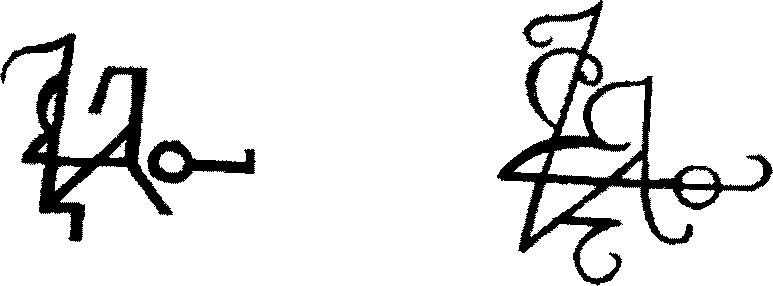
Variants of the Silcharde sigil
Top left, English editions; bottom left, Italian Verum; Top right, Honorius; bottom right French Verum.
In any case, as Grandier's trial took place between 1629 and 1634 this sigil has to have been extant prior to this date.
From such indications as these we can deduce that in something akin to the present form Verum has to originate sometime after 1502. On this date Amerigo Vespucci returned from a voyage exploring the east coast of South America. The continent is apparently named after him or a Bristol trader who had commissioned John Cabot on a similarjourney. Either way, the first recorded use of rhe term ’America’ appeared in 1507. The origin of the book can also be no later than the trial ofGrandier and the first publication of Honorius (also said to be 1629, ocher editions appearing in 1670 and thereafter). Hie frontispiece of the first publication of Verum claims for its contents the dare 1517. Although this falls within the required date range we might be wiser to add a century for the text as we have received it.
THE ART ARMADEL
HHERE IS A PROCEDURE in the magic of the grimoires, with several variant forms, which is squarely based on the magic of the Grieco-Egyptian Magical Papyri. The survival of this ritual shows clear signs of continuity from remote antiquity. The route by which this procedure reached European magicians is presently obscure. It may have survived in some form from Roman times, or have been rediscovered through some oriental contact, or perhaps most likely from Byzantium. That it was adapted to a Solomonic format is not surprising, especially given the fact that Solomon was already a famous magician in the Papyri, besides being a suitable cover name for magicians of Christian Europe. What is surprising is that so much of its ancient form should have survived alongside these adaptations.
The method involves what is known to modern occultists as skry-ing; inducing a series of visions by gazing at a reflective surface, flame or lamp. The variants of the technique include a bowl of water, a pool of ink on the hand, and so on. Regardless of these minor differences the resemblances remain plain.
There are many examples of this method encountered in the Magical Papyri (the Greek and particularly the Demotic), and persisting in the East until modern times. In the majority of them there is a strikingly similar series of events portrayed in the spirit visions. First a single spirit is seen, in many of the demotic versions he takes the form of Anubis. This spirit is asked to bring in a group of other entities, a company of the gods', and is then told to provide these with a feast. When they have eaten the spirit is asked to find out which of them will provide answers to the magician's questions. When one has volunteered the original spirit is asked to clear everything away, the selected god or spirit then answers the questions the magician is concerned about. Incidentally, it is probably from the Arabic name for this and related
' J 1 'T* j—l • ■
Ibe true Grimoire
forms of divination, clarb el'tnendel, that references in the grimoires to an 'Art Armadel’ or ’Almadef derive. It still bore this name in Egyptian magic of the 19th century, which preserved intact virtually all its principal features as encountered in the Magical Papyri. The Art Armadel is probably the most strikingly intact example of the survival of ancient forms in the later magic of the grimoires.
In practice the procedure essentially has two forms. In one form the technique depends on a medium or seer, whose skills are employed by the magician. The other form, known in the Papyri as ’direct vision’, is performed alone; the magician being assumed to have the necessary skills to work as both seer and conjuror. Some ancient forms of the rite, while describing the former approach, stipulate that the direct vision approach can be used instead. There are parallels in the grimoires where one text describes rhe use of a seer, and another grimoire describes a variant of the same rite performed solo; examples are given below.
Historical references to the technique include mention of a method of divination in use among the so-called Persians of Asia Minor, whereby a boy saw in the water effigies of Mercury. From these visions were composed a hundred and fifty verses that foretold all the events of the wars of Mithridates with the Romans. The translation of the boy’s visions into verses is typical of Greek mantic methods, and reflects rhe Hellenic culture of much of Asia Minor ar the time. Agrippa’s account closely resembles that of Apulieus, whose description varies in some minor derails:
... when the inhabitants of Tralles were making inquiries by a magical process in regard to the issue of the Mithridatic War, a boy, who was gazing upon the reflection of a statue of Mercury in the water, uttered a prophecy of the future in a hundred and sixty metrical lines.
If the perceived image was a reflection, as this translation takes it to be, the process involves a magical linking with the god. A similar process was at work when the Delphic Pythoness chewed laurel
leaves. Contrary to popular opinion this would have no narcotic effect, the intention being a sympathetic linkage with Apollo whose plant this is. Tralles incidentally was a city of Lydia, at no great distance from Ephesus. It is very probable that this form of divination was among the magical arts for which Ephesus was renowned in New Testament times.
Various means were employed to enhance this technique in all its forms, such as incense of various kinds, occasionally including vegetable drugs. Sometimes lists of various burnt offerings are also recommended, each for a different purpose, such as to bring in a particular kind of spirit, specific to the kind of vision sought. Others were to hasten the process, or to accompany the dismissal of the spirits and so on. Below are examples of such from pdm xiv. 80-89 which is closely related to the Demotic ritual that follows later.
Prescription for enchanting the vessel quickly so that the gods enter and tell you answer truthfully: You put the shell of a crocodile’s egg, or that which is inside it, on the flame; it will be enchanted instantly.
Prescription to make them speak: you put a frog’s head on the brazier, and then they speak.
Prescription for bringing the gods in by force: you put the bile of a crocodile with pounded frankincense on the brazier.
If you wish to make them come in quickly again, you put stalks of anise on rhe brazier together with the egg-shell as above, then the charm works at once.
If you wish to bring in a living man, you put sulphate of copper on the brazier, and then he comes in.
If you wish to bring in a spirit, you put sa-wr-stone with stone of ilkh on the brazier, and then the spirit comes in. You put on the brazier the heart of a hyena or a hare, excellent.
If you wish to bring in a drowned man, you put sea-karab (stone?) on the brazier.
If you wish to bring in a murdered man, you put ass’s dung with an amulet of Nephthys on the brazier, and then he comes in.
If you wish to make them all depart, you put ape’s dung on the brazier, then they all depart to their place, and you utter their spell of dismissal also.
If you wish to bring in a thief, you put crocus powder with alum on the brazier.
The making of offerings also accounts for rhe importance of the incense burner in these operations. Selection of appropriate incenses for other purposes within the rite might also involve the association of particular plants and substances with particular gods or religious rites. Note the use of an amulet of Nephthys among these prescriptions, when the purpose is a necromantic rite.
The most important and widespread form of skrying in ancient times was divination with water and oil in a bowl used to obtain visions. It has the additional name of Lecanomancy, from the Greek lecane, a bowl. There exist several useful modern academic studies of its role in the Magical Papyri and in later magic in many widespread cultures. Some authorities favour an origin in Mesopotamia rather than Egypt, suggesting it was introduced to the Egyptians by the Persians. ITiis would reflect the Persian conquest of Egypt prior to Alexander, and more importantly for this study may reflect the influence of Chaldean theurgists on Greek and Egyptian magic. Regardless of its origins the Egyptian form is well documented and
highly influential on later magicians. The descriptions in Egyptian sources are thorough as well as consistent, and it is from these that most can be learned concerning it. There are also very strong links between ancient Hydromancy and the practice of Necromancy. When spring water is used it almost invariably indicates this connection is in force.
In addition, a magical plant was occasionally added to the water. Among these must be counted the narcissus. This plant is associated with a Greek myth more likely to have concerned Hydromancy originally than the moralising subject to which it is usually turned. Many details of the myth have parallels in Hydromantic practice, and it is likely the myth originates in a sect employing this technique. The Underworld associations of the plant are extensive, being used in funeral wreaths among Greeks and Egyptians, and attributed to Hades, Persephone and Demeter alike. It also appears among the magical plants of the Eighth Rook of Moses in the Magical Papyri.
Another reinforcing method involved adding various magical stones to the water in the bowl, particularly bright ones, which heighten the brightness of the light reflected. Some of these stones also had magical markings: these could be characters of appropriate spirits or talismans with a divinatory purpose. Hematite, a stone possessing great importance in the lore of the more openly goetic grimoires, was among these stones. Others were stones of a watery nature, such as beryl. Diamonds, on account of their brightness, were also used.
Three examples of the Armadel method follow, one from rhe Demotic Papyri, one from the Graeco-Egyptian Papyri, and another from 19th century Egypt. As mentioned earlier, similar forms were in use in Asia Minor during the same period as the Papyri.
Egyptian form pdm xjv. 52^-53
[A] vessel-inquiry which a physician in the Oxyrhynehus nome [a region of Egypt ruled by Set] gave me; you can also make it with a vessel-inquiry alone by yourself:
Sabanem, Nun, Biribat, Ho! Sabanem, Nun, Biribat, Ho! O god Sisiaho who dwells on the mountain of Kabaho; Agathodaimon in whose hand is the generation of Fate: grant that this boy may enchant the light, for 1 am the face of Nun tn the morning; Halaho at midday; I am Glad-of-face in the evening; I am Ra, the glorious youth whom they call Garta by name; I am he that came forth on the arm of Trtphis in the East; I am great, Great is my name, Great is my real name, I am Ou, Ou is my name, Aou is my true name; 1 am Lot Mulot, the one who prevails, I am Lot Mulot, the one who prevails; my strength is in the flame, and the golden wreath upon my head, Iheyit, Theyit, To, To, Hatra, Hatra, Dog-face, Dog-face. Hail! Anubis, Pharaoh of the underworld, let the darkness depart, bring the light in unto me at my vessel-inquiry, for 1 am Horus, son of Osiris, born of Isis, the noble boy whom Isis loves, who inquires for his father Osiris Onnophris. Hail! Anubis, Pharaoh of the underworld, let the darkness depart, bring the light in unto me at my vessel- inquiry, to my bindingspell here to-day; may I flourish, may he flourish whose face is bent down to this vessel here to-day until the gods come in, and may they tell me answer truly to my question about which J am inquiring here to-day, truly, without falsehood, and at once. Hail! Anubis, O creature and Child, go forth at once, bring to me the gods of this city and the god who gives answer to-day, and let him answer me my question about which I am asking to-day. Say this nine times.
You open your eyes or those of the boy and you see the light. You invoke the light, saying, Hail, O light, come forth, Hail, O light, come forth, O light, rise, O light, rise, O light, increase, O
light, increase, O light, O that which is without, come in. You say it nine times, until the light increases and Anubis comes in,
When Anubis comes in and takes his stand, then you say to Anubis, Arise, go forth, bring in to me the [company of the] gods of this place, then he goes out at the moment named and brings the gods in.
I When you know that rhe gods have come in, you say to Anu
bis, Bring in a table for the gods and let them sit down.
When they are seated, you say to Anubis,
: Bring a wine-jar tn and some cakes; let them eat, let them drink.
While he is making them eat and making them drink, you say to Anubis, Will they inquire for me today? if he says Yes again, , you say to him, The god who will ask for me, let him put forth his
hand to me and let him tell me his name.
When he tells you his name, you ask him [the god identified] as to that which you desire. When you have ceased asking him as to that which you desire, you send them away.
Often but not invariably the magician in such rites invokes and directs events, while a seer - often a chaste boy, a virgin or a pregnant woman (whose virgin unborn child is seen as the true medium) - sees the visions. On other occasions the magician acts both as invoking priest and as seer. The most traditional form requires the seer to lie on their belly to look into the bowl (also appropriate if the water were a pool). A bench or other means of raising the body for this purpose is frequently mentioned, as well as other supports for the bowl and a light or lights employed to reflect on its surface.
Greece-Egyptian form pgm. v 1-53
A Sarapian Divination. To be wrought by help of a boy, with a lamp, a bowl, and a bench:
I invoke thee, oh! Zeus, Helios, Mithra, Sarapis, unconquerable, Meliouchos, Mehcertes, Mehgenctor, Abraal Bachambechi Baibeizoth Ebai Beboth Sertabeboth Amelchipsithiouthipothoio Pnoute Nintherterou lyey Eoo Ateta Eeoia Eeai Eyeie Ooooo Eyeo laoat Bakaxichych Bosipseteth Phobebiboth, the great, great Sarapis, Samasphretb.
O Dargazas 0 Darmagas O Daphar Yakiabotb Ephia Zeleartbar Akrabaeoepbiazale Arbamenothieo Samas Phreti Metbomeo Lamarmera Optebi Ptebi Marianou Akrabaeo Ephtazele Arba-menothi Eo Namisphreti, appear and give heed to him who was manifested before fire and snow, Bainchooouch.for thou art he who didst make manifest light and snow, hurler of shudderful thunder and lightning, Kypodokte Pintouche Etom Ihoout Thasinaeak Arourongoa Paphtha Enosade lae lao At Aoiao Eoey.
If he says, 1 see images, say as follows: Let the throne of the god enter, Thronouzatera Kyma Kyma Lyageu Apsitadrys Ge Moliandron Bonblilon Peuchre, let the throne be brought in. Then if it be borne by four men, inquire what they are crowned with and what precedes the throne. If he says, They are crowned with olive and a censer precedes, the boy speaks true.
The Dismissal: Depart, lord, to thine own world, and to thine own thrones, to thy own orbits, and guard me and this boy unhurt, in the name of the most high god Samasphreth.
Perform this divination when the moon is in a firm sign of the Zodiac in conjunction with beneficent planets, or when she is in favourable limits; not when she is at the full, for thus it is
better, and thus is the divination most orderly performed. But in some copies it is said that it ought to be done when the moon is at the full.
In some forms of this method the light is that of the Full Moon, reflected in a pool or bowl, and this time is often selected for such techniques even when worked indoors. As well as the prone position, other forms place the bowl in the lap of the seer, or make other provisions. This would obviously be preferred with a pregnant seer, The least complicated form of this method employs a pool of ink in the palm of the seer's hand, sometimes — as in the example that follows - in the centre of a drawing of a magic square (rhe square of Saturn). Tie magician makes the conjurations and directions, with an incense burner and a dedicated light source being the only other requirements.
'Modem' Egyptian form, ty* Century
Charles Wycliffe Goodwin, in Fragment of a Gram-Egyptian Work upon Magic, comments on the above ritual:
The operator commands the throne or chair of the god invoked to he brought in. This is supposed to be visible to rhe eyes of the boy who is looking intently into rhe water in the basin. The whole of this operation bears a close analogy7 to that described by Mr, Lane in his Modern Egyptians (vol. it chap.
12) whose account may7 be properly introduced here: ’In preparing for the experiment of the magic mirror of ink, which, like some other performances of a similar nature, is here termed dark el-mendel, the magician first asked me for a reedpen and ink, a piece of paper, and a pair of scissors; and having cut off a narrow strip of paper, wrote up it certain forms of invocation together with another charm, by which he professes to accomplish the object of the experiment. He did not attempt to conceal these, and on my asking him to give me copies
of them he readily consented, and immediately wrote them for me, explaining to me at the same time that the object he had in view was accomplished through the influence of the two first words, Tarshun and Taryooshun [Goodwin’s note: Or Tarsh and Taryoosh; the final un being the inflexion which denotes the nominative case.], which he said were rhe names of two genii, his familiar spirits. I compared the copies with the originals and found they exactly agreed.
Magic invocation and charm:
Tarshun! Taryooshun! Come down!
Come down! Be present! Whither are gone
The prince and his troops? Where are El-Ahmar Tire prince and his troops? Be present, Ye servants of these names!
And this is the removal. And we have removed from thee
Thy veil; and thy sight to-day
Is piercing! Correct: correct.
Having written these, the magician cut off the paper containing the forms of invocation from that upon which the other charm was written; and cut the former into six strips. He then explained to me that the object of the latter charm (which contains part of the 21st verse of the Soorat Kaf, or 50"' chapter of the Kuran) was to open the boy's eyes in a supernatural manner, to make his eyes pierce into what is to us the invisible world.
I had prepared by the magician’s direction some frankincense and coriander-seed and a chafing dish with some live charcoal in it. These were now brought into the room, together with the boy who was to be employed: he had been called in by my desire from among some boys in the street, returning from a manufactory, and was about eight or nine years of age.
In reply to my inquiry respecting the description of persons who could see in the magic mirror of ink, the magician said that they were, a boy not arrived at puberty, a virgin, a black female slave, and a pregnant woman. The chafing dish was placed before him and the boy, and the latter was placed on a seat. Tile magician now desired my servant to put some frankincense and coriander-seed into the chafing-dish; then taking hold of the boy’s right hand, he drew in the palm of it a magic square. The figures which it contains are Arabic numerals.
[Lane’s note: The figures in this magic square are arranged thus:
4 |
9 |
2 |
3 |
5 |
7 |
8 |
1 |
6 |
It will be seen that the horizontal, vertical and diagonal rows give each the same sum, viz. 15.J
In the centre he poured a little ink, and desired the boy to look into it, and tell him if he could see his face reflected in it; the boy replied that he saw his face clearly. The magician, holding the boy’s hand all the while, told him to continue looking intently into the ink and not to raise his head.
He then took one of the little strips of paper inscribed with the forms of invocation, and dropped it into the chafing-dish, upon the burning coals and perfumes, which had already filled the room with their smoke; and as he did this he commenced an indistinct muttering of words, which he continued during the whole process, excepting when he had to ask the boy a question, or to tell him what he was to say. The piece of paper containing the words from the Kuran he placed inside the fore
part of the boy’s takeeyeh or skull-cap. He then asked him if he saw anything in the ink and was answered, No; but about a minute after the boy trembling and seeming much frightened said, I see a man sweeping the ground.
When he has done sweeping, said the magician, tell me. Presently the boy said, He has done. The magician then again interrupted his muttering to ask the boy if he knew what a beyrak (or flag) was; and being answered, Yes, desired him to say, Bring a flag. The boy did so and soon said, He has brought a flag.
What colour is it? asked the magician; the boy replied, Red. He was told to call for another flag, which he did; and soon after he said that he saw another brought and that it was black. In like manner he was told to call for a third, fourth, fifth, sixth and seventh, which he described as being successively brought before him, specifying their colours, as white, green, black, red and blue. The magician then asked him (as he did also each time a new flag was described as being brought), How many flags have you now before you?
Seven, answered the boy. While this was going on, the magician put the second and third of the small strips of paper upon which the forms of invocation were written into the chafing-dish; and fresh frankincense and coriander-seed having been repeatedly added, the fumes became painful to the eyes. When the boy had described these seven flags as appearing to him, he was desired to say, Bring the Sultan’s tent and pitch it. This he did, and in about a minute after he said, Some men have brought the tent, a large green tent; they are pitching it.
Now, said the magician, order the soldiers to come, and pitch their camp around the tent of the Sultan. The boy did as he was desired and immediately said, I see a great many soldiers with their tents; they have pitched their tents. He was then told to order that the soldiers should be drawn up in ranks; and having done so, he presently said that he saw them thus arranged. The magician had put the fourth of the little strips of paper
into the chafing-dish, and soon after he did the same with the fifth. He now said, Tell some of the people to bring a bull. The boy gave the order required, and said, 1 see a bull, it is red; four mm are dragging it along, and three are beating it. He was told to desire them to kill it and cut it up, and to put the meat into saucepans and cook it. He did as he was directed, and described these operations as apparently performed before his eyes. Tell the soldiers, said the magician, to eat it. lire boy did so and said, 7hey are eating it; they have done, and are washing their hands. The magician then told him to call for the Sultan, and the boy having done this said, 1 see the Sultan riding to his tent, on a bay horse, and he has on his head a high red cap; he has alighted at his tent, and sat down within it.
Desire them to bring coffee to the Sultan, said the magician, and to form the court. Lhese orders were given by the boy, and he said that he saw them performed. The magician had put the last of the six little strips of paper into the chafing-dish. In his mutterings I distinguished nothing but the words of the written invocation, frequently repeated, excepting on two or three occasions, when I heard him say, If they demand information, inform them, and be ye veracious. But much that he repeated was inaudible, and as 1 did not ask him to teach me his art, I do not pretend to assert that I am fully acquainted with his invocations’.
Mr. Lane then proceeded to relate how sundry persons whom he named were called for by the boy, and described as appearing in the magic mirror, rhe descriptions given being in some cases astonishingly appropriate.
In line with the rites from the Papyri, the magician was able to call up rhe images of any person living or dead. Mr. Lane asked him to bring in Lord Nelson and Shakespeare among others. It is very unlikely that rhe boy, or even the magician, had heard of or seen images of these people. However, Nelson was described as wearing a dark blue (literally black) European suit and as having lost an arm. The
boy mentioned the left arm as lost, whereas Nelson had lost his right. Mr. Lane asked the magician if the images were seen as in normal vision or as in a mirror, the magician answered as in a mirror. Shakespeare was also described accurately, and so on.
Goodwin’s comment continues:
... the preliminary objects seen, a description of which the magician elicits from the boy by leading questions, are evidently ancient and traditional, and their general resemblance to the appearances mentioned in our ms. is obvious. 'Ihe sultan and his suite have been substituted for rhe divinity borne on his throne by four men; rhe slaughtering of rhe red bull represents a sacrifice symbolised by the thumiaterion or censer; possibly the man sweeping rhe ground may be derived from a neokoroi or temple-sweeper, a very likely personage to have appeared as a precursor to the procession of the god, although not actually mentioned in our ms.
Regarding the title neokoroi mentioned by Griffith, this is a very common Greek expression, and indicates a person dedicated to the service of a deity. The term also frequently appears on Greek imperial medals and signified the devotion of the city represented to the service of a particular deity, as Diana at Ephesus and so on. In this ritual the figure, identified bv Griffith as a neokoros, takes the same role of intermediary as Anubis in the Demotic equivalent. Goodwin goes on to say that, ’the flags recall the sacred banners used in Egyptian ceremonials’. It is noteworthy that the flag was the hieroglyph for god in Ancient Egypt; the seven banners of the vision seem to represent a forgotten company of the gods from the older form of the rite. Banners also form a part of the diagram accompanying a rite of the same nature in the later grimoires.
The appearance of elements of temple ritual in the magic mirror is significant, as in the Roman period many of these temples were closed down. The composers of the Papyri, often suspected by unsympathetic commentators of appropriating archaic ritual materials,
were more likely to have been scaling down temple procedures in which they had once been participants. Some of this process of reduction is physical, reproducing temple procedures in private homes, employing virgin boys in place of dedicated temple personnel and so on. Another part of the process clearly takes place on a visionary level that, as it were, internalises former externals.
The Armadel in the Grimoires
Possibly the best known form of the Armadel method in modern magic is its appearance in the French text of Abramelin. Modern research shows that the original form of Abramelin was German, and the French text has been considerably adapted. Foremost among these adaptations is the use of a child clairvoyant at the critical point of the operation, the invocation of the Holy Guardian Angel. In the I9U1 century the English occultist S.L. MacGregor Mathers translated the French version available to him. He commented at length on this aspect of the rite, and his observations are well informed and valuable. At the same time, his comments involve a certain reticence, with knowing allusions for the benefit of the 'initiated' few:
The idea of the employment of a child as clairvoyant in the invocation of the guardian angel is not unusual; for example, in rhe Mendal, a style of oriental divination familiar to all readers of Wilkie Collins' novel, The Moonstone, ink is poured into the palm of a child's hand, who, after certain mystical words being recited by the operator, beholds visions clairvoyantly therein.
Mathers here avoids reference to rhe text given by Goodwin, with which he was certainly familiar. He had adapted another ritual from Goodwin’s work for his occult society, the Hermetic Order of the Golden Dawn; the so-called Ritual of the Bornless One. Due to Math-
ers’ sometimes excessive belief in occult secrecy he preferred to mention Collins' novel, which was public knowledge, to Goodwin’s revealing academic paper. Machers' comments in favour of the direct vision approach, saying that:
... for my part I cannot understand the imperative necessity of the employment of a child in rhe angelic evocation, if the operator be pure in mind, and has developed rhe clairvoyant faculty which is latent in every human being.
Evocations practiced by Mathers and his fellow initiates involved either direct vision, or a fellow magician taking the role of seer. This approach is not merely preferable, but equally traditional. In Elizabethan times there is the famous precedent in the seer Edward Kelley working with the magician John Dee, In ancient times the virginity and youth of a seer was often more symbolic than actual. ’Hie prophetess at Delphi was a mature woman made virgin for magical purposes by wearing a bridal dress and virgin wreath.
Mathers also mentions the employment of a child seer in rhe celebrated evocation involving Benvenuto Cellini. More central to Mathers’ remarks is the 18th century magician Cagliostro:
The well-knownjoseph Balsamo, Count Cagliostro, is said to have been born ar Palermo in 1743. On his trial at Rome in 1790, and at Zurich in 1791, he was accused of'having practised all kinds of impositions; of gold making, and of possessing rhe secret of prolonging life; of teaching Cabalistic arts; of summoning and exorcising spirits; of having actually foretold future things especially in small and secret assemblies, and chiefly by means of a little boy whom he took aside with him into a separate room, in order to fit him for divining.
With regard to rhe manner in which he employed this child clairvoyant, the documents of the trial give the following information: This child had to kneel before a small table, on
which a vessel of water and some lighted candles were placed. He then instructed the boy to look into the vessel of water, and so commenced his conjurations; he next laid his hand on the head of the child, and in this position addressed a prayer to God for a successful issue of the experiment, lhe child now became clairvoyant, and said at first that he saw something white; then that he saw visions, an angel, &c.
Resemblances to the Arab form are apparent throughout, and Mathers clearly relates both to Abramelin. However, the use of a vessel of t
water and candles are important derails for other reasons, as will become clear.
Again the documents say, 'That he worked through the usual ceremonies, and that all was wonderfully corroborated through the appearance of the angel'.
Mathers further notes that:
Cagliostro is also said at Milan to have availed himself of the services of an orphan maiden of marriageable age as clairvoyant.
Other sources specify that the rites in Milan involved a phial of water and two torches:
It will be remarked that this modus operand! differs strongly from that employed by the mesmerists and hypnotists of today with their clairvoyants. For here the whole force of the operator was concentrated on a magical ritual of evocation, the hand being merely laid on rhe child’s head to form a link; and it in no way appears that the child was reduced to the miserable condition of automatic trance now practised, and which a really advanced occultist would be the first to condemn, as knowing its dangers. On the other hand, there seems co be a distinct
similarity between Cagliostro's method, and the system of oriental divination called the Mendal, to which I have previously referred.
The correctness of his identification of Cagliostro's method with rhe Mendal is apparent from comparison with the rituals given earlier. It is further corroborated by details he omits. These operations, and the angel encountered in them, gave access to seven pure spirits, and the ritual described bears a close resemblance to one found in various contemporary grimoires, of these that occurring in the Grimorium Verum and known as Divination by the Word of Uriel is particularly close to Cagliostro’s method.
The Divination by the Word of Uriel is very closely related to The Operation oj Uriel Seraphim. The latter appears in the seventeenth century Grimoire ou la Cabale by Armadel, (ms 2494 Bibliotheque de 1'Arsenal, see illustration opposite). A slightly different version of the illustration accompanying this rite appears in Mathers' translation of the Grimoire of Armadel (from Bibliotheque de 1'Arsenal, Sc. Et A. No. 88), though strangely unaccompanied by any mention of the ritual.
The Armadel form does not employ a child seer, just as in the papyri where we find variants for direct vision by the magician alone. There are also some differences in wording from the Divination appearing in the Grimorium Verum as may be seen below:
Uriel Seraphim, potesta Io, Zati, Zata, Abbati, Abbata, Agla, Cailo, Caila, I pray thee and conjure thee in the name of the Living God and by Him, thy master and mine; by all the might oj the Holy Trinity; by the virginity of the Holy Virgin; by the four sacred words which the great Agla said with His own mouth to Moses, Io, Zati, Zata, Abbata; by the nine heavens in which thou dwellest; and by the virtue of the characters said before, that thou appear to me visibly and without delay in a fair human form, not terrifying, without or within this phial, which holds water prepared to receive thee, in order that thou mayest answer what I desire to ask thee,
and fetch the book of Moses, open it, put thy hand upon it and swear truth while making me see and know clearly all that J desire to know; appear then, 1 conjure thee in the name of the Great God, Almighty Alpha, and be thou welcome in galatim, galata, cailo, caila.
The dismissal is as follows: Go beneficent jinnee; return in peace unto the places destined for thee, and be thou always ready to come and to appear when I call upon thee in the name and on the behalf of the great Alpha.


< <” S $ u- f J a < h lt I ,la hja e(
-” .y 11 raphari ijrtlihr/


The Operation of Uriel Seraphim
The accompanying illustration shows seven sigils above, representing the company of the gods, or in this case the planetary angels or Seraphim. The role of Uriel as intermediary, corresponding to Anubis in the Papyri, has been largely lost in the text of the rite, due probably to uninformed adaptations. It is nevertheless apparent from the word Armadel in the title of the grimoire, from the illustration, and the correspondence of various features of the rite with its predecessors. The wide influence of this manner of working can be seen in the career of the Elizabethan magician John Dee, referred to above. He operated a Mendal system known as the Heptarchia Mystica in which his seer was Edward Kelley. In this adaptation the seven pure spirits become the lords of the seven days of the week, accompanied by their ministers. Dee’s method resembles the Operation of Uriel Seraphim in another important respect. Uriel is frequently encountered in Dee’s magical diary, recording Angelic conversations resulting from these rituals.
Dee’s system is the best known application of the Armadel method in modern occultism of the English speaking world. The Abramelin system as made known by Mathers is almost as famous. However neither of these systems originated the method, which is a survival from remote times to which the grimoire tradition is the natural heir. While terms, names and titles related to Armadel are frequent in the grimoire literature, particular grimoires best exemplify the actual method. Among these the True Grimoire is certainly prominent, and not only for its inclusion of the Divination by the Word of Uriel.
Although the Olympic spirits prominent in related grimoires could easily replace the Seven Angels of the Divination technique, historical examples show that the Armadel method was never restricted to spirits of the seven planets or days of the week. The hierarchy of Verum is thus equally appropriate to the method of Armadel. Indeed the three chiefs and their deputies, nine in all, are equal in number to some companies of the gods prominent in Grteco-Egyptian magic of this type. On the other hand the demons of the seven days of the week and the intermediary spirit of the Verum system could as readily be employed in an adaptation of the Divination.
While the Divination is certainly a clear cut example of the method, and various Verum processes could readily be adapted to the Armadel approach, it appears that the main system of Verum is an extended example of the same approach. The Verton method employs an intermediary spirit for contacting the others, strongly suggesting the Armadel approach was the original core of the system. The use of invocations based on Trithemius, whose method is closely related to crystallomancy, also supports this interpretation. Further, there are clearly two conjuring processes interweaved in the text of Verum. One of these is the straightforward approach, standing in a circle with ritual equipment, making conjurations and speaking to spirits. Besides this however is another method, where sigils are drawn and invocations are simply written and then recited. This method clearly requites the magician to be seated, and the likelihood is that this involved the Armadel approach, most likely by direct vision of the magician acting alone.
THE TRVE GRIMOIRE
OR
The most approved Keys of Solomon the Hebrew Rabbin, wherein the most hidden secrets, both natural and supernatural, are immediately exhibited, but it is necessary that the demons should be contented on their part.
WITH
A collection of curious secrets; in particular the CABALA OF THE GREEN BVTTERFLY
Approved by Frimost
Edited and expanded from various manuscripts and tomes by Count Abaka


Hreasure L i', o my son Roboam! the wisdom of my words, seeing that I, Solomon, have received it from the Lord’. Then answered Roboam, and said’How have I deserved ro follow the example of my father Solomon in such things, who hath been found worthy to receive the knowledge of all living things through an angel of God?’
And Solomon said’Hear, O my son, and receive my sayings, and learn the wonders of God. For, on a certain night, when I laid me down ro sleep, I called upon the most holy name of God, and prayed for the ineffable wisdom, and when I was beginning to close mine eyes, the angel of the Lord appeared unto me, spake many things courteously unto me, and said’Listen O Solomon! thy prayer before rhe most high is not in vain, and since thou hast asked neither for long life, nor for much riches, nor for rhe souls of thine enemies, but hast asked for thyself wisdom to perform justice.’Thus saith the Lord: ’According ro thy word have I given unto thee a wise and understanding heart, so that before thee was none like unto thee, nor ever shall arise.’ And when 1 comprehended rhe speech which was made unto me, 1 understood that in me was rhe knowledge of all creatures, both things which are in the heavens and things which are beneath the heavens; and I saw that all the writings and wisdom of this present age were vain and futile, and that no man was perfect. And I composed a certain work wherein I rehearsed rhe secret of secrets, in which I have preserved them hidden, and I have also therein concealed all secrets whatsoever of magical arts of all the masters; all secrets or experiments, namely, of these sciences which are in any way worth being accomplished. Also I have written them in this Key, so that like as a key openetli a treasure-house, so this alone may open the knowledge and understanding of magical arts and sciences.
’Therefore, O my son! thou mayest see every experiment of mine or ! of others, and let everything be properly prepared for them, as thou : shall see properly set down by me, both day and hour, and all things f necessary; for without this there will be but falsehood and vanity in ? this my work; wherein are hidden all secrets and mysteries which can ? be performed; and that which is (set down) concerning a single div- j ination or a single experiment, that same I think concerning all things | which are in the Universe, and which have been, and which shall be i in future time, 1
’Therefore, O my son Roboani, I command thee by the blessing | which thou expectest from thy father, that thou shall make an ivory [ casket, and therein place, keep, and hide this my Key; and when I shall have passed away unto my fathers, I entreat thee to place the same in my sepulchre beside me, lest at another time it might fall into the hands of the wicked.’And as Solomon commanded, so was it done.
And when, therefore men had waited for a long time, there came unto the sepulchre certain Babylonian philosophers; and when they had assembled they at once took counsel together that a certain number of men should renew the sepulchre in Solomon’s honour; and when the sepulchre was dug out and repaired the ivory casket was discovered, and therein was the Key of Secrets, which they took with joyful mind, and when they had opened it none among them could understand it on account of the obscurity of rhe words and their occult arrangement, and the hidden character of the sense and knowledge, for they were nor worthy to possess this treasure.
Then, therefore, arose one among them, more worthy than the others, both in the sight of the gods, and by reason of his age, who was called Iroe the Grecian, and said unto the others’Unless we shall come and ask the interpretation from the Lord, with tears and entreaties, we shall never arrive at the knowledge of it.’
Therefore, when each of them had retired to his bed, Iroe indeed falling upon his face on the earth, began to weep, and striking his breast, and said 'What have I, above others, deserved seeing that so many men can neither understand nor interpret this knowledge, even though there were no secret thing in nature which the Lord hath hid-
den from me! Wherefore are these words so obscure? Wherefore am I so ignorant?’
And then on his bended knees, stretching his hands to heaven, he said O God, the creator of all, thou who knowest all things, who gavest so great wisdom unto Solomon the son of David the king, grant unto me, I beseech thee, O holy omnipotent and ineffable Father, to receive the virtue of that wisdom so that I may become worthy by thine aid to attain unto the understanding of this key of secrets.'
And immediately there appeared unto me the angel of the Lord, saying 'Do thou bear in mind that if the secrets of Solomon appear hidden and obscure unto thee, that the Lord hath wished it, so that such wisdom may not fall into the hands of wicked men, wherefore do thou promise unto me that thou art not willing that so great wisdom should ever come to any living creature and that which thou re-vealest unto any let them know that they must keep it unto themselves otherwise the secrets are profaned and no effect can follow?’
And Iroe answered 'I promise unto thee that to none will I reveal them save to the honour of the Lord and with much discipline unto penitent, secret and faithful people,’
Then answered the angel 'Go and read the Key, and its words which were obscure throughout shall be manifest unto thee.’ And after this rhe angel ascended into Heaven in a flame of fire.
Then Iroe was glad and labouring with a clear mind understood that which the angel of the Lord had said and he saw that the Key of Solomon was changed so that it appeared quite clear unto him plainly in all parts.
And Iroe understood that this work might fall into the hands of the ignorant and he said ’I conjure him into whose hands this secret may come by the power of the creator and his wisdom that in all things he may desire, intend and perform that this treasure may come unto none unworthy, nor may he manifest it unto any who is unwise, nor unto one who feareth not God. Because if he act otherwise, I pray God that he may never be worthy to attain unto the desired effect,’
And so he deposited the Key, which Solomon had preserved, in the ivory casket. But the words of the Key are as follows, divided into two books, and shown in order.
This mysterious Key of science was concealed for centuries from the Despots and the Grandees of the Italian soil, the extent of which tyranny held the People in ignorance, attended from birth and through life by superstitious bigotry and erroneous beliefs, not eager to investigate the truth. But now the age has come in which the fogs of ignorance are to be ended, making way for the light of the truth the people have so long yearned for, in which freedom is given to humanity to truly study and to know the foundation of this Science divine so called because revealed from the Angel of God, that was otherwise hidden.
A Teacher, living in truth and prayer for humanity, has restored this Key accurately, studied from the scholars so that our Italy can be counted among those accomplished in hidden Sciences, as in rhe other Nations.
PREAMBLE

ere begins the Sanctum Regnum, called the King of Spirits or the Keys of Solomon, a very learned Necromancer and Hebrew Rabbi.
In this book are contained various dispositions of characters, by which powers the spirits are invoked, to make them come when you will, each according to his power and to bring whatever is asked and that without any discomfort, providing also that they are on their part content, for this sort of creature giveth not anything for nothing!
In the first part is taught the means of calling forth the Elemental Spirits of the Air, Earth, Sea and Infernus, according to the correct correspondences.
In the second part are expressed the secrets, both Natural and Supernatural which operate by the power of the Demons. You will find the manner to make use of them and all without deceit.
In the third part is the Key to the Work, with the manner of employing it. But, before starting this, it will be necessary to be instructed in the following.
Hhere are three powers, Lucifer, Belzebuth and Astaroth.
You must engrave their characters in the correct manner and at the appropriate time. Believe me, all is of consequence, nothing is to be omitted.
You must carry the character of the spirit with you. If you are male, in the right breast pocket, if you are a female carry the character on the left side (some say on the left thumb) or between the breasts like a reliquary. It is to be written with your own blood, or that of a seaturtle which, say some texts, should be of your own sex.
Tliis character should be made under or on reverse of rhe character of the spirit. You put at the two half circles the first letter of your name and surname.
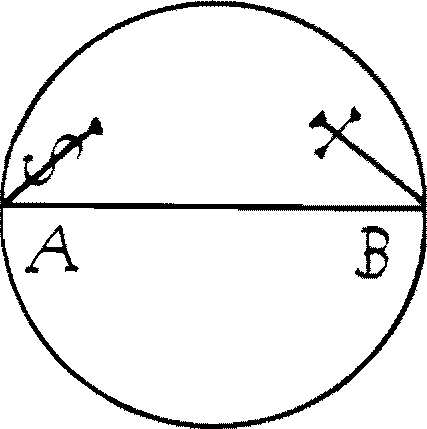
And if you wish more, you draw the character on an emerald or ruby, fotthey have a great sympathy with the spirits, especially those of the Sun, who are the wisest, and are friendlier and better than the others. Whichever the sex of the operator write or have engraved the character on the day and in the hour of Mars.
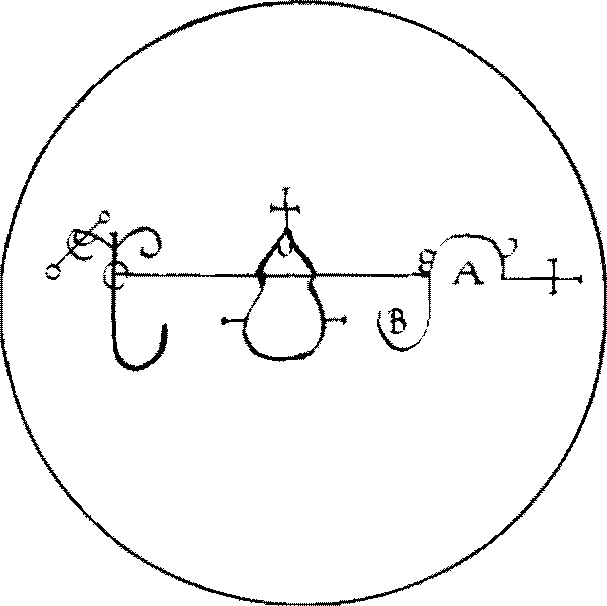
Another form of the First Character
Afterwards otter fine incense moistened with your own flowing blood or that of a male kid, with invocation to the Spirit of the East.
Obey the spirits in this, that they may obey thee.
Tire prelude explains, in describing rhe spirits, what is necessary to be read and understood by those concerned with this Holy Work.
'Ihe spirits who are powerfill and exalted, serve only their confidants and intimate friends, by the pact made or to be made according to certain characters of the will of Singamhuth or of his Secretary, Aabidandes (or Rabinadas), of whom we will give you information. He is the perfect acquaintance to call, conjure and constrain, as you will see in the key, where you will be given the method of making a pact with spirits. They will come according to the character and temperament of rhe one who invokes them. You can become familiar with them without much difficulty following my instructions, such is my wish, making all ordered and rational. The more obscure and difficult things would be too clear if explained, they are to be examined by Rabinadas and his demands are to be satisfied in return.
Thus this work contains clear teaching in a little space, it is certain that if you are willing to accept a little difficulty in return for your needs, all will become clear as you proceed.
The Nature of the Pacts
There are only two kinds of pact, the tacit and the apparent, otherwise said the implicit and explicit. You will know the one from the other, if you read this little book. Know, however, that there are many kinds of spirits, some attractive and others nor attractive. It is when you make a pact with a spirit, and have to give the spirit something that belongs to you, that you have to be on your guard.
The Kinds of Spirits
In regard to spirits, there are the superior and the inferior. The titles of the superiors are: Lucifer, Belzebuth, Astaroth: Emperor, Prince, Duke, three spirits over all. Tire inferiors of Lucifer are in Europe and Asia, and obey him. Belzebuth lives in Africa and Astaroth inhabits Kw-Tca,
Of these each of them has two who order their subjects all that which the Emperor has resolved to do in the world, and vice versa.
The Appearance of Spirits
Spirits do nor always appear in the same shape. This is because they are not themselves of matter or form and have to find a body to appear in, and one suitable to their manifestation and appearance.
Lucifer appears in the form and figure of a fair boy. When angry he seems red. There is nothing monstrous about him. Honorius says of him that he requires an offering of a mouse.
The Characters of Lucifer

Lucifer in Europe
Lucifer in Asia
Belzebuth appears sometimes in monstrous forms, sometimes like a giant cow, at times like a he goat, with a long tail. When angry he vomits fire.
The Character of Belzebuth
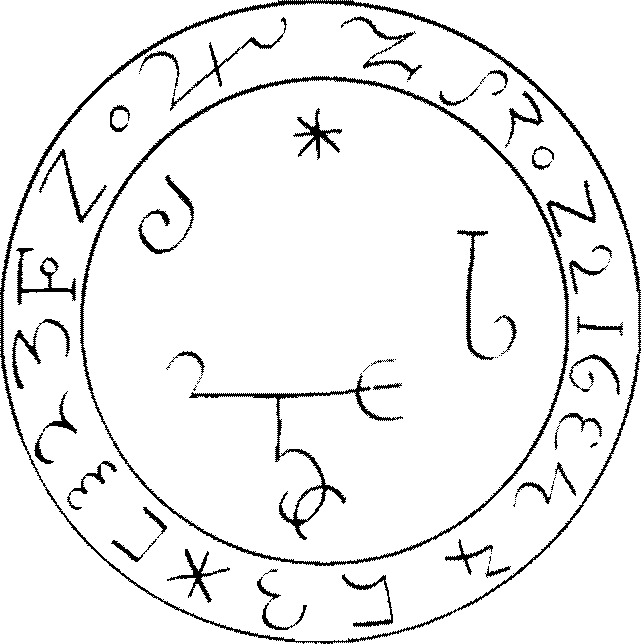
Astaroth appears black, in human shape. Honorius says of him that he giveth favour of kings and lords.
The Character of Astaroth
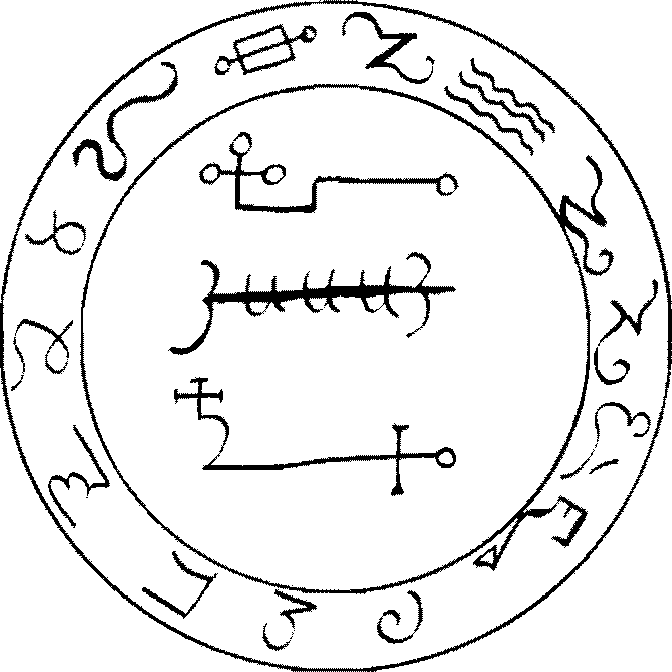
It is only necessary when you desire to invoke them, to call them by the characters which they themselves have given. And when you wish to invoke them, call them to serve you in the manner taught in the third part.
Moving down to the deputies of the Chief Spirits; Lucifer has two demons under him. Satanakia who has these characters:

Satanakia
Hie second deputy of Lucifer is Agalierap who has these characters:
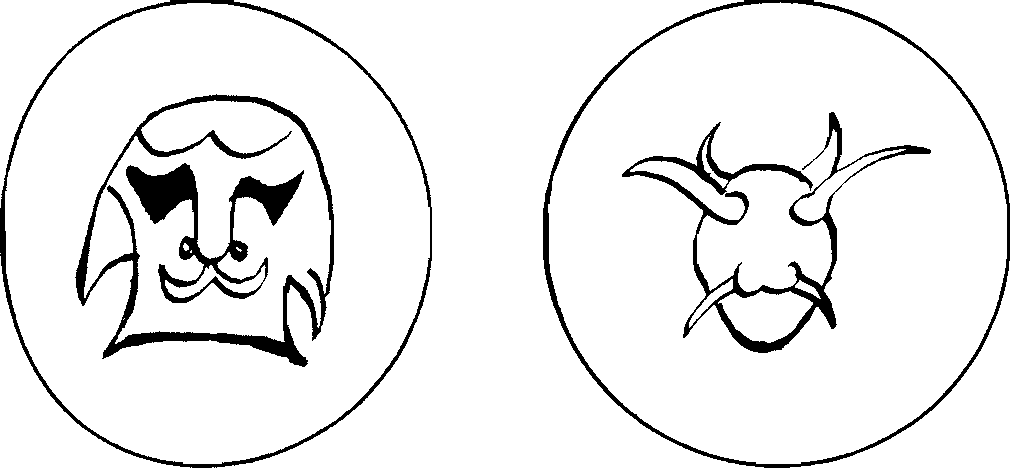
Agaherap
The deputies of Belzebuth are:
Tarchimacbe (also called Lucifuge Rofocale)

And Fleruty

Hie deputies of Astaroth are:
Sagatana
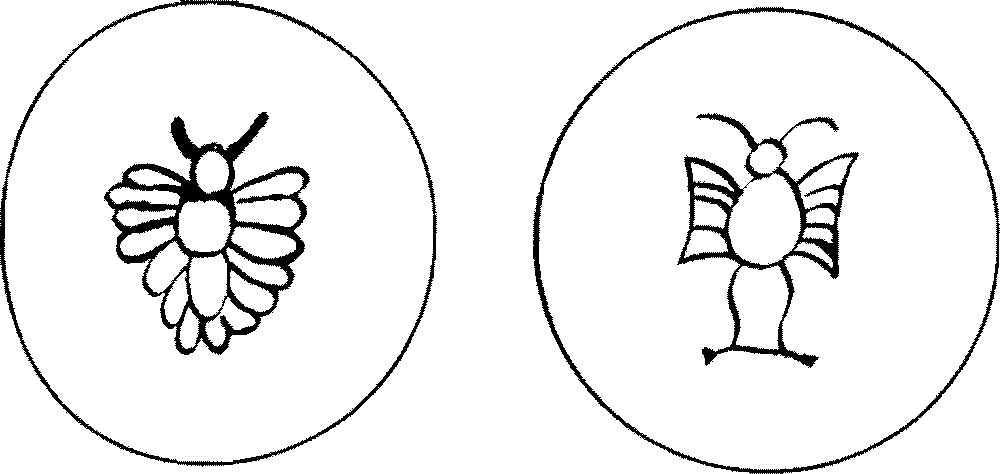
And Nebiros
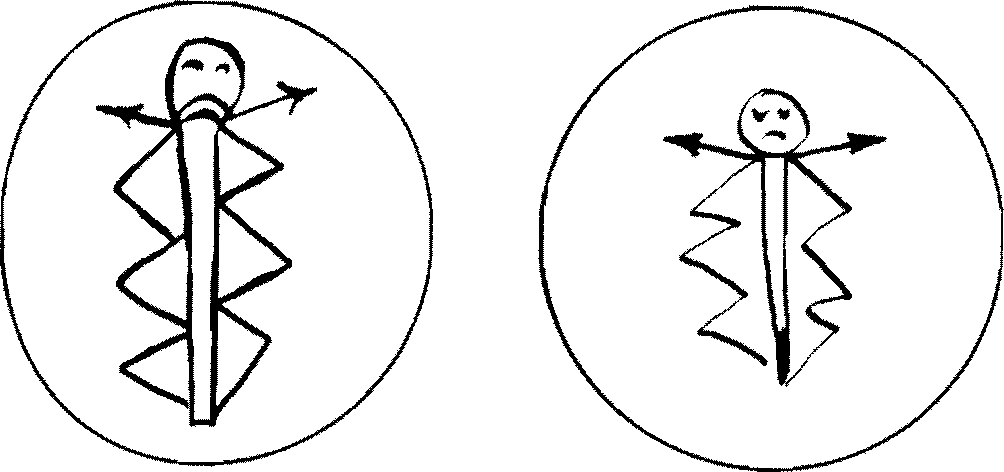
There are yet other demons under Duke Syrach; there are eighteen of these, and their names and rulerships are:
Claunech, also known as Elantiel or Chaunta, has power over riches, causes treasures to be found. He can give great riches to he who makes a pact with him, for he is much loved by Lucifer. It is he who causes money to be brought. It is also said that he has power over merchandise and wares. Those who make an agreement with him, he will show where to find treasure and will impart to ye the wisdom to attain wealth.

Claim eel)
Musisin, also called Resochin or Roschim, has power over great lords. He teaches all that happens in the republics and rhe Affairs of the Allies. Also said: his powers are over the aristocracy and he reveals affairs of State, He can also remove the means to such knowledge.

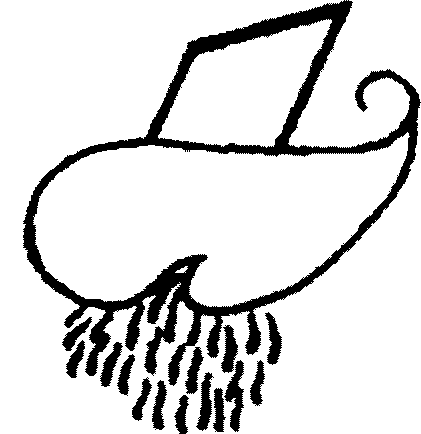
Bechaud, also known as Bechet, Bechar or Bechard, has power over storms, tempests, rain, snow and hail, and other natural forces; over winds, frosts, thunderstorms, rains of blood, and of toads and other species. Also said: he controls all kinds of weather, be it wind, hail, rain or tempest, and will serve you with any weather, for any task. Honorius says of him that he requires a walnut in sacrifice.
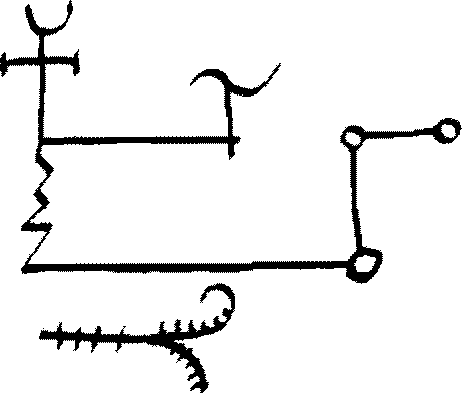
Bechaud
Frimost, also called Frimoth, has power over what concerns men and love. He has power over women and girls, and will help you to obtain their use. He can excite or obstruct all human passions, can extinguish or augment the passion of girls, and provoke miscarriage in women. Honorius gives him the additional name of Nambroth, and urges the magician to treat him very respectfully, also to give him the first stone the magician finds.
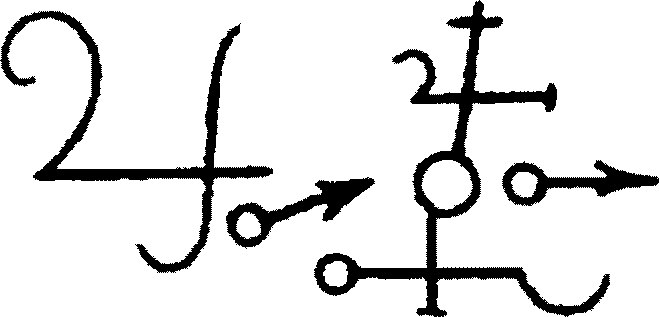
Frimost
Klepoth or Kleppoth, also known as Kepoth can turn a 1000 turns, when dancing with her companions and will make them hear beautiful music, which one will believe is real. If you wish, in passing she will whisper in your ear the cards of those who are playing with you. According to others, makes you see all sorts of dances, dreams and visions.
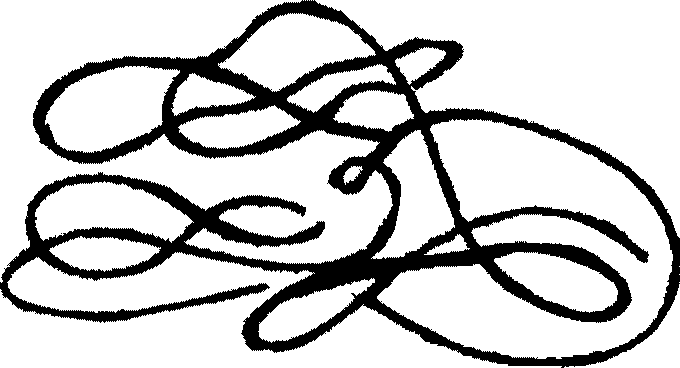
Klepoth
Khil, known also as Klic or Kleim, causes powerful earthquakes on houses and towns.

Khil
Mersilde, known also as Mertiel or Inertiel, will transport you in an instant to any place or region that you want. Has the power to transport anyone in an instant anywhere. Also said: aids ye to be transported to anywhere quite easily.
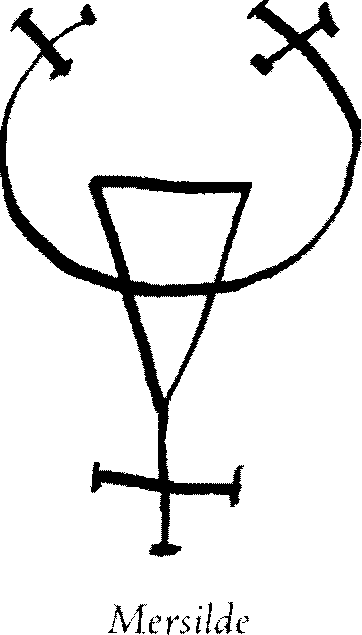
Clisthert, called also Sirumel or Selytarel, will make his spectators feel it is day or night, light or darkness. Allows you to have day or night, whichever you wish when you desire either. Also said: he avails ye the pleasures of night and day.
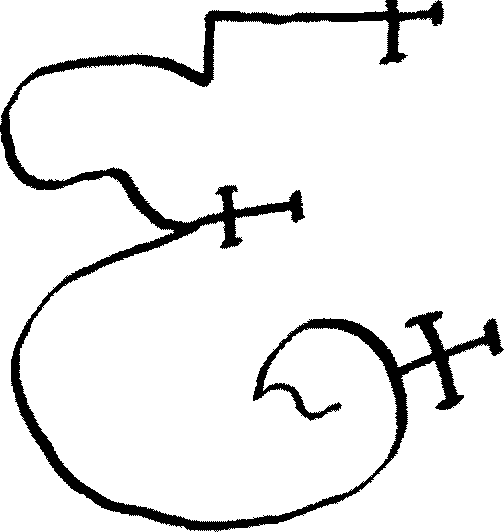
Clisthert
Silcharde, called also Sirumel or Selytarel, makes you see all sorts of natural and supernatural animals (things of whatever kind, both sentient and animate). Also said: teaches you all virtues and dispensations of diverse creatures which inhabit the world and the darkness. Honorius says of him that he cometh as a king and requires a piece of bread in sacrifice, and reveals treasures, giving him also rhe alternative name of Acham.
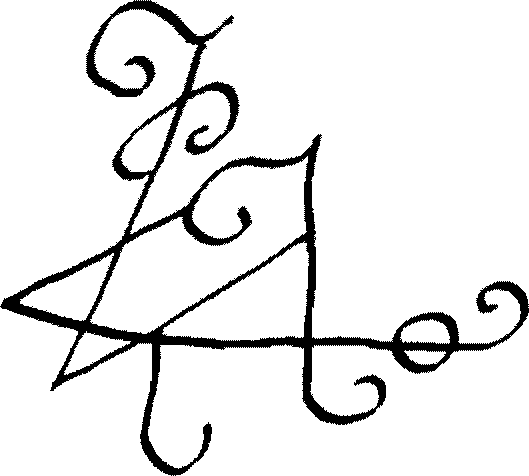
Silcharde
Hicpacth or Hiepact, called also Heporh, will make appear to you those who live in a faraway region. Will bring you such a person in an instant, though they be far away, whether it be a man or a woman, or a particular friend that you ask for.

Hicpacth
Humors, called also Humer, can bring you any book you desire.

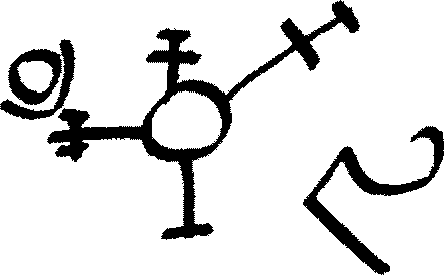

Fiumots
Segal, called also Fegor, will cause all sorts of prodigies ro appear, all such monsrers and chimeras as you may imagine.

Segal
Frucissiere, called also Frulhel or Frastiel, can bring you anyone you want whether dead or alive. Said also; revives the dead. Also said: he has the powers of infernal necromancy by the divination of dry bones.

Frucissiere
Guland, known also as Galant, can cause or heal all sicknesses, even the venereal ones. Also said: causes all illnesses. Also said: He has power to impart disease and sickness to whosoever ye wish, and to cure them if you wish. Honorius says he requires an offering of singed bread, and does whatever is commanded. He giveth him also the additional name of Nabam.

Guland
Surgat, called also Surgatha, has rhe power to open anything that is shut or locked. Also said: opens every kind of lock. Also said: imparts the skill to open locks and locked places to discover that which be within. Honorius says of him that he will ask for a hair of your head, give him one of a fox instead. Also that he reveals any treasures and surrenders them to the magician. He is dangerous, and requires a triple ring circle of evocation, fortified with divine names. He gives him also the additional name of Aquiel or Aquiot,

Morail, known also as Menailcan make you or anything invisible.
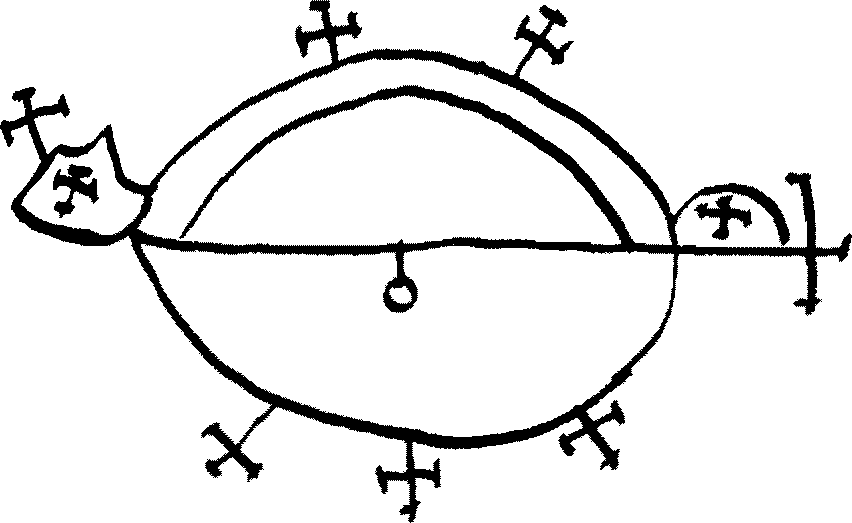
Marai!
Frutimiere, known also as Glitia, prepares all kinds of feasts and sumptuous banquets for you.

Frutimiere
Huictigaras causes sleep in the case of some and insomnia in others.


Huictigaras
Also under Satanakia and Sataniciae are forty-five demons (also said fifty-four). Hie chiefs are Sergutthy, Heramael, Trimasael and Sustugriel, known also as Sugunrh, Eramael, Irmasial and Suffugiel. The others are of no great consequence. These spirits are of great advantage, and they work well and speedily, in the case that they are pleased with the operator.
Sergutthy has power over maidens and wives, when things are favourable.
Sergutthy
Heramael teaches the art of healing, including the complete knowledge of any illness and its cure. He also makes known the virtues of plants, where they are to be found, when to pluck them, and their making into a complete cure.
Heramael
Trimasael teaches chemistry and all matters of conjuring of the nature of deceit or sleight of hand. He also teaches rhe secret of the powder of projection, by means of which the base metals may be turned into gold or silver.

Trimasael
Susrugriel teaches the art of magic. He gives familiar spirits that can be used for all purposes and he gives also Mandragores.


Agalierept and Tarihimal are also the rulers of Elelogap, who in turn governs matters connected with water.
Nebirots rules Hael and Sergulath.
Hael enables one ro speak in any language he will, and also reaches the means whereby any type of letter or characters may be written truly. He is also able ro reach those things which are most secret and hidden.



The Characters of Had
Sergulath gives every means of speculation. In addition, he instructs as to the methods of breaking the ranks and strategy of opponents.

The Characters of Sergulath
Subject to Hael and Sergulath are die eight most powerful subordi-i nates:
Proculo causes a person to sleep for 24 (otherwise 48) hours, with the knowledge of the Spheres of Sleep.
Haristum can cause anyone to pass through fire without being touched by it.
Brulefer causes a person to be loved by women.
Pentagnony gives invisibility and love of great lords.
Aglasis can carry anyone or anything anywhere in the world.
Sidragosam causes any girl to dance in the nude.
Minoson is able to make anyone win at any game.
Bucon can cause hare and spiteful jealousy between members of the opposite sexes.
Their Conjuration
Serguthy, Heramael, Trimasael, Sustugriel; Agalieraps, Tarithimal, Elgo-apa, Nebiros, Hael, and Sergulath; and you also Proculo, Haristum, Brulefer, Pentagnegni, Aglasis, Sidragosam, Minosums and Bucons, come together by the Great, Powerful and Holy Adonay, thou shaft appear, come, by the will and command of N... N... and bring all your power, place yourselves in the power of he who calls, heeding all that he desires.
Sanctus, Sanctus Regnum Verba praeterague nihil!
Omnis spintus rexurgat! Pax voluntas, fiat voluntatc mea.
THE SECOND PART
OF NATURAL AND SUPERNATURAL SECRETS
i
A Rare and Surprising Magical Secret, the Manner of Making the Mirror of Solomon, useful for all Divinations.
In the Name of the Lord, Amen. Ye shall see in this mirror anything which you may desire. In the Name of the Lord who is blessed, in the Name of the Lord. Amen.
Firstly abstain from all actions of the flesh and from sin in word or I
action during the period of rime laid down herein.
Secondly perform acts of good and piety.
Thirdly, take a plate of finest steel, burnished and slightly curved, and with the blood of a pigeon write upon it, ar the four corners these
names;
Jehova Eloym Metatron Adonay
Place the steel in a clean, white cloth. Look for the new Moon in the first hour after the Sun has set and when you see it, go to a window, look devoutly towards Heaven, and say:
O Eternal, O King Eternal! God Ineffable! Thou who hast created all things for the love of man, and by a concealed decision for the well-being of man, deign Thou to look upon me N..., who am Un-most unfit and unworthy servant and look upon this which is my intention.
Deign to send me Thine Angel Anael, upon this same mirror, he who does command and order his companions - Thy servants -whom Thou hast formed, 0 Most Powerful Lord, Who hast always been, Who art, and Who shall ever be, so that in Thy Name they may work and act with equity, giving me knowledge in everything that I shall seek to know of them.
Cast incense upon the embers of the thurible, saying three times:
In this and with this, that 1 pour before Thy Face, O God, my God, Thou Who art blessed, Three tn One and in the state of exaltation most sublime, Who sits above the Cherubim and Seraphim, Who will judge the earth by the fire, hear me!
Then breathe three times upon the surface of the mirror, and say:
Come Anael, come and let it be thy agreement to be with me willingly, in the Name Ar of the Father, the Most Puissant, tn the Name Ar of the Son, Most Wise, in the Name A1 of the Holy Spirit, the Most Living!
Come Anael, in the terrific name of Jehova! Come, Anael, by tlx power of the everliving Elohim! Come, thee, by the right arm of the mighty Metatron!
Come to me, N... (say the name again over the mirror), and order thy subjects so that they may make known to me through their love, joy and peace, the things which are hidden from my eyes.
When you have finished this, raise your eyes towards Heaven and say:
0 Most Powerful Lord, who does cause all things to more in accordance with Thy Will, listen to my prayer and may my intention be agreeable to Thee! O Lord, if it be Thy Will, deign to gaze upon this mirror and sanctify it, that Thy Servant Anael may come thereto with his companions and be agreeable to me, N..., Thy poor and bumble servant! O God, blessed and raised above all the spirits of Heaven, dhoti who livest and reignest for all time. Amen.
When this is done make rhe Sign of the Cross over yourself, and also ■ on the mirror on the first day and also on the next forty and five days. • At the end of this time, the Angel Anael will appear to you, like unto a beautiful child. He will greet you and will order his companions to obey you. It does not always rake this long to cause the Angel to appear however. He may come on rhe fourteenth day, but this will depend on the degree of application and fervour of the operator. When becomes, ask him whatever you may desire, and also beg him to come and do your will whenever you shall call him again. When you wish to call him again, after the first time, all you have to do is to perfume the mirror saying the conjurations of Anael as written above.
The License to Depart.
I thank thee, Anael, for having appeared and having fulfilled my requests. Thou mayest therefore depart in peace, and shall return when I call thee.
He perfume used in the invocation of Anael is saffron.
II
Divination by the Word of Uriel.
To succeed in this operation he who makes the experiment must do all things which are told herein. He is to choose a small room or place which for nine days or more has not been visited by women in an impure state.
This place must be well cleaned and consecrated, by means of consecrations and aspersions. In the middle of the room there is to be a table covered with a white cloth. On this is a new glass vial full of spring water, brought shortly before the operation with three small tapers made of virgin wax mixed with human fat, a piece of virgin parchment and the quill of a raven suitable for writing with an inkpot full of fresh ink, a small container of metal with materials to make hre.
You must also find a small boy of nine or ten years old who shall be well behaved and cleanly dressed. He should be near the table. A large new needle is taken and one of the three tapers is mounted upon it, six inches behind the glass. Tire other tapers should be positioned at the right and left of rhe glass, an equal distance away.
While you are doing this, say:
Gabamiah, Adonay, Agla, O Lord God of Powers, aid us!
Place the virgin parchment on the right of the glass and the pen and ink on the left. Before starting close the doors and windows. Now stir the fire and light the wax tapers. Let the boy be on his knees looking into the glass vial. He should be bareheaded and his hands joined. Now the master orders the boy to stare fixedly into the vial and, speaking softly into his right ear, he says:
The Conjuration.
Uriel, Seraph, Josata, Ablati, Agla, Caila, I beg and conjure thee by the four words that God spoke with His mouth to his servant Moses:Josta, Agla, Caila, Ablati, and by the name of the Nine Heavens in which thou livest and also by the virginity of this child who is before thee, to appear at once and visibly, to reveal dearly that truth which I desire to know. And when this is done, ; I shall discharge thee in peace and benevolence, in the Name of the : Most Holy Adonay.
J When this conjuration is finished, ask the child whether he sees any-1 thing in the vial, IF he answers that he sees an angel or other materialisation, the master of the operation shall say in a friendly tone:
Blessed Spirit, welcome. I conjure thee again, in the Name oj the Most Holy Adonay, to reveal to me immediately... (here ask the spirit what you will)
Then say to the Spirit:
If for any reason, thou dost not wish what thou sayest to be heard by others, I conjure thee to write the answer upon this virgin parchment, between this time and the morrow. Otherwise thou mayest reveal it to me in my sleep.
Ifthe Spirit answers audibly, you must listen with respect. If he does not speak, after you have repeated the supplication three times, snuff the tapers, and leave the room until the following day.
Return the next morning, and you will find the answer written on the virgin parchment, if it has not been revealed to you in the night.
-
III
Divination by the Egg.
The operation of the Egg is to know what will happen to anyone who is present during the experiment. One takes a black hen’s egg, laid in the daytime, breaks it and removes the germ. You must have a large glass, very thin and clear. Fill this with clear water and put into it the egg-germ.
Ute glass is then placed in the Sun ar midday in summer, and the Director of the Operation will recite the prayers and conjurations of the day. These prayers and conjurations are such as are found in the Key of Solomon in which we treat amply of aerial spirits.
And with the index finger agitate rhe water to make the germ turn then leave it to rest for a moment and then look at it through rhe glass, not touching it. Then you will see the answer, and it should be tried on a working day because these are spirits that will come during the times of ordinary occupations.
If one wishes to see if a boy or girl is a virgin, the germ will fall to the bottom, and if he or she is not, it will be as usual.
-
IV
To See the Spirits of the Air.
Take the brain of a cock, powder from the grave of a dead man (which touches the coffin), walnut oil and virgin wax. Make all into a mixture, wrapped in virgin parchment, on which is written the words:
Gomert, Kaiioeth
With the character of Khil.
Burn it all, and you will see prodigious things. But this experiment should be done only by those who fear nothing.
-
V
To Make a Girl Come to You, however Modest She May Be.
Experiment of a marvellous power of the Superior Intelligences. Watch for the crescent moon, and when you see it, make sure that you see also a star, between the hours of eleven and midnight. Before starting the process, do this:
Take a virgin parchment, and write on it the name of the girl whom you desire to come. The form drawn on the parchment is to be as you see in the figure below:

On the other side of the parchment, write Melchidael, Bareschas. Then put the parchment on the earth, with the part where the name of the person is written next to the ground. Place your right foot upon the parchment, and your left knee, bent, upon the ground.
Then look for the highest star in the sky, while in this position. In your right hand hold a taper of white wax, sufficiently large to burn for one hour. Then say the following Conjuration:
I salute and conjure thee, O beautiful Moon, O most beautiful Star, 0 brilliant light which I have in my hand. By the air that 1 breathe, by the breath within me, by the earth which I am touching, I conjure thee. By all the names of the spirit princes living in you. By the ineffable Name On, with which all was created! By you, O resplendent Angel Gabriel, with the Princes oj the Planet Mercury, Michael and Melchidael.
1 conjure you again, by all the Holy Names oj God, so that you may send down power to oppress, torture and harass the body and soul and the five senses of N..., she whose name is written here, so that she shall come unto me, and agree to my desires, liking nobody in the world, and especially thus N...,for so long as she shall remain unmoved by me. Let her then be tortured, made to suffer. Go then, at once! Go, Melchidael, Bareschas, Zazel, Tiriel, Malcha, and
; al! those who are with thee! I conjure you by the Great Living God to obey my will and I, N..., promise to satisfy you.
When this conjuration has been said three times place the taper to continue burning stood upon the parchment. On the next day, take the parchment, put it in your left shoe, and let it stay there until the person whom you have called comes to seek you out. In the conjuration you must say the date that she is to come and she will not be absent.
VI
To Make Oneself Invisible.
Collect seven black beans. Start the rite on the day of Mercury, before Sunrise. Then take the head of a dead man, and put one of the black beans in his mouth, two in his nostrils, two in his eyes and two in his ears. I hen make upon his head the character of Morail.
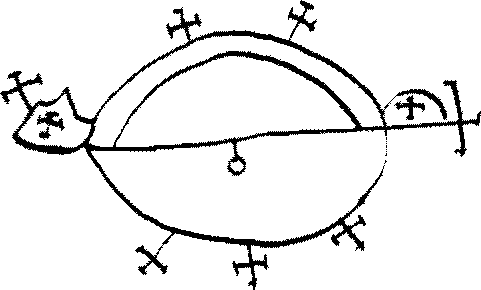
When you have done this, bury the head, with the face upwards, and for nine days, before sunrise, water it each morning with excellent brandy. On the eighth day you will find the spirit mentioned, who will say to you: What will thou? You will reply: I am watering my plant. Then the Spirit will say: Give me the bottle, I desire to water it myself. In answer, refuse him this, even though he will ask you again.
Then he will reach out with his hand and will display to you that same figure which you have drawn upon the head. Now you can be sure that it is the right spirit, the spirit of rhe head. I here is a danger that another one might want to trick you which would have evil consequences and in that case your operation would not succeed.
Then you may give him the bottle, and he will water the head and leave. On the next day, which is the ninth, when you return you will find that the beans are germinating. Take them and put them in your mouth, and look at yourself in a mirror. If you can see nothing it is well. Test the others in the same way, either in your own mouth, or in that of a child. I hose which do not confer invisibility are to be reburied with the head.
VII
To Make a Girl Dance in the Nude.
Write on virgin parchment the character of Frutimiere with the blood of a bat. Then pur it on a blessed stone, over which a Mass has been said. After this when you want to use it, place the character under the sill or threshold of a door she must pass. When she comes past; she will come in. She will undress and be completely naked and, if one does not remove the character, she will dance unceasingly until death, with grimaces and contortions which will cause more pity than desire.

VIII
To See in a Vision Anything from the Past or Future.
&

Hie two NN which you see in the second small circle mark the place where you put your name. To know what you will, write the names in the circle on virgin parchment before sleeping, and put it under your right ear on retiring, saying the following Orison:
O Glorious Name of Great God the ever-living, to whom all things are present, I am thy servant N..., Father Eternal, I beg You to send me Ihy Holy Angels who are written tn the Circle that they shall show me what I want to know, by Jesus Christ our Lord. So be it.
Having completed the Orison lie down on your right side and you will see in a dream that which you desire to know.
IX
The Curse of the Nails.
Go to a cemetery, remove nails from an old coffin saying:
Nails, I take you, so that you may serve to turn aside and cause evil to all persons whom I will. In the Name of the Father, and of the Son and of the Holy Spirit. Amen.
When you wish to use it, you must look For a footprint of your foe and making the three figures of Guland, Surgat and Morail, fix the nail in the middle, saying:
Pater vaster up to in terra.
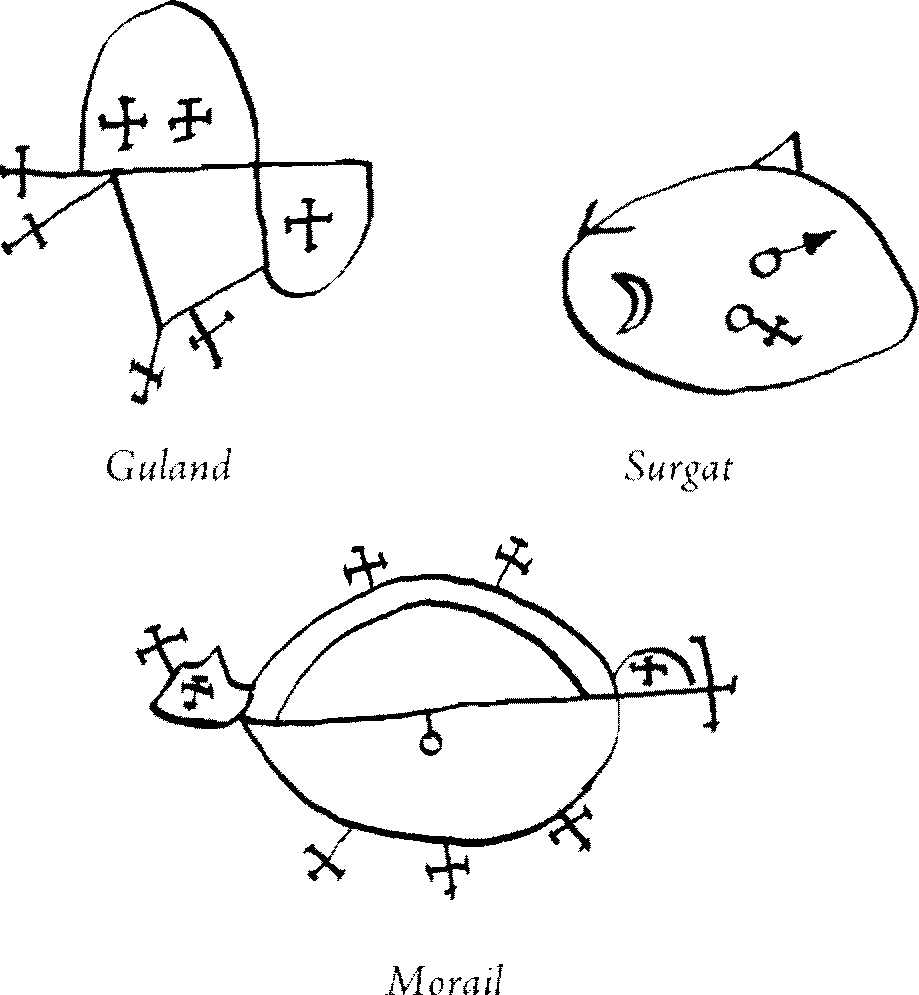
Hit the nail with a stone, saying:
Cause evil to N..., until J remove thee.
Re-cover the place with a little dust, and remember it well, because one cannot remove the evil which this causes, but by removing the nail and saying:
I remove thee, so that the evil which thou hast caused to N... shall cease. In the Name of the Father and 0/ the Son, and of the Holy Spirit. Amen.
Then take the nail out, and efface the characters: not with the same hand as you make them but with the other. Thus it will be without danger.
X
Death Spell by Magic Image.
Make a wax doll representing the person you wish to destroy, slit the head, chest and stomach and insert the sigils of Frimost, Guland and Surgat,

Frimost

Guland
Surgat
Impale the image head to foot and turn over the brazier saying:
It is not my hand which scorches thee, it is tlx hand of Frimost which scorches thee. It is not wax which I scorch, it is the head, heart and spleen of N... that I scorch.
XI
To Mutilate Enemies.
Cut a rod of virgin hazel wood with a new knife at the hour of Mercury saying:
I cut you in order to mutilate my enemies, in the Name of the Mystery of the Holy Trinity, Father, Son and Holy Spirit, and under the power of Nebtros, Ayperos, Naberus and Glassyabolas.
Cut it in three cuts then take it with you and make a figure of virgin beeswax in the hour of the planet ruling the one you wish to mutilate; write thereon with the knife his baptismal name and in the hour of Mars place it between two candles, bare your right arm and touch the figure with the rod saying:
I mutilate you for your evil doings tn the Name of the Holy Trinity, Nebtros, Ayperos, Naberus and Glassyabolas, Aroc, Baros, Beta, Bretull.
If you mutilate it three times, the person will die within a year.
XII
To Make Rain.
Take marinated (or marine, i.e. sea) water, natural or artificial, and put it in a circle which you will make on the earth, in the manner which is marked in the chapter on circles. In the middle of your circle put your Heliotrope stone and on the right put your wand marked as described above, write the sigils of Bechaud on the left side, and of Eli-ogaphatel (also called Elelogap) in the middle, and holding the wand you pronounce:
Eliogaphatel above (or in) heaven give the clouds wings that they may resolve in (befull of) water.
When these words are proclaimed rain will fall in abundance. The marinated water can also be made by taking river water and adding a little salt with a little mud, and boil it for 15 minutes on the fire whilst throwing in a little pumice stone.
XIII
To Open Anything that is Shut or Locked.
Take a lodestone and make the sign of St Andrews cross 3 times. Above the wand and around the stone make a circle, within rhe cirde make a square and at all the angles put the sigil of Surgatha and around the circle put 4 branches of the lunar plant and while holding the stone say piously in a low voice these words over it:
Beschat, Surgatha, Menaic, Remischat, Regadamer and Chtrmuts.
And afterwards cover everything with lead filings.
If you carry this lodestone on you or before you , and if you place it before all closed or locked things they will quickly open!
XIV
To Have Gold Pieces, as Many and as Often and Every Time You Want.
To have as much as you want, make as many circles or rounds of virgin parchment, prepared as previously indicated. Draw’ on each side of them the money of whatever Prince that you wish to have. 'Then make a circle on a table plus the three sigils of Chaunta, then lift all the parchments on high and say these words through rhe keyhole of your bedroom, holding the wand:
Chuanta, Ferala, Sadain, Si, Gluth, Temterans,
. Tagam, Seranna, Ferunt, Eritherem, Elibanoth, Nerohin
i Say this at nightfall and sleep for an hour on your bed, not dreaming of gold pieces, and instead of the parchments you will have real ones. One puts in the circle two characters of Chaunta, one on the upper side, the other on the lower.
XV
For Hearing a Pleasant Music.
To hear beautiful music inscribe in a circle the sigil of Klepoth, and say the u words following:
Ador, Klepoth, Chelath, Migaroth, Cabot, Silma, Sirath, Sernchiel, Rotho, Maron, Collen
And quickly afterwards you will hear pleasing music.

efore we begin rhe operations of Magic Art it is necessary to purify ourselves with the Magical Ablution, here follows the Orison of the Ablution:
Lord God Adonay, who hast made man in Time own image and resemblance out 0/ nothing! I, poor sinner that I am, beg thee to deign to bless and sanctify this water, so that it may be healthy for my body and my soul, and that all foolishness should depart from it.
Lord God, all powerful and ineffable, and who led Thy people out of the land of Egypt, and has enabled them to cross the Red Sea with dry feet! Accord me this, that I may be purified by this water of all my sins, so that I may appear innocent before Thee! Amen.
Thus purified one may commence with the manufacture of the Instruments of the Art.
The Knife
USED IN MAKING THE CIRCLE
It is necessary to have a knife made or bought on the day and hour of Jupiter with the Moon crescent. Quench it in mole’s blood and juice of pimpernel. Then recite:
The Orison of the Instrument.
I conjure thee, O form of the Instrument: by the authority of our Father God Almighty; by the virtues of Heaven and by all the Stars that rule; by the virtue oj the Angels and the virtue of the Elements; by the virtue of stones and herbs; and oj snow storms, winds and thunder; that thou now obtain all the necessary power into thyself for the perfect achievement of all our desires! And this without deception, untruth or any falsehood whatever, by God the Creator oj the Sun and Angels! Amen.
Then we recite the Seven Penitential Psalms (6, 32, 38, 51, 102, 130, 143; kjv) and afterwards the following words:
Dalmaley, Lameck, Cadat, Pancia, Velous, Merroe, Lamideck, Caldurech, Anereton, Mitraton: Most Pure Angels, be the guardians oj these instruments, they are needed for many things.
(This form may be used for the knife and lancet in their first consecration, as also for all instruments upon the altar.)
The Sacrificial Knife
USED IN SLAYING THE VICTIM OF ART
On the Day of Mars at the New Moon, make a knife of new steel strong enough to cut rhe neck of a kid at one blow and make a handle ofwood in the same day and hour and with a graver you engrave these characters:
and the sigil of Bechaud:
V
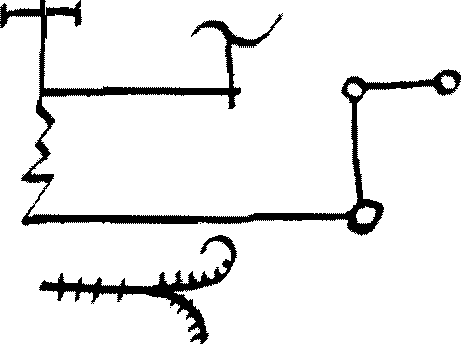
Engrave or write on the blade Agla. Then asperge and fumigate it and you have prepared an instrument for service when and where you will.
The Wands
USED IN PURIFICATION OF THE CIRCLE, AND IN INVOCATIONS
You make the Baton of Art from elder wood that has never borne fruit and cur it with a single stroke on the day and in the hour of Mercury at the Crescent Moon. And you engrave upon it the Seal of" Frimost:
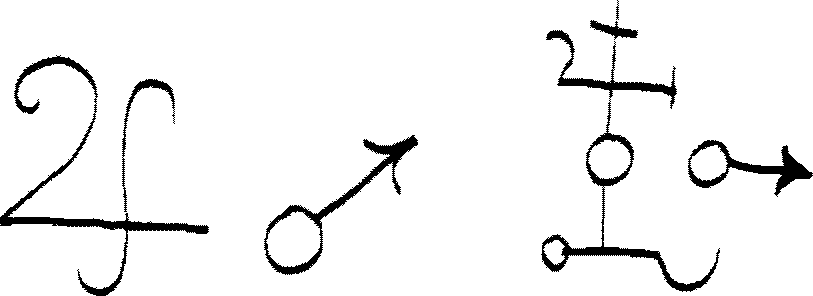
Then you make a similar rod of virgin hazel on the day and in the hour of the Sun and you engrave upon it the sigil of Klepoth:

Orison oj the Rod.
Most wise, most powerful Adonay, deign to Mess, sanctify and conserve this baton so that it may have the necessary virtue, 0 most holy Adonay, to whom be honour and glory for all time. Amen.
The Lancet
USED IN THE LETTING OF BLOOD
It is necessary to have a new lancet, conjured and prepared like the knives. Make it on the day and in the hour of Mercury, at the Crescent Moon.
The Pen, Inkhorn and Ink of Art
USED IN MAKING CHARACTERS, SIGILS AND IN THE WRITING OF
CONJURATIONS
Tike a new quill, asperge and fumigate; and when you cut its point say:
Ababaloy, Samoy, Escavor, Adon ay: I have from this quill driven out all illusions, so that it may hold within it with effectiveness the power needed for all those things which are used in the Art:for both the operations and the characters and conjurations. Amen.
Buy a new inkhorn on the day and hour of Mercury. At this time too, these characters are inscribed upon it:
Jod He Vau He •BMetatron TJod Kados T Eloym Sabaoth
Then newly made ink is exorcised with this exorcism before being placed in it:
J exorcise you, Creature of this Ink, by the Names: Anston, Cereton, Stimulator, A dona y, and by the Name of He who created all with one word, and who can achieve all so that thou
assist me in my work and so that this work may he accomplished by my desire and brought to successful end through the agreement of God, He who rules in all things, and through all things, omnipresent and eternal. Amen.
Then, after placing the ink in the horn, it is to be blessed thus:
Lord God, almighty ruler over all and/or ever, Ihoti who dost cause to take place the greatest wonders in Ihy creations, deign to grant the grace of 1 by holy spirit through this ink. Bless it and sanctify it and impart to it a special power, that whatever we may say or do or desire may be accomplished: Through 7bee, Most Holy Prince, Adonay. Amen.
Manner of Aspergation and Fumigation
Aspersions and Fumigations are necessary for every item of equipment.
First, rhe Orison of Aspergation.
In the name of the immortal God asperge N and cleanse you of all foolishness and all deceit and you will be whiter than snow, Amen.
Ihen pour blessed water thereon, saying:
In the Name of the Father and of the Son and of the Holy Spirit, Amen.
Otherwise said:
By thy name, O Omnipotent God, and by the virtuous nature you possess, Asperge and cleanse this N of all ill virtues, deceit, and foolishness and let it be pure before thee.
Then pour water upon it from the Asperser and say the second Orison:
Arise, O ye creature of the N to thy baptism of thy pure virtues and service to those operations concerning spirits.
The method of fumigation, you need a censer in which you place coals newly kindled with a new fire and let all be well ablaze. On this you place aromatics, and when perfuming the article in question, say the following:
Angels of God be our help and may our work be accomplished by you. Zalay, Salmay, Dalmay, Angrecton, Ledrion, Amisor, Buchev, Or. Great Angels: and do thou also, O Adonay, come and give to this a virtue so that this creature may gam a shape, and by this let our work be accomplished. In the name of the Father, and of the Son, and of the Holy Spirit. Amen.
Then recite rhe Seven Psalms which come after Judicium tuutn regida and Laudate Dominum omnes gentes.
Manner of Preparing
Asperger, Water and Perfumes
On the day and in the hour of Mercury, when the Moon is crescent you make an asperser. Make it big so it may hold sufficient water. It may be made of brass or earthenware, or cast in lead (in the form of a flat bottomed ladle) and varnished within and without; engrave upon it these characters:
Agfa*Jah El >?Yhvh
Recite over this the Orison of the Instrument.
Make an aspergillus from minr, marjoram and rosemary, which is bound by a thread made by a virgin maiden. To be made in the day and hour of Mercury, with the Moon crescent.
All Water used in these experiments must be asperged, by saying this over it:
Lord God, Father, all powerful, my refuge and my life, help me Holy Father for 1 love you, God of Abraham, of Isaac, of Jacob, of the Angels, of the Archangels and Prophets, Creator of AIL In humility, and calling upon Thy Holy Name, I supplicate that thou wilt agree to bless this water so that it may sanctify our bodies and our souls, through Thee, most holy Adonay, Everlasting Ruler. Amen.
The perfumes for the instruments are of aloes, frankincense and mace.
The perfume for the circle before you enter therein is musk, amber, aloes wood and frankincense.
The perfume for inside the circle is mace alone.
The perfume for the spirits is frankincense alone.
Over the perfumes is said this Orison:
Deign oh Lord to bless the creature of this perfume, in order that it may be a remedy for the human race, and that it may be a remedy for our souls and bodies, through the invoking of thy holy name' Agree that all creatures which may breathe tn the vapours of this may have wealth of their bodies and souls: Through the Lord who has fashioned the time eternal! Amen.
Of the Virgin Parchment
This can be made in many ways. Generally it is made of the skin of a goat or lamb, or other animal, which must be virgin. Remember that when you make the Sacrifice in order to obtain the Virgin Parchment from the kid, all the instruments must be on the altar. Take your goat and place it on a flat surface, so that the throat is uppermost, the better to cut it. Take your knife and cut the throat with a single stroke, while pronouncing rhe name of rhe Spirit that you wish to invoke. For example, you say:
1 kill you in the Name anil to the Honour of N (name of spirit).
This is to be well understood and take care that you sever the throat at first, and do not take two strokes, but see that he dies at the first. Then you skin him with rhe knife and ar the skinning make this invocation:
Adonay, Dalmay, Lauday, Tetragrammaton, Anerton; and all you, Holy Angels of God come and be here and deign to infuse into this skin the power that it may be correctly preserved so that all that is written upon it may become perfected.
After the skinning take well ground salt and strew this upon rhe skin, which has been stretched, and let the salt cover rhe skin well. Before you use the salt it must have this benediction said over it:
Benediction of the Salt.
1 exorcise you, O Creature of the Salt, by the God who is living, the God of all Gods, the Lord of all Lords, that all fantasies may leave you and that you may be suitable for the virgin parchment.
When this is finished, let the skin with the salt upon it remain in the Sun for a full day. Then obtain a glazed pottery jar, and write upon it these characters with the Pen of the Art:

Or as others say, the characters of Guland and Surgat:
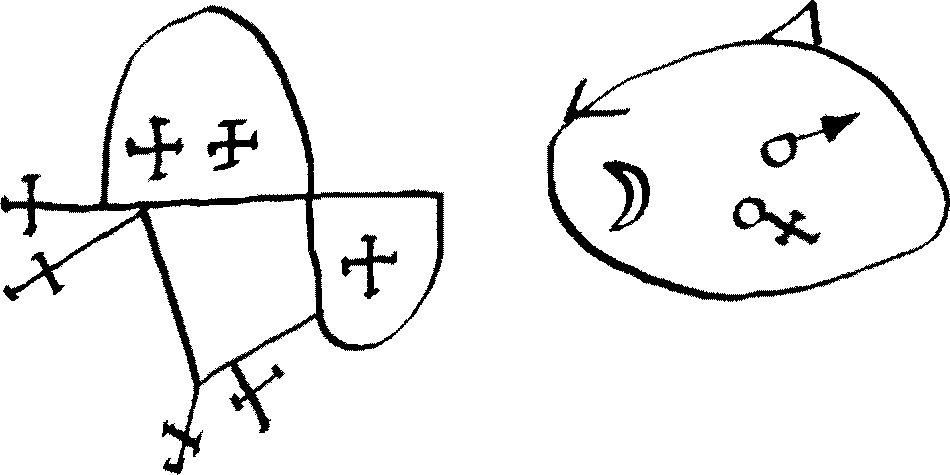
Get quicklime and slake this with exorcised water, and put these in the jar. When it is liquid place in it your goatskin and leave it long enough for the hairs to peel off of themselves. As soon as the hair is in such a condition as to come off with a touch remove it from the jar and peel the hairs with a knife made from carved hazel. The knife must have these words said over it:
O holiest Aboezra (or Adonay) put into this wood the power to cleanse this skin, through thy holy name Agason. Amen.
The skin when peeled may be stretched over a piece of new wood, and stones from the side of a river are laid on it so that they hold it down, say this orison over them:
Orison of the Stones.
0 Adonay, most puissant and most powerful Lord, allow that these stones may stretch this skin and remove from them all wickedness, so that they may possess the required power. Amen.
The skin is allowed to dry after this, and before quitting the spot say over the parchment:
Je, Agla, Jod, Hot, He, Emmanuel! Stand guard over this parchment, in order that no spectre may take charge of it!
When dry it is removed from its wooden frame, blessed and fumigated, then it is ready for use. It is important no woman sees it, especially in her monthly courses, lest it lose its power. Also you must be dean, pure and chaste. The operator is to say one Mass of the Nativity then and all instruments are to be on the altar.
Another means of the same:
Take parchment or paper of good quality and conjure, asperge and fumigate it as you did the other instruments.
Preparations for the ritual.
When the implements are ready, rhe operator must prepare himself. This is first done by performing this Preparatory Orison:
Lord God Adonay, who hast formed man in Thine Image, I, the unworthy and sinful, beseech Thee to sanctify this water, to benefit my body and soul, cause me to be cleansed.
As you say this you are to wash thy face and hands with the water you are blessing. It is necessary to wash the hands and feet and know this also, and know and know again, that it is necessary and most necessary to abstain three days from sin and above all mortally, however much the human frailty may' be, and especially guard your chastity.
During rhe three days study the book and during this time pray five times during the day and four times each night — or as others say, at Sunrise once, at Three hours after twice, at Midday three timesit three hours after four times, ar Sunset five times, and six times before going to rest:
The Prayer.
Astrachios, Asac, Asacra Bedrimulael, Silat, Arabo.nas, Jerahlem, Ideodoc, Archarzel, Zophiel, Blavtel, Baracata, Adonai, Elohim, Emagro, Abrac ateh, Samoel, Geburahel, Cadato, Era, Elohi, Achsah, Ebmisha, Imachadel, Daniel, Dama, Elamos, Izachel, Bael. Scirlin; Genium Domosi
O Lord God, Who art seated above the heavens and Who re-gardest the Abysses beneath, grant unto me Thy Grace 1 beseech Thee so that what I conceive in my mind, I may accomplish in my work: through Thee O God, the Sovereign Ruler of All, Who liveth and reigneth unto the Ages of the Ages. Amen.
This having been accomplished correctly all that remains is to follow your invocations and draw your characters and you do as follows.
The Character of Scirlin and the Conjurations
In the day and hour of Mars, the Moon being at the crescent, and at the first hour of the day - which is a quarter of an hour before Sunrise - you will prepare a piece of virgin parchment, which shall contain all the characters and the invocations of the spirits which you wish to produce.
In the said day and hour you will attach to the small finger, which is that of Mercury, a thread spun by a virgin girl and pierce the finger with the lancet of the Art, to get blood from it, with which you will form your Scirlin character.
Bit

Seytt'TLtTian.
The Character of Scirlin
Orient
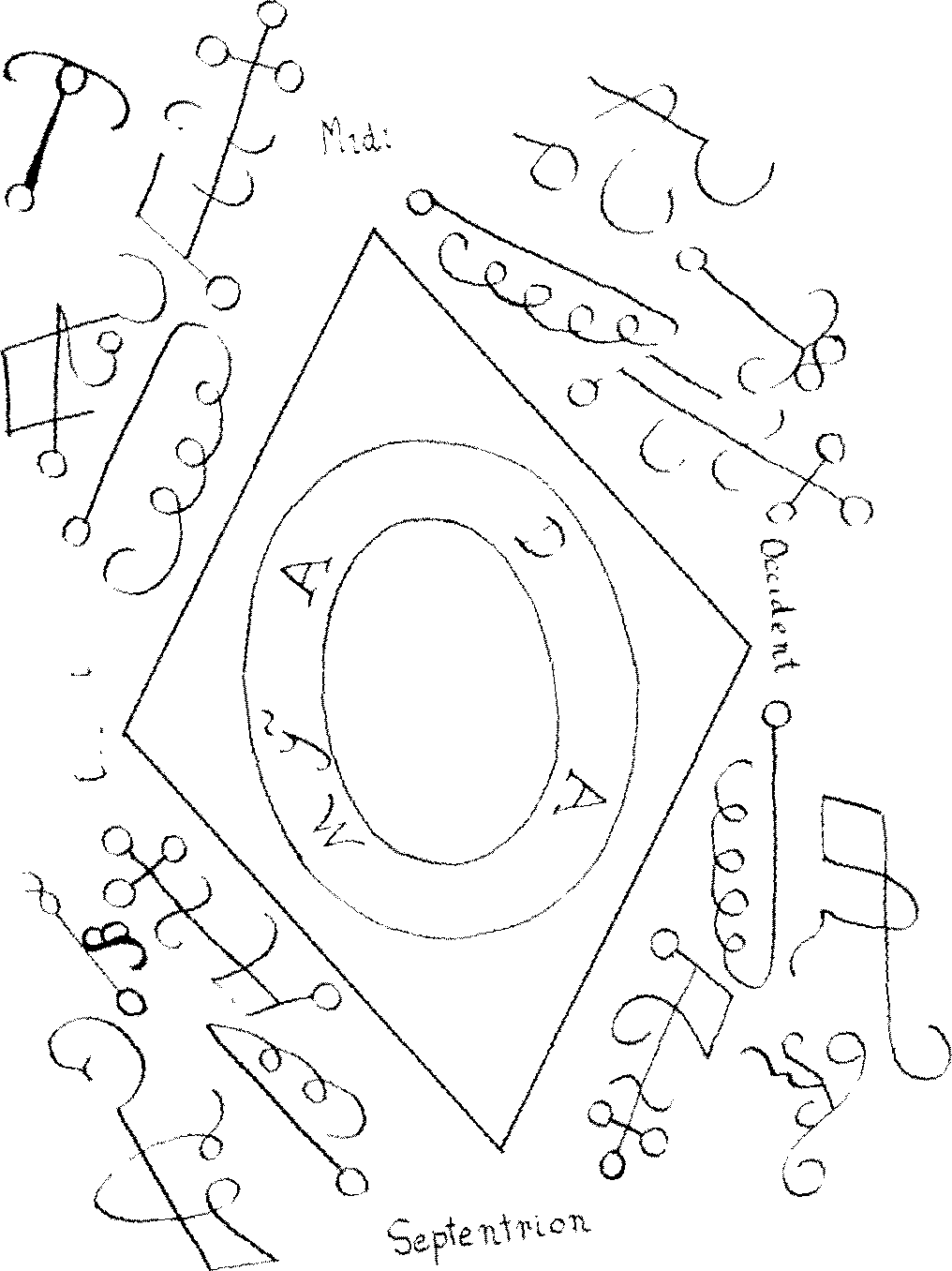
Then write his invocation above, which is that which follows:
Heloy •? Tau tb Varaf T* Panthon
Hominorcum Elemiath >1- Serugeath ►b Agfa ►b On
■E Tetragrammaton T1 Casily
Then you must write the first letter of your name where is the letter A, and that of your surname where is the letter D. The spirit Scirlin, whose character this is, is very potent to render you service and cause you to have power over the other spirits. This invocation causes the intermediary Scirlin to come. It is Scirlin who bringeth all the others to your conversation. For from this sigil depend all the others and it can constrain them to appear in spite of themselves as he has the power of the Emperor and is ready to serve him who giveth a sacrifice, is it is said, that it is important that these creatures be content on their own parr else they will do you no service.
Below this make the character of the Spirit(s) that you desire to come, and burn incense in his honour. Then write the invocation of the Spirit that you wish to cause to appear, and again burn incense in his honour. Say as you do:
J burn this N, in the name and to the honour of N
Naming the spirit you intend to invoke.
Conjuration for Lucifer
Lucifer, Ouyar, Chameron, Aliseon, Mandousin, Premy, Octet, Naydrus, Esmony, Eperinesont, Estiot, Dumosson, Danochar, Casmiel, Hayras, Fahelleronthou, Sodirno, Peaham, Come, Lucifer ■L Amen
Conjuration for Belzebuth
Belzebuth, Lucifer, Madilon, Solymo, Saroy, Theu, Ameclo, Sagrael. Praredun, Adricanorum, Martino, Timo, Cameron, Phorsy, Metosite, Prumosy, Dumaso, Elivisa, Alphrots, Fubentroty, Come, Belzebuth, >x’ Amen d?
Conjuration for Astaroth
Astaroth, Ador, Cameso, Valuerituf, Mareso, Lodir, Cadomir, Aluiel, Calniso, Tely, Plorim, Viordy, Cureviorbas, Cameron, Vesturiel, Vulnavij, Benez meus Calmiron, Hoard, Elisa Chenibranbo Calevodium, Brazo Tabrasol, Come, Astaroth, v Amen d?
After having said seven times the conjuration addressed to superior spirits, you will see the spirit at once appear, to do whatever you desire. When you have seen the Spirit, being satisfied, you can dismiss him by saying this:
The License to Depart (in no wise to be omitted!).
Ite tn pace ad loca vestra et pax sit inter vos redituri ad mecum voj invocavero, in nomine Patris de et Filii d? et Spiritus Sancti d1 Amen.
Conjuration of Subordinate Spirits
Osurmy "x* Delmusan Atalsloym ’J’ Charusihoa Melany ►F Liamintho A' Colehon ►P Paron Madoin d? Merloy •i* Bulerator *f* Donmedo Hone •i- Peloym >%• [basil A Meon ►r Alymdrictels Person Crisolsay ’J' Lemon Sessle Nidar Horiel Peunt ►J1 Halmon Asophiel >F Ilnostreon ►J* Baniel ’■P Vermias ►F Slevor
Noelma ►I’ Dorsamot •F Lhavala Omor Ar Framgam
>1“ Beldor ►£* Dramgin ►P Come, N.
Another Conjuration, for Inferior Spirits
I conjure thee, N..., by the Name of the Great Living God, Sovereign Creator of all things, that thou appear in human form, fair and agreeable, without noise orjear, to answer truthfully to all the questions that I shall ask. I conjure thee to do this by the power of the Holy and Sacred Names of Adonay, El, Elohim.
Dismissal of the Inferior Spirit.
Go in peace, N..., whence you came, peace be with you and come every time I shall call you. In the Name of the Father A and of the Son ’I* and of the Holy Spirit *1* Amen.
The Ritual
When you make your circle, before entering therein, it is perfumed with musk, amber, aloes wood and incense. When all is ready stand inside the circle and make ready the censer. If you have companions with you, they are to hold a hand one of the other. When inside trace the form of the circle with the knife of Art; characters are to be written at the four corners of the circle, generally four pentacles of Solomon, one at each point of the compass. I have put here the form of the Pentacle of Solomon so that you may make these arrangements, as they are of great importance.

The Pentacle of Solomon
Then pick up the wands, one after the other, reciting the fifty-first psalm.
-
i: Have mercy upon me, O God, according to thy loving kindness: according unto the multitude of thy tender mercies blot out my transgressions.
-
2: Wash me thoroughly from mine iniquity, and cleanse mejrom my sin.
-
3: For I acknowledge my transgressions: and my sin is ever before me.
-
4: Against thee, thee only, have 1 sinned and done this evil in thy sight: that thou mightest be justified when thou speakest and be clear when thou judgest.
-
5: Behold, I was shapen in iniquity; and tn sin did my mother conceive me.
-
6: Behold, thou destrest truth in the inward parts and in the hidden part thou shall make me to know wisdom.
T- Purge me with hyssop, and I shall be clean; wash me, and I shall be whiter than snow.
-
& Make me to hear joy and gladness; that the bones, which thou hast broken may rejoice.
-
9: Hide thy face from my sins and blot out all mine iniquities.
-
10: Create in me a clean heart, O God; and renew a right spirit within me.
-
11: Cast me not away from thy presence; and take not thy holy spirit from me.
-
12: Restore unto me the joy of thy salvation; and uphold me with thy free spirit.
-
13: Then will I teach transgressors thy ways; and sinners shall be converted unto thee.
-
14: Deliver me from blood guiltiness, O God, thou God of my salvation: and my tongue shall sing aloud of thy righteousness.
-
15: () Lord, open thou my lips; and my mouth shall shew forth thy praise.
-
16: For thou desirest not sacrifice; else would I give it: thou delightest not tn burnt offering.
-
17: The sacrifices of God are a broken spirit: a broken and a contrite heart, O God, thou wilt not despise.
-
18: Do good in thy good pleasure unto Zion: build thou the walls
of Jerusalem.
-
19: Then shalt thou be pleased with the sacrifices of righteousness, with burnt offering and whole burnt offering: then shall they offer bullocks upon thine altar.
Then perfume the circle with mace, and sprinkle it with holy water as is taught in the chapter on the Manner of Aspergation and Fumigation:
In the name of the immortal God asperge this Circle... in the Name of the Father and off the Son and of the Holy Spirit, Angels off God... With the psalms.
Prohibit the Spirit specifically from entering into the precincts of the Circle.
When invoking, you must hold the invocation in your left hand and in the right the rod of elder. Then the invocations are to be repeated seven times. Place incense on the fire saying:
1 burn this N, in the name and to the honour oj N.
Naming the spirit invoked.
Make him sign the character, which you are holding in your hand, which promises that he will come whenever you may call him. Ask for what you think is needed and he will give it to you.
Then recite the License to Depart.
Go in peace to your own place, and peace be with you, until I shall invoke you again. In the name of the Father •F and of the Son and oj the Holy Spirit T1 Amen.
Here endeth The Grimorium Verum.
THECABALA OF THE GREEN B VTTERFLY
*.x
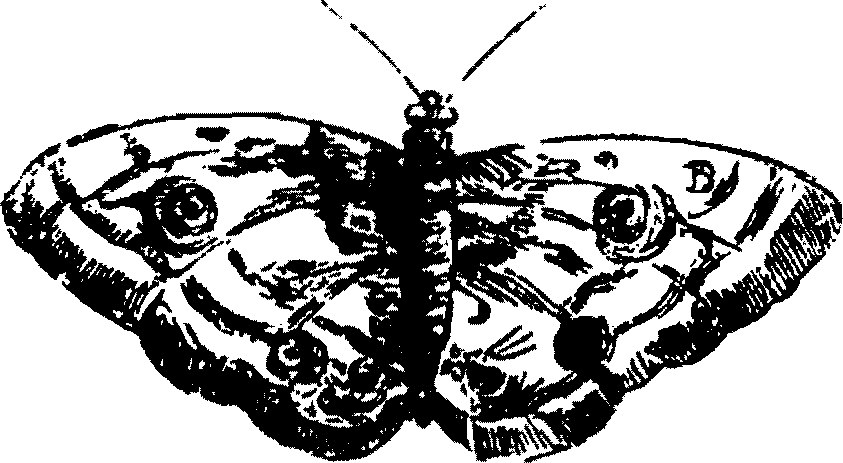
A COLLECTION OF C VR1O VS SECRETS

n the year of the world 3087, Sesac, King of Egypt, received a message and gift from his friend, a famous Necromancer. It was a Box fashioned of a solar (possibly a
single) diamond, that had locked within it was a Secret on which all goodness depended, Tlte key to it was supplied, but with strict instructions only to open it a year after.
Sesac, obliged to leave to combat Egypt's enemies, departed after he had entrusted to his wife this precious Box, carrying off rhe key that was lost with him. All means were tried in order to open the Box without breaking it, but always in vain. And since it was of great value, it was in turn made a present to the Emperor of China, and remained in his family: until in 1607 it was pounced upon by a Jew in the service of the Court and conveyed to Europe. In an attempt to uncover the means taken to seal the Box, the Hebrew broke it off, and with this the following Cabala was recovered.
In the month of May, June, or July, towards noon, you go to the forest closest to your house, and say the Prayer of the Salamanders. Find the largest tree of the forest, climb up, and cut from it a new branch with one blow. When you come to the part of the operation concerning the Butterfly with wings green as the hills; you will take one, the largest one if you can, and fashion for it a small box of virgin wood.
Return to your house, ignite a beautiful fire with alder wood, casting three litres of aqua-vitae over it; little by little, be watchful of the flame; take care with the sprinkled liquor. And when the fire is finally extinguished, you place the Box in the ash for 38 hours and after this retirement you carry it to the Parish Church to put the Box under the great candlestick of the Altar, Hie next day you will go to take the Mass, and will mentally make one general Confession. On your chosen day, towards midnight you will lock yourself in your room. Having made the call that you will find in the true book the Red Dragon then Astaroth will appear to you in the form that you command, and you ask your orders, which will be agreed without retort, and you will be able to demand whatever you will.
As an example it will be able to tell you:
-
I. How to discover all the Treasures to you hidden for ten leagues around.
-
2. It makes you to know the woman that you will marry, or the husband, if you are a woman.
-
3. Of telling at what age you will marry.
-
4. Of conducting to your room the person whom you wish.
-
5. To know the most hidden Secrets of Nature.
-
6. To bring one sufficient sum to you for living the rest of your days.
-
7. To indicate to you such remedies of disease, as will be convenient in all ways.
-
8. To remove from your fields and your house the hurricane, the animals curses and all that that will be able to harmful to your interests.
-
9. To declare which to you they are your enemies, or friends.
-
10. To transport to you in that part that seems and appeals to you.
-
n. To indicate to you a month before the numbers that they will draw, to the Lottery.
-
12. Of those who give the power to you to render you invisible,
-
13. To render the Judges favourable to you, yes, that nobody can speak badly about you.
-
14. It makes you to win, finally, in every game of chance, rendering you happy in all and for all!
The way to get hold of the Green Butterfly
In order to take the Green Butterfly arm yourself with such a net that servants commonly employ in order to bring the Butterflies to us; of rhe width of two palms and three deep, with a handle two meters long, and lurk within some deep flowers. You will see that rhe Butterfly will not lack to come to rest on the flowers, and therefore will remain in your power.
Prayer of the Salamanders
Immortal, Eternal, Ineffable and Uncreated Father of All, borne upon the Chariot of Worlds, which ever roll in ceaseless motion; Ruler over the Ethereal Vastness, where the Throne of Thy Power is upraised, from the summit of which Thine eyes behold all, and Thy pure and Holy ears hear all, hear Thou Thy children, whom thou hast loveJ since before the Ages began. Thy Majesty Golden, Vast and Eternal, shineth above the Heaven of Stars! Above them art Thou exalted, O Thou Flashing Fire! There Thou illummateth all things with Thine insupportable Glory, whence flow the ceaseless streams of splendour which nourish Thine Infinite Spirit. Tins in-Juiite Spirit nourished) all, and maketh that inexhaustible treasure of generation which ever encompasseth Thee, replete with the numberless forms wherewith Thou hast filled it from the beginning. From this Spirit arise those most Holy Kings, who surround thy Throne and who compose Thy court. O Universal Father! One and Alone! Father alike of Immortals and of Mortals! Thou hast created Powers marvellously like unto Thy thought Eternal and unto Thy venerable Essence. Thou hast established them above the Angels who announce Thy Will to the World. Lastly, thou hast created us third tn rank within our Elemental Empire! There our continual exercise is to praise and to adore Thy desires! There tve ceaselessly burn with Eternal Aspiration unto Thee! O Father! O Mother of Mothers, O Archetype Eternal of Maternity and of Love! O Son, the flower of all Sons! O form of all forms, Soul, Spirit, Harmony and Humeral of all Things! Amen.
NOTES TO THE GRIMOIRE
Hhe True Grimoire: this title is the literal translation of the Grimorium Verum. I he actual meaning of the title is that the Grimoire is the authentic Key or Clavicle of Solomon. The later French and Italian versions bear the name The True Key(s) oj Solomon, and ig'1’ century authors frequently cite Verum when speaking of The Key of Solomon, plainly considering the one to be identical with the other.
The First Part
The blood of a sea turtle:
At first glance it seems possible a turtle-dove was originally intended. However, both the French and Italian editions speak of a tortoise of the sea, while English editions alone replace this with sea-turtle. Not only is this a tautology in English, as turtles are by definition marine creatures, but from 1678 the English expression’sea-turtle has referred to a sea bird known as the Black Guillemot! In the French language tortoise of the water' means turtle and’tortoise of the land’ means tortoise. Italian on the other hand has separate words for these two creatures, as does English. This is another indication of a French text preceding the Italian. (It is interesting to note that the offerings made inSanteria to the Orisha Eleggua - known as Exu in Brazil - include turtle. This offering specifically requires an experienced Santero or a Babalawo). The tortoise is also sacred to Hermes.
This character should be made:
The character given, and the variant that follows it, are taken from Liber Trmsieme and the Grimoire of Armadel. In the texts of the True Grimoire the figure is either omitted or the same as the character of
Scirlin. Joseph Peterson has shown the Scirlin character to have originated in a procedure For consecrating magical rings. It would also be quite impractical to engrave rhe large and complex Scirlin figure on a ruby. However, while these two figures are undoubtedly appropriate as substitutions in this part of the text, as regards the Scirlin figure that follows later, I do not consider these substitutions appropriate, regardless of its origins. The first character and the character of Scirlin plainly serve different roles, making the approach given the simplest and most consistent with Verum texts. The apparent complexities of rhe Scirlin character’s origins arc not beyond resolving. The ring-consecration idea could be extended to the pendant bearing the first character, suggesting it be placed upon rhe Scirlin figure when commencing the conjurations.
Oh an emerald or ruby:
Emerald usually corresponds to Venus, ruby to the Sun. ArmiiL! Liber Troisieme adds another solar stone, heliotrope, which is also the stone used in forming a pact in the Grand Grimoire. Heliotrope, or bloodstone, has a distinguished occult history that may be significant here. The Book oj Secrets attributed to Albertus Magnus says, the necromancers call it Gemma Babylonica”. His necromancers are in fact identical with the Magi, or Babylonian priest magicians mentioned by Pliny on the subject of the same stone. Jn his account the magicians claimed that the stone heliotrope combined with the plant of rhe same name conferred invisibility. In shamanic terms invisibility is the power to move unimpeded in the world of spirits. Bloodstone i was also believed to confer long life and fame.
The Spirit of the East: >
Judging from textual indications this is Duke Syrach. Implications • within Verum identify all of his spirits as Eastern and of the nature : of Fire; and this fiery nature is also implied for some ar least among the chiefs and their deputies. The idea of Chiefs or Kings of spirits of a particular element, attributed to a particular direction is common in the grimoires as a genre.
These Four Kings, who appear with various names and attributed in diverse ways in a great many sources, deserve some attempt at clarification here. According to the Goetia of Solomon, probably sourced from Scot’s Discovers’ of Witchcraft, they are Amaymon in the East, Corson or Gorson in the South, Zimimay or Ziminiar in the North and Goap or Gaap in the West. Mathers’ note on this is that Oriens or Uriens, Paymon, Ariton or Egin and Amaymon are more commonly found; Crowley's 777 follows this attribution. Both are probably preferring Abramelin as an authority, with Mathers only adding that Ariton is also called Egin in other sources. Somewhat problematically, given this supposed authority, is the fact that Abramelin does not give an attribution to the directions, elements or seasons, and also has these spirits apparently below four more (giving a total of eight sub-Princes in all): Astarot, Magot, Asmodee, Belzebud over Oriens, Paimon, Ariton and Amaimon. Note that in Weyer, Scot and the Goetia Asmodee is under Amaymon, which doesn’t apply here apparently! Mathers adds that the four are named Samael, Azazel, Azael, and Mahazael by 'Rabbinical writers', but this supposed equivalence is doubtful. Agrippa, while attributing both groups to rhe infernal realm clearly distinguishes them, saying Oriens &c. are Princes of spirits of the directions, while Samael and company are devils offensive in the elements. One thing is obvious in this muddle, if one of these Kings is called Oriens he must be attributed to the East, at least when using that name.
An important form of the Key of Solomon - that given by Abognazar - calls the Four Kings, ’Princes of the Spirits of rhe Four Seasons’ namely: Aeriens (perhaps spirits of the higher air, or Salamanders?), Sylphs, Nymphs (Undines) and Pigmies (Gnomes or Dwarves), The names of the Kings are Moimon, Boel, Paimon and Egm. Abognazar’s attribution is a little muddled, but very close to Agrippa, who gives East and Fire to Oriens, Air and West to Pay-mon, Water and North to Egyn, and Earth and South to Amaymon. Comparing this with Abognazar’s list, we can deduce that Oriens is a title of Baal. Abognazar’s direct source is a valuable 17th century synthesis of occult symbolism known as the Magical Calendar, which
drew upon Agrippa and other material. Here rhe order of names of the ’Principal Spirits in the Four Parts of the World' is Bael, Moy-mon, Poymon and Egin. They rule over the Sylphs, Aerei, Nymphs and Pigmies, corresponding to Fire, Air, Water and Earth. Here too the attribution is evidently slightly muddled. Adam McLean notes that the Magical Calendar omits material from Agrippa concerning the infernal realm, being a synthesis of’white magic’; so the inclusion of these spirits points to a different understanding. Robert Fludd’s Medica Cathohca appeared nine years after the Calendar; it lists as chiefs in rhe four directions Oriens, Amaymon, Paymon and Egyn, for East, South, West and North. Curiously, it attributes as 'hosts' under them not the Salamanders, Nymphs and so forth but Samael, Azazel, Azael and Mahazel. It is apparent from this that included by the Goetia among its subordinate spirits are several that in other grimoires are the Four Kings set over them. This is clearest with Bael in particular: ’their first and principal king which is of the power of the East’. It is also obvious that, despite the opinion expressed by Mathers, they are not directly equivalent to Samael, zXzazel &c. It is important to note that the name Boel appears, connected with fire, in the Magical Papyri, (see note on The Mirror of Solomon); with some differences in spelling he also appears as an Angel in Arab and Byzantine magical handbooks. Spirits serving double roles, though often glossed over by many commentators, are far from unusual in magical literature. An early example occurs in the Testament of Solomon where we find both ’good’ and ’evil’ forms of Astarte: as Artemis she personifies evil pagan goddesses, while as Asteraoth she is an angel defending from demons. A striking incidence of this tendency appears in a Byzantine text, where the Angel of Saturday is given as Beel, while the Demon of the same day is Zeboul; a combination of these names gives us Beelzeboul.
Finally, the Grimoire of Honorius gives: East to Magoa, South to Egym, West to Baymon and North to Amaymon. Now in some attributions Amaymon as an Earth spirit would suit the North, which also has dark associations. Magoa in rhe East, very like Magot, connects with the word Magus and appears to be another title like
Oriens. It is significant that Honorius includes a separate invocation
for each King. As regards clarity of attribution however, Honorius -never particularly reliable - only adds confusion.
M |
A |
G |
0 |
T |
A |
R |
A |
T |
O |
G |
A |
L |
A |
G |
O |
T |
A |
R |
A |
T |
O |
Cj |
A |
M |
By preferring Agrippa’s attribution as the oldest, clearest and most reputable source, and rationalising rhe names and Elemental types, we get:
Anes=East/Fire, Salamanders: Bael, aka Oriens, and likely Magoa.
Capricorn=South/Earth, Gnomes: Amaymon.
Lfora=West/Air, Sylphs: Paymon.
CaMter=North/Water, Undines: Ariton aka Egin, and Gaap or Goap.
A |
R |
I |
T |
0 |
N |
R |
O |
C |
A |
R |
0 |
1 |
c |
L |
0 |
A |
T |
T |
A |
0 |
L |
0 |
1 |
O |
R |
A |
C |
0 |
R |
N |
O |
T |
I |
R |
A |
Singambuth and Aabidandes:
Neither of the spirits named in this difficult passage are mentioned again under those names, though this does not aftect the practicalities of the initial operations. It can be postulated that they are to be identified with Surgulath and Hael, Hael's ability to write any kind of characters and compose any manner of document being the primary consideration.
The more obscure and difficult things... are to be examined by Rabinadas:
In other words, let them be explained by dealing with the appropriate spirit, see previous note.
Nature of pacts:
The idea of two forms of pact, tacit and apparent, originates with Gril-landus in 1525 in which he is followed by Gnazzo in 1608. Both apply the term to witches relations with the devil. The idea of the pact itself is extremely ancient. Circumcision among the Jews is the mark of a covenant or pact with Jehovah; agreements with gods other than him are attacked in Isaiah 28.15:
We have a covenant with death, and with hell are tve at agreement.
I’he early depiction of the pact in Christian theology refers to pagan relations with their gods, either in magic or religion. This is the core of the concept as it appears both in later theology and in the grimoires. In fact, written contracts with the gods were made by Egyptians of the late first millennium BC, offering, for example permanent service in a temple in exchange for protection from ill fortune and malevolent spirits. The early Christian theologian, Origen, who lived in Egypt 185 to 254 ad, speaks of the use of divination and charms as automatically involving pacts with demons, in which he is followed by St, Thomas Aquinas in the Middle Ages. Sr. Augustine also speaks of a false pact of deceitful friendship’ between men and demons, by which he means rhe gods and spirits of late paganism. It is certainly signifi
cant that among the foremost pagan cults competing with early Christianity'was that of Mithras, whose very name means 'agreement or covenant', and who was among other things a god of friendship. Significantly, the words 'pact' and 'conjure' both involve a sworn agreement by two or more parties.
Tlx titles of the superiors:
This has been given in several texts as ’names’, whereas it is more correct to read ’titles’. Omitted from some texts of Verum is the following:
Lucijer Belzebuth Astaroth Imperator Principit Comes
Tres Spiritus omnia possunt
Ignoring the lack of punctuation, which has occasionally led to different interpretations (and probably the aforementioned omissions), this gives the ’three spirits over all’ their own distinct titles: Emperor, Prince and Count. The last of these titles has more than one possible interpretation, due to differences of feudal rankings in different European nations, nor readily' appreciated in modern rimes or in Republics! It is generally translated Duke, as in English this is the next rank below Prince; Earl is also occasionally found. The Grand Grimoire and Red Dragon follow this scale of ranking fairly meticulously; in addition some Grund Grimoire references give the titles as Emperor, Prince and Grand Duke, which usefully distinguishes Aslaroth as a chief from rhe many Dukes in other grimoires. Following Weyer, Scot and the Goetia these three ranks are commonly associated with the Sun, Jupiter and Venus respectively. The trinity of Lucifer, Belzebuth and Astarorh could thus equate with a pagan Underworld trinity: with Lucifer perhaps a Promethean Hermes figure, plus Baal and Astarte. Incidentally, on the subject of ranks among spirits, the translation of Weyer used in Scot (and influencing the Goetia) gives only one Knight, a rather top heavy arrangement. This is usefully explained by Br. Nicholson’s sadly neglected commentary, where he explains that rhe words miles and milites, are inexplicably translated from
the Latin as 'soldier' in several cases, and as ’knight’ in others. Any spirit described as like a soldier can be read as additional knights, as can those who appear as knights.
Satanakia:
Variant Satanachia and Put Satanachia, probably also identical with Sataniciae &c.
Agalierap:
Variants Agliarept, Agliareps &c.
Tarchimache:
Variants Tarcgimache, Tarchimache &c.
Fleruty:
Variants Fleuretty, Fleurity &c.
Sagatana:
Variants Sagathana, Sargatanas &c.
Nebiros:
Variants, Nesbiros, Nebirots &c.
Regarding the powers of these spirits, Verum gives no details, but according to the Grand Grimoire:
Satanakia subjects girls and women to himself, and to do his wishes.
Agliareps discovers the Secrets of any heart, and the studies and councils of the world, unveils the greatest mysteries.
Although its upper hierarchy is all but identical to that of Verum, the Grand Grimoire does nor mention Tarchimache by name, giving an
other name entirely. This substitute or equivalent spirit, Lucifuge Rofocale, ’has the power bestowed on him by Lucifer over all riches and all the treasures of the earth'. According to Symons peculiar version of Verum,’Tarchimache dispenses to you the powers to gain control of water', probably the editor means that Tarchimache (alias Tarihimal, co-ruler of Elelogap) gives access to the watery power of Elelogap.
Fleruty can perform any work one wishes during the night, and cause hailstones in any required place.
Sagatana (variants Sargatanas, Sayathana, Sargatanas) imparts invisibility, transportation, opens locks, makes visible all that occurs in houses, teaches all the tricks and subtleties of the Shepherds.
Possibly this last somewhat cryptic reference is to the knowledge, real or imputed, of country people, but it may indicate something subtler and Arcadian.
Nebiros can do evil to whomsoever he wishes, make known or cause to be found the Hand of Glory, and the qualities of metals, minerals, vegetables and animals pure and impure, and prediction - especially by necromancy, he goes to and fro everywhere and inspects all the infernal legions.
The Hand of Glory or Mam de Gloire is, at first glance, a gruesome item of medieval belief. Different accounts of its manufacture and use are to be found in the sources. A classic description says it was made from the severed hand of an executed criminal. This body was to be still hanging upon a gibbet, which were frequently situated at a crossroads. This was to be dried for two weeks in an earthenware pot, with salt, pepper and saltpetre. It was subsequently shrivelled in the sun; and then further dried in an oven fired with verbena and fern. After this triple process it was fitted with a black candle of human fat and
beeswax having a wick of hangman’s rope. In the earlier medieval sources it appears to have been used in magical treasure hunting, a common rite which included seeking permission of, or protection from, chthonic spirit guardians of buried treasure. Still later accounts of this grisly artefact describe its use by housebreakers, their victims rendered magically insensible by the necromantic light. Given the early period at which mention is made of both the hand and of treasure hunts, and the strong folkloric associations, it is not unlikely that magical treasure hunting involved dim memories of subterranean journeys to the underworld, as an initiation or a commemoration of a famous mythical exploit. Originally however the hand itself was a plant with a very long history of involvement in magical rites. The French main de gloire is derived from the Old French mandragon meaning a mandrake. The term 'hand' is widely used in Hoodoo and related traditions, and rhe original ’magical hand' was a powerful magical charm made from a mandrake root.
Duke Syraeh:
Probably this name is the equivalent of rhe variously named Demon Kings of the East as represented in the Grimoire of Pope Honorius. and the Goetia of Solomon the King sec.
Their names and rulerships are:
According to the Grand Grimoire:
Also ruled by Lucifer and Satanackia are Pruslas, Amon (or Paimon) and Barbatos.
Under Lucifer and Agliarept are Buer, Guyson and Boris.
kinder Belzebuth and Lucifuge Rofocale, are Baal, Agares and Marbas, and under Belzebuth and Fleurity: Bathim, Pursan and Eligor. Also under Astaroth and Sargatanas are Morax, Valefor, Zoray. Also under Astaroth and Nebiros are Ayperos, Cerberus (aka Naberius) and Glassyabolas.
From this various authors have assumed that a similar classification applies to the eighteen Verum spirits, and this is supported in my opinion by various indications in the text; the most logical assignment of spirits to the chiefs is as follows:
Ruled by Lucifer and Satanakia are Claunech, Musisin and Bechaud.
Under Lucifer and Agliarept are Frimost, Klepoth and Khil.
Under Belzebuth and Tarcliimache are Mersilde, Clisthert and Silcharde.
Under Belzebuth and Fleurity: Hiepact, Humots, and Eligor.
Under Astaroth and Sargatanas are Frucissiere, Guland and Surgat.
Also under Astaroth and Nebiros are Morail, Frutimier and Huidligaras.
The alternative names for these spirits in the text, which are given after the original Verum forms, are from Armadcl Liber Troisieme.
(also said fijly-four):
Since 54+18=72 these are perhaps the remaining demons of Weyer, Scot and the Goetia of Solomon the King, but only if the Grand Gri-moire demons are intended to be included. Much more significant however is rhe reference to fifty-four demons in the Speculum Astronomix of Albertus Magnus, This work underpins much later thinking, in and out of the Church, concerning astrology' and by extension magic; it was in fact one of the first books on occult subjects read by Cornelius Agrippa. Albertus is at pains to rid astrology of necromantic elements. Image-making and other necromantic practices then connected to Electional Astrology was an area of particular
concern to him. Three kinds of images are discussed, the most abominably necromantic are images of the Lunar Mansions. These have Greek, Babylonian and Arab connections, and diabolic or not, there is certainly nothing Christian about them. These images he says are served by, ’54 angels who are probably really demons' (significantly one late MS of the work changes this number to 72). The practices involved with these, including the use of planetary hours, he depicts as the worst kind of idolatry. The second and in his time quite distinct class, interestingly enough, belong to early medieval Solomonic magic, here his complaint is chiefly that, 'beneath the names in unknown tongues may lie hidden something contrary to the purity' of the Catholic faith'. Only the third class escape censure altogether as purely astronomical images.
It is significant as regards the Lunar Mansions that the first hierarchy of Verum with its three chiefs, their six deputies, eighteen subordinates and Duke Syrach (or perhaps the intermediary' Scirlin) total 28 in all, the number of the Mansions. The magical rings of the Lunar Mansions found in Abognazar's Key 0/ Solomon are each associated with various spirits, among whom we find — perhaps not surprisingly — the spirit Astaroth.
Nebirots rules Hael and Surguiath:
Several texts of Verum say ’the two Nebirots’ rule these spirits, suggesting that Nebiros and Naberus - otherwise called Cerberus - have been associated in the mind of a former scribe; more usefully this supports the idea that the Grand Grimoire hierarchy, in which this second Nebirots appears, truly connects with that of Verum.
Their Conjuration:
In the Italian text the first name in this conjuration is Sergulath, which thus appears twice. I am satisfied that this was a slip for Serguthy.
WHO ARE THE SPIRITS?
In the first part is taught the means of calling forth the Elemental Spirits of the Air, Earth, Sea and Infernus, according to the correct correspondences.

t first glance rhe spirits of Verum are simply evil spirits, infernal in nature and fulfilling the stereotype of Christian ideas about pacts and unholy deeds. On closer examination
however there is an enigmatic ambiguity in the terms and - impor
tantly - the sources used in composing this famous grimoire. Verum says, of at least some among its spirits, that being solar in nature 'they are wiser and better than the others'; this accords with the tradition
that Eastern (and Western) spirits are milder than those of the South and North who are more violent. It may also connect with old ideas about the Sun as ruler of Fire.
[here are also indications in the text that Verum considers the spirits to approximate the Elementals described by Paracelsus. The generally benign nature of such Elementals is the central theme of the Comte de Gabalis. This was the source tor The Prayer of the Salamanders, and at least part of the inspiration for the elemental classification in Verum.
Summarising the matter according to the Comte-. Elementals are, in the main, high minded and willing allies of the ’Sages’, although some among the subterranean Earth spirits are prone to influence from the infernal regions. They are identical with the former nature spirits of Pagan religion, some of whom (we might think of Astarte) were then understood as deities, and rhe voices of the Oracles. Later, they were all misinterpreted as demons by the Church. This was a most undeserved reputation as they are given to noble religious thought. They joyously assist the Adept in the Great Work, pursuing thereby their own immortality.
z’*F-f '~T~9 £—' ' *
the 1 rue Grimoire
While the Comte de Gabalts is a fairly late magical treatise, it echoes much older ideas. Sloane 313, a manuscript of Liber Jurat us once possessed by John Dee, has this to say about Elemental Demons:
Elemental Demons are neither good nor evil, neither benevolent nor malevolent by nature; thus they may be employed for either good or evil purposes. It is nor the demons, nor the calling of them, nor magical art that is evil, rather it is the use that evil men may make of magical art that is evil. There is no harm in magical art that is not first in the hearts of evil men; those who are good, and intend good, produce good; those who are evil, and intend evil, produce evil. Men who are good and faithful need fear no harm from magical art, for demons are conquerable and made subservient to the will of a good man by fortitude and courage. Of these demons there are four orders, one for each element: from the west or water, from the south or fire, from the north or earth, and from the east or air. Each of these orders has dominion over the workings of the element for which the order is named, and the demons of each order possess qualities and powers which are in harmony with rhe element ruled.
As we have seen, Verum cryptically emphasises the elevated status of the fire elementals when advocating use of the ruby for sigils, and in the use of The Prayer of the Salamanders. When talking of the spirits of the elements more directly however it replaces Fire with 'Infernos'. In the old classification this is below the Earth, rather than the highest of the elements. If anything Verum works both ends of the debate, implying that the nature of rhe spirits is not clear cut, either in theory or in practice. (See remarks about Elemental Kings below and the table accompanying Appendix 1 for further implications of these ideas).
The Nature of Dtemones
There are three chapters in Agrippa's Three Rooks oj Occult Philosophy (Book tn, Caps xvi, xvn and xvm) that have considerable bearing on the categories of spirits in the Goetic grimoires. His main sources for this material are the Neoplatonists, the Cabalisrs, and Christian ; theologians. Examining these chapters carefully shows these three sources disagree on several particulars — there are grey areas or cracks that many entire categories of spirits fall into.
Firstly, examine the category of Intelligences described in xvi which subdivides into three levels: the first two are super-celestial and celestial, and the third that which is below, which I shall take the liberty of calling material. This third category is extremely wide, and includes spirits of every astrological and elemental category, and a huge amount of nature spirits and various others (including some spirits of the dead). Quite separate from these we find the lower demons. It is these and these alone that are both earth-bound and evil according to the Platonic or Neoplatonic systems. There is no good reason to identify the majority of spirits in the grimoires with these, and many good reasons nor to.
Cap xvn, The Opinions of Theologians, begins with a ’But', indicating that differences of opinion exist between them and the sources of Cap xvi. So it is that here we find the material level has been allocated to a lesser order of angels, and the old nature spirits &c. have been all but entirely supplanted. Among the many orders previously described as Material Intelligences are certainly some that are demonised in later theology, as well as some that already had dubious qualities in the older systems.
The Material Intelligences included certain spirits of the dead, some of good men, some not so, as well as nature spirits too pagan to be accommodated in Christian systems, though some are substituted for by lesser Angels. A very few dead spirits might still squeeze into relevant theological categories as Saints (a lower Angelic Order) but most would be entirely omitted from present consideration. Cap xvn, dealing specifically with Evil spirits alone (mainly by theological reek-
oning) shows a trace more agreement between the various sources. Here we certainly find Infernal spirits, and spirits of the dead (obviously not including Saints or those who could have been formerly categorised as Material Intelligences due to some quality that lifted them above the common sort). Among these no doubt are to be counted spirits of the dead of a decidedly inferior and unpleasant type.
We find also plain references in Cap xvn to the Aerial demons. ( Such references to Aerial spirits are very common in much of rhe de- i monological literature, I am using Agrippa here primarily as an au-thorative example. These are neither infernal nor earth bound, even allowing for the theologians including them wholesale among evil spirits. They are certainly material in the specific sense used here. In my opinion many of the Goetic spirits we commonly encounter in the grimoires, and such as are imagined in the cultural era that produced them, belong to this Aerial category.
There are also references in this third chapter to so-called evil spirits known as false gods, and this must be balanced by acknowledging that Christian theologians demonised many deities of the pagan world. Needless to say that was a world that would have had quite different opinions. It will also be readily seen that the third order of pure Intelligences overlaps considerably with categories of spirits reckoned impure or devilish by rhe theologians. A very obvious example is that of satyrs, reckoned among Material Intelligences in one schema, but among devils in rheological sources (see xvr and x vii respectively). These hairy and horned creatures obviously have some bearing on the image of Christian devils, as indeed does Pan, who no Neoplatonist would call a devil (reckoning him a type of the AU by Greek etymology).
It is plain from this that demons and evil spirits and those who have been described as such either erroneously or through prejudice are - by a careful and impartial reading of the sources - nor ar all restricted ro earth bound or infernal types. Many, perhaps the majority, of the demons in the grimoires are from the grey areas in the third order of Intelligences. These are identical with older nature spirits and others, and are material in a much wider sense than the usual
meaning of earthbound. AU of these spirits are responsive to Goetic ceremonies: numerous types of nature spirit; spirits associated with pagan gods (though not necessarily identical with them); advanced spirits of the dead; aerial spirits or spirits intermediate between humans and gods. Among all these types are some who are by no means illintentioned.
The Unholy Trinity
The three chief spirits are frequently named in grimoires, and in Verum and others constitute a kind of Infernal Trinity analogous to the Holy Trinity of Christian theology. In the Grand Grimoire and at least by implication in the Grimorium Verum they rule over pairings among the six next spirits, sometimes referred to as subordinates who in turn have power over specific groups within the next eighteen who are sometimes referred to as inferiors. As neither of these terms is particularly elegant I prefer rhe titles of deputy or adjutant in the first case, and follower in the second.

Another form of the Characters of Lucifer tn Europe and Asia
Lucifer
Latin for Light Bearer, a Latin title for Venus as Morning Star, which seems also to have been applied on occasion to Mercury, a god of the Crossroads with a Messenger role. The Greek phosphorus has the same interpretation, including the astrological associations. Another connection is with Prometheus who brought fire to mankind, who also has astronomical associations of similar nature.
Belzebuth
Fhe well known form Beelzebub meaning Lord of the Flies is apparently an insulting mistranslation of Jewish origin. It is significant that Verum avoids this insulting form in favour of something more akin to the original. The original name would have involved a form ofBaal, a common title of Phoenician and Canaanite gods, plus either: ZBVB: gushing forth, out ;Tzabaoth: of Hosts; Sabaoth: Seven. This presumably would be a title of Baal Shameni, the Lord of Heaven, identified /
with both Hadad and Zeus, according with the planetary correspondence of the title Prince, that of Belzebuth in several grimoires, which equates with Jupiter.
There is also a Baal Tzephon, thought to be synonymous with Belzebuth, whose name is linked to that of the Greek and Egyptian Typhon, associated with Set.
Astaroth
This is the Hebrew form of the goddess whose name in Greek was Astarte. Both versions of the name refer to an important Phoenician lunar goddess, worshipped throughout the Middle East and also associated with Venus. She is often paired with one or other form of Baal, and also - in a warlike form called Astoreth - with Set. The Mesopotamian goddesses Ishtar and Inanna are other forms of this goddess. The mysteries of Inanna and Dumuzi, Ishtar and Tammuz, and of Astarte and Adonis, were an influence upon the Egyptian mysteries of Isis and Osiris, in which a Queen Astarte appears. Given the combined influence of the cult of Isis, and the Syrian Goddess, on rhe later Christian cult of Mary, Astarte is among the most influential and important of all Classical deities. Some modern traditionalists rather too readily dismiss the identification of Astaroth rhe spirit wirh the older deity. In reality, despite innovations, Goetic cosmology owes a lot to that of the Magical Papyri and other old traditions. Thus various former Queens of the Underworld can be traced in Goetic source
works, as Proserpine in De Plancy and so on. As Kore she appears among the lesser spirits in the German Abramelin; significantly the French adaptation - which draws on traditional Goetic lore - elevates her from this subsidiary position and partners her with Magor as a chief of the spirits (note that Magot is a title of Bael); in which role Astaroth is also to be found in this and other Grimoires. Even Isis, as bride of Osiris, Lord of the Underworld in Egyptian magic, is not out of place in such a context; and indeed she appears - or, it may be

The role of Aflaroth in the late French and Italian grimoire cycles is a very major one, as witness for example the following conjurations from the Grand Grimoire, which also appeared without significant alteration in the Red Dragon:
I command and adjure thee, Emperor Lucifer, as the representative of the mighty It ring God, and by the power of Emmanuel his only Son, who is thy master and mine, and by the power of His precious blood which he shed to redeem mankind from thy chains: I command thee to quit thine abode wheresoever it may be, swearing that
I will give you one quarter of one hour of quiet alone, if thou dost not straightway come hither and communicate with me in an audible and intelligible voice, or if your personal presence be impossible, to send me thy Messenger Astaroth in human form, without either noise or evil odour, jailing which I shall smite thee and thy entire race with the formidable Blasting Rod, unto the depth of tlx Bottomless Abysses, there to remain, by the power of these great words oj the Clavicle: By Adonay, Elohim, Ariel, Jehovah, Tetragrammaton, Almouztn, Arios, Pithona, Magots, Sylphae, Tabots, Salamandrce, Gnomus, Terra, Caelis, lodens, Aqua. Submit.
I adjure thee, Emperor Lucifer, as the agent of the great living God, of his beloved Son and of the Holy Spirit, and by the power of great Adonay, Elohim, Ariel and Jehovah, to appear instantly, or to send me your Messenger Astaroth, obliging thee to leave thy hiding place, wheresoever it may be, and warning thee that if you do not appear to me this moment, I will straightway smite thee anew and all thy race, with the Blasting Rod of Great Adonay, Elohim, Ariel and Jehovah.
She is also invoked with her fellow chiefs elsewhere in the two gri-moires mentioned:
Emperor Lucifer, master of all the revolted spirits, I entreat thee to favour me tn an adjuration, which 1 address to thy mighty Prime Minister, Lucifuge Rofocale, being desirous to make a pact with him. I also entreat thee, Prince Belzebuth, to protect me in my undertaking, and, Count Astarot, to be propitious unto me, and grant tonight that the great Lucifuge appear to me in human form, and that he may accord me, in virtue of the pact which I propose to enter into, all the riches which I desire. O grand Lucifuge, I pray thee to come forth and speak with me, otherwise I shall compel thee by the words of the powerful Living God, the Son and the Holy Spirit. Obey me now, or thou shalt be eternally tormented by virtue of the words of the pentacles in the Clavicle of Solomon the King,
by which means he forced the rebellious spirits to come to him. Appear now, or I shall torment thee continually.
Agla, On, Tetragram, Vaycheon, Stimulamaton, Ezphares, Tetragrammaton, Clyaram, Icton, Esytion, Existion, Eryona, Onera, Erasym, M.ozm, Messias, Soter, Emmanuel, Sabaoth, Adonay, te adorn, et te invoco. Amen.
This last incantation, incidentally, is amenable to adaptation; the rubric specifically states that it should precede all conjurations of spirits with whom it is desired to form a pact. In the system of both these grimoires, and of the True Grimoire itself, these would generally be one of the six deputies, to whom our attention will now turn.
The Six Deputies or Adjutants of the Trinity
Satanakia
Possibly from Greek Satanas, or Hebrew Shaitan al Chai, life of Satan (as in Shaddai el Chai). Some modern authors associate this deputy of Lucifer with Baphomet.
Agliarept
Probably from the Latin alii meaning wing, or aliger, winged, plus erep-tor meaning robber, or raptor, a predator. An alternative form of the name in the Armadel form of the Key oj Solomon is Agateraptor, supporting the latter interpretation.
Tarchimache
Greek tarache, a troubling or stirring and mache, a fight or smiting -thus stirrer of strife. Probably identical with Tarihimal. In the Grand Grimoire the name is replaced by Lucifuge Rofocale.
Eleurity
Derivation unknown.
LUCIFER, Empereur.
BELZEBUT, Prince.
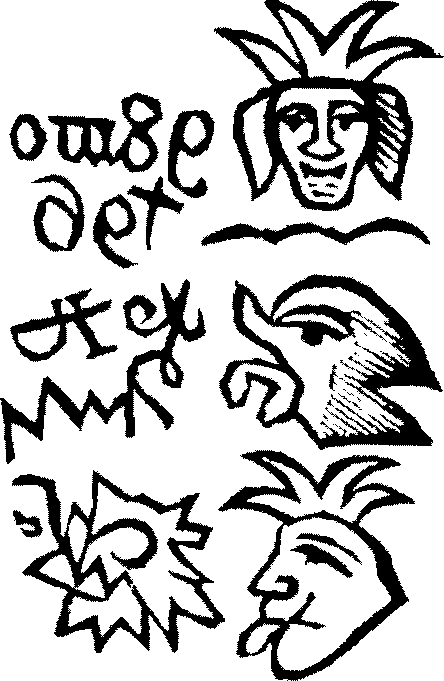
ASTAROT , Grand-due.
LUCIFUGE , prem. Miuistr.
Satanachia ,
grand gdndral.
Agaliarept. ,
aussi gdn^ral.
Fleurety ,
lieutenantg^n.
Sargatanas ,
brigadier.
Nebiros ,
mar. de camp.
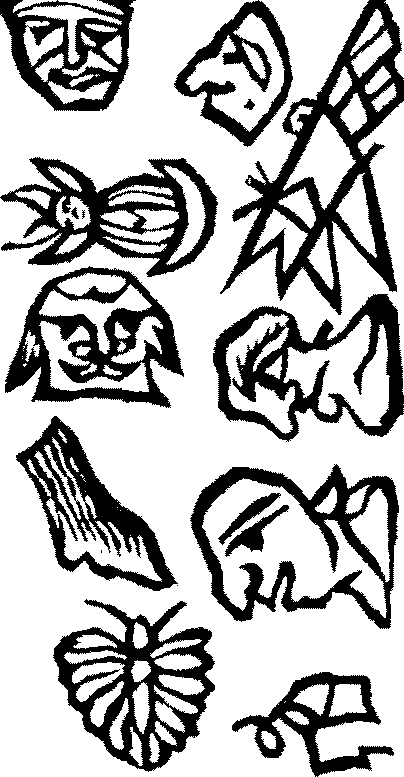
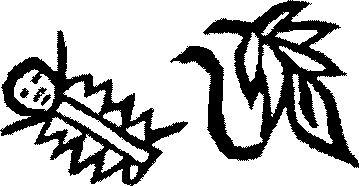
/ able of Chiefs from the Grand Grimoire
Sargatanas
Possibly from Latin sagatus, a soldiers cloak, or from the Greek Sa-tanas?
Nebiros
The name Nibareus appears in the Gnostic text called The Three Steles of Seth and bears some resemblance to the name of this spirit, as also to his sound alike among those names given by Weyer. It is a fact that some of the Gnostic scriptures were influenced by the earliest magical books attributed to Moses and Solomon, such as The Archangelike of Moses, wherein spirit hierarchies were enumerated, and themes found in the later grimoires - such as the brazen vessel(s) of Solomon - also make an appearance. As wild as it may seem to connect a second century Gnostic entity with a demon from the grimoires, some strange names and words in magical texts have longer histories. Whatever the case, Nebiros is among the names of chiefs who appear in various sources. In Verum his role is extensive, since he is ruler of ten out of fifteen of the second set of spirits, as well as sharing the rulership of some among the first eighteen. It is important to note that his sound alike spirit is also known as Cerberus, originally the three headed guard dog of the Classical Underworld. In the Hellenistic period Cerberus is frequently identified with the Egyptian god Anubis.
Other Principal Spirits
Scirlin
This is the great intermediary of the system, who in common with Legba in Voodoo, Exu or Ellegua in Santeria and Umbanda, Ganesha in Hinduism, and Janus, Hecate, Anubis and various other gods of antiquity, is to be invoked first, so that the others may be contacted through his good offices. His authority is as that of the Emperor, which is to say that Scirlin’s intermediary role avoids the necessity of the magician continually disturbing the chief of all spirits. In various ways Scirlin also corresponds to the concept of the Holy Guardian Angel;
it is significant that his sigil includes the letters of the name Adam, among which the operator writes their own initials. The name Adam also forms the basis of an important talisman of the French version of Abramelin, worn by the seer in that operation, as a square derived from the name Uriel is worn by the magician.
Syrach
Possibly a reversed spelling of the Greek charts, love, with its Gnostic meanings? Another possibility, resonating well with some of his Brazilian connections, is Siroshi (various spellings found), a judge of the dead in Persian lore. His role is that of ruler of rhe eighteen spirits following. This and other references in the text confirm his nature as being akin to one of the Four Great Kings, namely the King of the East, each of whom has rule among 72 spirits (thus eighteen each). Incidentally, despite their diabolical image elsewhere, in the Abognazar form of the Key oj Solomon, they are named as Princes of the Spirits of the Four Seasons. Their spirits are very close to the El-ementals of Paracelsus and the Comte de. Gabalis.
Lucijuge Rofocale
This spirit first appears under this name in the Grand Grimoire. The first part of the name is a play on words, turning Lucifer Tight-bearer' into ’fly (flee from) the light. 1 he second part of rhe name has been interpreted as an anagram of Focalor, a spirit from Weyer and the Goetia who appears as a griffin winged human; an elegant engraving in one edition of the Grand Grimoire depicts Lucifuge Rofocale as a winged sphinx like creature which adds substance to this interpretation. Whether or not we are also justified in identifying Lucifuge with Tarchimache, which name his replaces in the Grand Grimoire, is not historically certain; it is a reasonable assumption in practice, and the Greek sphinx was indeed a ’stirrer of strife’. Originally the name Rofocale may simply have been the reversed form of the name Lucifer. See the last line of this magic square, from the French Abramelin, a talisman for causing spirits to appear.
L |
U |
C |
I |
F |
E |
R |
U |
N |
A |
N |
I |
M |
E |
c |
A |
T |
O |
N |
I |
p |
1 |
N |
O |
N |
0 |
N |
I |
p |
I |
N |
0 |
T |
A |
C |
E |
M |
1 |
N |
A |
N |
u |
R |
E |
F |
1 |
C |
u |
L |
The Eighteen Servitors
Just as Duke Syrach is the equivalent in Verum of the King of rhe East in other related Goetic traditions, so the eighteen spirits under him represent a variant of the first eighteen spirits of Weyer’s list (see Appendix One). This is not to say that they are the same spirits under different names, but that they fulfil a similar role in a related system.
Claunech
Possibly from the Latin clanculum, secretly, unknown to.
Musisin
Latin musito, say nothing, brood, mutter.
Bechaud
Derivation unknown.
Frimost
Larin frimotus, roaring, snorting, noise. Note however that AIS Lansdowne 1202 gives Frimost’s name as Frimorh, and on the blade of the knife with rhe black hilr in the Key of Solomon appears the name PhRIMThON, presumably a form of PRIMEUMATON which Moses named and invoked, and there fell a great and severe hail throughout the land of Egypt, destroying the vines, the trees, and the woods which were in that country. Frimost's name also appears among rhe demons of the days of rhe week in some editions of the Grimoire of Pope Honor i us.
Klepoth
Possibly from a Hebrew collective rerm for evil spirits, Qlipoth; the singular form, Qlepah or Klepah, means harlot. While appropriate to the association with Pomba Gira, no exact use of rhe rerm is necessarily implied, in context ir may simply mean spirit. Alternatively, Brazilian tradition includes a variant name, Klepta, which could indicate a Greek root meaning thief.
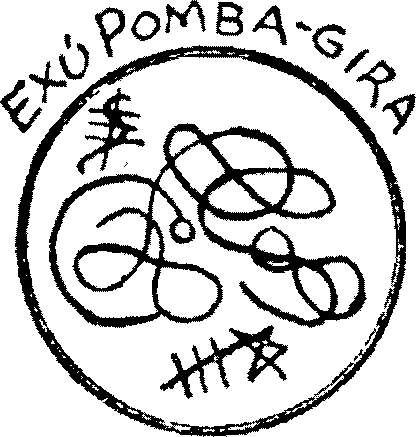
Khil
Perhaps from the Greek kil, a thousand, or from the Hebrew ChL to make a hole, violate. Unlikely but possible is the Hebrew KLH, bride.
Mersilde
From Latin mers, dip, immerse, sink; bury, plunge, drown.
Clisthert
From the Greek klisia, lying down, or Klesis, to calif
Silcharde
Derivation unknown.
Hicpacth
Derivation unknown.
Humots
Latin humatum, to bury.
Sega!
Derivation unknown.
Frucissiere
Latin frudus,Jrudt esse, reward, asset to, productive.
Guland
Latin gula:, gullet, throat, gluttony, palate.
Surgat
Latin surgo, rise, get up, stand up, arise, spring up, grow.
Mom!
Larin morce, delay, pause, hindrance.
Frutimtere
Latin frudieetum (et al), thicker, sprout, bushy; or furtim, stealth, secret.
Hutctigaras
Possibly From the Latin Hut! Tigris!: Hey! Tiger!
The names from the second group of spirits in Verum do not present such strong indications of Larin roots, which may indicate a separate source for these names. The suggested roots below are thus more speculative than rhe former.
Sergutthy
Possibly a similar meaning to Surgat. Alternatively seiugatus, separated, both Larin.
Heramael
Given the herbal associations of this spirit this is likely from Greek eremos, desert, wilderness or uncultivated land; the allied Hebrew root ORM means naked.
Trtmasael
Possibly from Latin, referring to the witches supposed third breast for feeding demon familiars.
Sustugriel
Derivation unknown.
Tarihimal
Derivation unknown.
Elelogap
The first parr of the name likely equates with the Greek eleleu, praised, whence comes Eleleus, a title of Bacchus (rhe praised). The equivalent Hebrew root gives us hallelujah (God be praised). See also Helel, a Hebrew title of Venus as Morning Star, which is to say Lucifer. An important spirit in several grimoires is Gaap (also called Gap, Goap and even Tap); in some classifications one of the Elemental Kings. Al
though references to these Kings are extremely muddled in the late grimoires, Gaap is probably the King of Water and descended from the Egyptian god Hapy, also called Hep or Hap. Hap is the God of the Nile and was an extremely popular god among Egyptians of all classes with a great many household shrines, and a hundred or more at landing stages along the Nile. The Nile represented also rhe Celestial Waters or World Ocean in which all existence is afloat, and upon which the stability of all things depends. His name also resembles the Egyptian Qebh, cool and refreshing water. Elelogap then translates as 'Praise be King of the Waters' or 'Praise the Cool Refreshing Water’, or perhaps most simply’Holy Water’. Hep or Hapi is always represented as a man, but his breasts are those of a woman, indicating the powers of fertility and nourishment of the god. The two kingdoms of Egypt, North and South each had a form of Hapy, that of the South being Hap-Reset, and of the North being called Hap-Meht. It is a possibility that the androgynous image of Baphomet was partly inspired by Hapi of the North.
The apparent absence of a sigil for Elelogap is problematic. Especially as both Verum and Armadel (which calls him Eliogaphatel) refer to it as if it was an integral part of the text they were consulting. One possible solution is in the idea that rhe role of Claunech underwent a process of degradation in the published texts, in the interests of treasure hunting. This process might be more advanced in the Italian edition where all mention of Scirlin - so vital to the true conception of the Grimoire - has disappeared and his invocation been given to Claunech. This may parallel the later development of Lucifuge Rofocale. In the Grand Grimoire he supplants Tarchimache in the hierarchy, and has Claunech's treasure hunting power emphasised in higher degree. This could well be the climax of the sa me degradation process. Following this line of thought, suppose the degradation of Claunech was at the expense of Elelogap, Governor of the Waters, in his original nature. While Claunech is said to be’beloved by Lucifer’, Elelogap bears one of his names. Could Elantiel, an alternative name of Claunech or Chaunta as given by Armadel, have once been identical with Eliogaphatel?
Hael & Sergulath
For possible etymology of the latter see Sergutthy. The eight spirits under these two have among their powers several which are directly comparable with those obtained by a shaman at his initiation by spirits, Invisibility, rhe ability to handle fire, to travel or cause others to travel anywhere in an instant, these are all prominent aspects of shamanic power (see Mircea Eliades Shamanism). Invisibility and ease of travel are both originally linked to the shaman’s ability to travel unhindered in the spirit realm. Similarly it is expected of a shaman that they are able to handle fire unharmed. It is noteworthy in this connection that Goetic magicians use their fingers to put out candles, the candle snuffer apparently being a device of white magicians.
Proculo
Possibly from Latin procul, meaning far away (used in Classical banishing rites) or proculco, trample down.
Haristum
Derivation unknown.
Brulefer
Derivation unknown.
Pentagnony
Possibly from Latin penates, household gods, see also penatiger, carrying his home gods.
Agtasis
A form closely resembling the name of this spirit appears in German versions of Abramelin. It may also be significant that in some texts of Verum his name is mentioned in context of rhe Character of Scirlin.
Sidragosam
Derivation unknown.
Mi nos on
Possibly from rhe Greek Minos, a king of Crete who became supreme judge of the dead in the Underworld, thus signifying infernal judge.
Bucon
Possibly bucconis, babbler. Alternatively, Larin bucerus, horned, or bucintv, shepherds horn; military trumpet, night watch.
A UNIFIED HIERARCHY OF GOETIC SPIRITS
*
Di he potential for a reconstruction and unification of the Jtwo hierarchies of Verum and the Grand Grimoire has been ^inferred by various authors, some have dismissed the task, others partially accomplished it but been confused by matters such as
the two Nebirots and other apparent difficulties. Given that Verum is the earlier text, but lacks details for some of its hierarchy, the main complicating element to identify is the replacement of Tarchimache by Lucifuge Rofocale in the Grand Grimoire, and placing him first rather than third. Once this is understood rhe relationship of both hierarchies with each other is easy to develop mutual principles from. Having accomplished this, their mutual relationship with the reconstructed Weyer and Goetia table also emerges. With the rationalisation of the Four Kings detailed elsewhere, this unified hierarchy also embraces the admittedly highly derivative system of Honorius, as well as variant forms of the Key of Solomon, such as those attributed to Abog-nazar and Armadel.
Table of Chiefs
LUCIFER |
BELZEBUTH |
ASTAROTH |
The Deputies with their Subordinate Spirits
Satanakia |
Agliarept |
Tarchimache |
Fleruty |
Sargatanos |
Nebiros |
|
The Eighteen Spirits under Duke Syrach |
|||||
Claunedi |
Frimost |
Mersilde |
Hicpacth |
Frucissiere |
Morail |
Musisin |
Klepoth |
Clistherr |
Humors |
Guland |
Frutimiere |
Bediaud |
Khil |
Silcharde |
Segal |
Surgat |
Huicrigaras |
Subordinates of the Deputies from the Grand Grimoire, arranged on Verum Template
Saranachia |
Agliarept |
Lucifugc Ro locale |
Fleriry |
Sargatanas |
Nebiros |
Pruslas |
Buer |
Baal |
Bathim |
Morax |
Ayperos |
Amon |
Guyson |
Agates |
Pursan |
Valefor |
Cerberus |
Barbatos |
Botis |
Marbas |
Eligor |
Zoray |
Glasyabolas |
Additional Verum Spirits under the Deputies
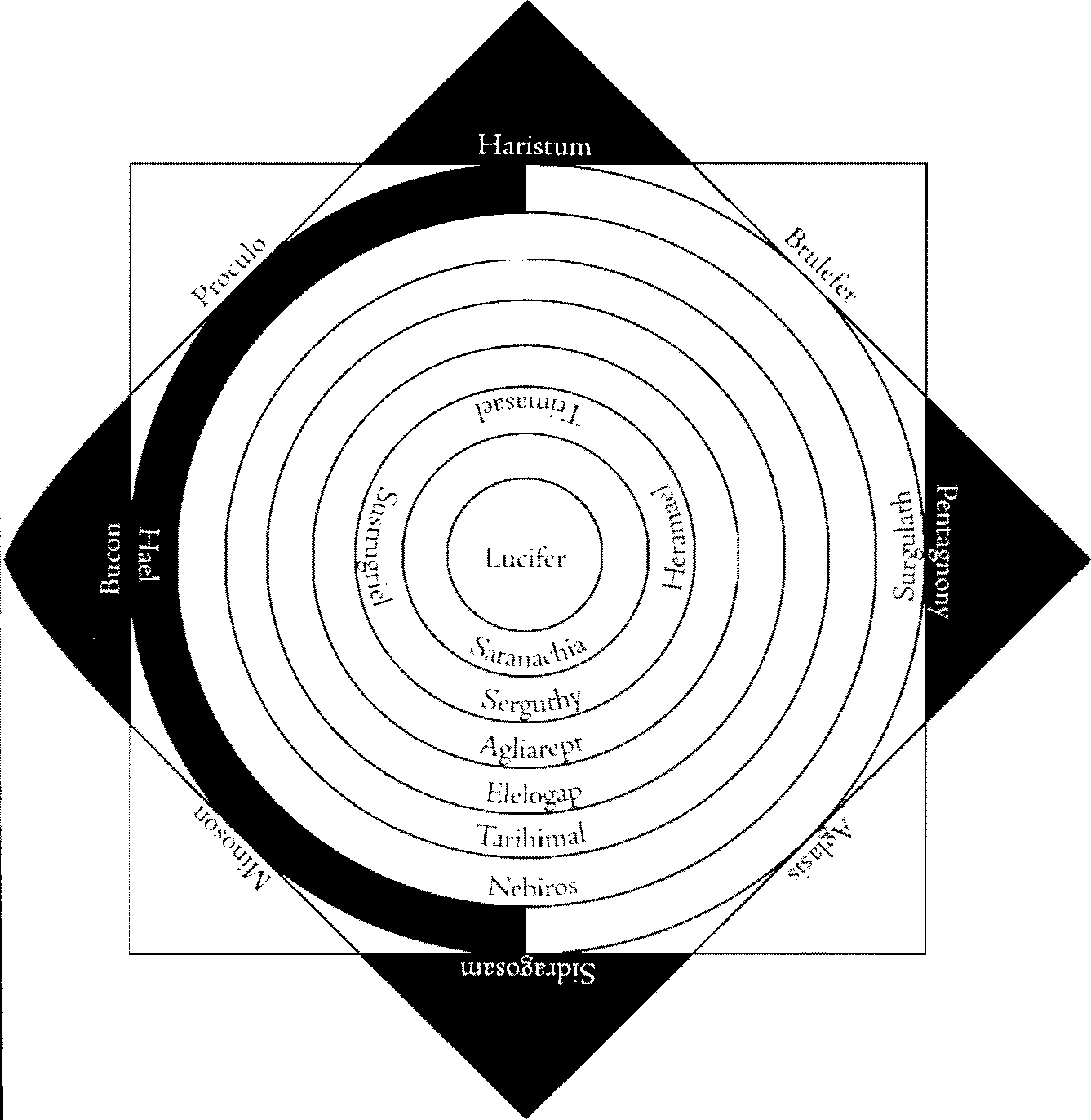
That part of the Verum hierarchy appearing in this figure is not linear. Appearing here for the first time in circular form, its apparent unevenness disappears to reveal much more than is evident from the text. The relation to the deputies of the chiefs takes on deeper meaning in this format and deserves to be the subject of further investigation. Note for example, how the two rulers of Elelogap appear on either side of his circle, as if ruling two banks of a river.
The 72 Spirits from Weyer and the Goetia of Solomon the King
Were there arty certainty in this List of Devils, it were to be preferred as the most ample and exact delineation that is extant. But it is the rather to be suspected, because of the little coherence it hath with the former received Names of Devils either in Europe, Asia, Africa, or America.
Anonymous addition to 1665 edition of Scot’s Discoverie of Witchcraft, regarding Weyer's hierarchy.
The order of spirits in this hypothetical reconstruction of the hierarchy is arranged much as they appear in Weyer, whose listing is the primary source despite being incomplete. Weyer names 69, the Goetia 72, while Scot - correctly in my opinion — gives the total number as 79. Weyer also makes no distinction in his list regarding which are Chiefs, Kings and'followers' among the 72 spirits. Scot's figure permits a combined hierarchy of three Chiefs, four Kings and 72 followers. As alternative and often ridiculous spellings of the spirits names are later than Weyer, his names have also been preferred to the corrupt Goetia and Scot variants. Similarly, this listing includes the spirit Pruslas, mentioned by Weyer but mistakenly omitted from Scot and the Goetia; Astaroth has been raised from the list of 72 princes to the Chiefs as in Abramelin, Verum and elsewhere, and - with reservations - the additional spirits from rhe Goetia of Solomon have been added to Weyer’s.
It is my informed opinion that the Goetia of Solomon is a 17'1’ century reconstruction. It incorporates the spirit catalogue from the translation of Weyer in Scot (first edition 1584, later editions appeared in 1657 and 1665; the manuscript translation of Weyer which Scot used dates to 1570, by one T.R.) and ritual elements from Robert Turners translation of the Heptameron (1655). Both translations were from Latin, Turner’s being of a far higher standard. No manuscript of the Goetia is earlier than these dates, and all are in English, and incorporate many of the mistakes made by T.R. Assertions by many authors
that Verum depends on the Goetia are utterly unfounded, and in fact somewhat mystifying. In actual content the two have extremely little in common: the rituals are different, the great majority of the spirits are different, as are all the sigils, the format of the two books and the basic approaches employed in each. I can only assume that many authors making this assertion are copying the statement to this effect in Waite’s Black Magic, or each other. Such long lived literary continuation of an unsubstantiated supposition by uncritical repetition is unfortunately not rare in occult literature.
Returning to the synthesis of the spirit hierarchy of the Goetic gri-moires: the names of the Four Kings and the elements and directions to which they are attributed are taken from Agrippa. Not only was Agrippa the mentor of Weyer but also these are the most consistent and trustworthy correspondences even though they do not alone explain all the relevant variants in Goetic literature. Some of these difficulties in harmonising the various grimoires can likely be explained by widespread use of two attributions of the directions: the Zodiacal, as given here, and the more material attribution to the four winds. In this alternative schema East is associated with Air, South with Fire, West with Water and North with Earth. Thus for example in Weyer’s text Paymon is said to be obedient unto Lucifer’, consistent with the following table, while the reference to his association with the North is consistent with the alternative attribution of elements to directions. However, such attributions cannot be written in stone, and difficulties are likely to remain. As a final note, the Zodiacal attribution is more helpful to reconstruction in explaining Oriens’ association with Fire, but in practice the title can simply be replaced with his other names if using the attribution by the winds.
Attribution of Goetic Spirits by the Winds
|
Cheijs |
||||||
Belzebuth |
Lucifer |
Lucifer |
Belzebuth |
Astaroth |
Astarotk |
|
Tarchimache (Lucifuge Rofocale) |
Satanakia |
Agliarept |
Fleruty |
Sargatanas |
Nebirots |
|
Kings |
Followers |
|||||
|
Oriens T-l I |-1 . East/rire |
Baal |
Pruslas |
Buer |
Bathin |
Leraie |
Ipos |
Agares |
Amon |
Gusoin |
Purson |
Vale for |
Naberiiis |
|
Marbas |
Barbaros |
Boris |
Eligor |
Mo rax |
GlassylaH |
|
|
Amaymon South/ Earth |
Z-epar |
Pai mon |
Forneus |
Cimieries |
Marchosias |
Sabnacke |
Bilerli |
Belial |
Ronove |
Foras |
M alphas |
Asmoday |
|
Sitri |
Bune |
Berith |
Furfur |
Vepar |
Gaap |
|
|
Pay mon West/ Air |
Shax |
Murmur |
Halphas |
Bifrons |
Orias |
Decarabii |
Procel |
Caim |
Focalor |
Gamigin |
Valac |
Amdusciai |
|
Furcas |
Raum |
Vine |
Zagan |
Goniory |
Andras |
|
|
Ariton North/ Water |
Andrealphus |
Orobas |
Amy |
Allocer |
Hagenti |
Seere |
Ose |
Vapula |
Flauros |
Saleos |
Phoenix |
Dantalion |
|
Aym |
Vassago |
Balam |
Vual |
Stolas |
Andromalii |
|
NOTES TO THE SECOND PART
OF NATURAL AND SUPERNATURAL

The Mirror of Solomon:
A ritual for comparison with this, from the Leyden Papyrus second century ad:
A method of divination by Lamp: You say Boel, Boel, Boel, 1,1, I, A, A, A, Tat, Tat, Tat, the first attendant of the great god, he who giveth light exceedingly, the companion of the flame, in whose mouth is the flame which is not quenched, the great god that dieth not, the great god he that sitteth in the flame, who is in the midst of the flame, who is in the lake of heaven, in whose hand is the greatness and might of the God, come within in the midst of this flame and reveal thyself to this boy here today; cause him to inquire for me concerning everything about which I shall ask him here today; for 1 will glorify thee in heaven before Phre, I will glorify thee before the Moon, 1 will glorify thee on Earth, I will glorify thee before him who is on the throne, who perisheth not, he of the great glory, in whose hand is the greatness and might of the god, he of the great glory, Petery, Pater, Emphe, O great great god, who is above heaven, in whose hand is the beautiful staff, who created deity, deity not having created him, come into me with Boel, Aniel; do thou give strength to the eyes of this boy who has my vessel today, to cause him to see thee, cause his ears to hear thee when thou speakest; and do thou inquire for him concerning everything and
every word as to which I shall ask him here today, O grea t God, Sisaouth, Akhrempto, come into the midst 0/ this flame, he who sitteth on the mountain of Gaboon, Takrtat, he of eternity, he who dicth not, who liveth forever, bring Boel in, Boel, Arbethbainouthi, great one, O great god bring Boel in, Tat, bring Boel in.
You say these things seven times down into rhe head of the boy, you make him open his eyes, you ask him saying, has the light come appeared' If it be that the light has not come forth, you make rhe boy himself speak with his mouth to the lamp. Grow, () light, come forth (.) light of the god, reveal thyself to me, O servant of the god, in whose hand is the command of today, who will ask for me. Then he reveals himself to the boy in the moment named.
You recite these things down into the head of the boy he looking towards the lamp. Do nor ler him look towards another place except the lamp only; if he does not look towards it then he is afraid. You do all these things, you cease from your inquiry you return, you make him close his eyes, you speak down into his head this other invocation which is below, that is if the gods go away and the boy ceases to see them: Arkhe-khetn-phai, Zeou, Hele, Satrapermet, watch this boy, do not let him be frightened, terrified or scared, and make him return to his original path. Open Tei (the Underworld), open Tai (Here).
I say it that this vessel inquiry of the lamp is better than the beginning. This is the method again; its form: you take a new lamp not painted red and you make a wick of clean linen in it; you fill it with genuine clean oil; you place it on a new brick, you make the boy sir on another brick opposite rhe lamp; you make him shut his eyes, you recite down into his head according to the other method also.
Divination by the Word of Uriel:
The use of a child seer in this operation resembles widespread ancient traditions also found in the French Abramelin and elsewhere. Here too, as in Almimelin, the name Uriel is important to the conception. The origins of this ritual, the magical squares worn in Abramelin, and their close family relation to procedures in Goetic literature, including Verum, are discussed elsewhere.
u |
R |
I |
E |
L |
R |
A |
M |
[ |
E |
I |
M |
I |
M |
I |
E |
I |
M |
A |
R |
L |
E |
I |
R |
u |
A new glass vial full of spring water:
There is a complex underlying symbolism to a great many magical uses of water. Originating in late Egyptian rimes and echoed in the magic of the grimoires and of folklore is some such rule as this from the Magical Papyri (pgm iv. 154^285):
Rainwater if you arc calling upon heavenly gods,
Seawater if gods of the earth,
River water if Osiris or Sarapis, Spring water it the dead.
Despite some over simplification, this classification it is a very useful one for beginning an investigation of water in magic.
Three small tapers made of virgin wax mixed with human fat:
The selling of human fat was at one time the sole prerogative of the public hangman of Paris, as a traditional remedy for rheumatism. This monopoly apparently applied only to pure human fat, while druggists and apothecaries sold a refined version. This latter type which, according to Pomet, was'prepared with aromatical herbs', was'without comparison, much better than that which comes from the hands of the Hangman’. This product, known as Adeps or Axungia, with a long history in Classical and early modern medicine, was composed by melting together the following: Two pounds of Man’s Grease, Haifa pound of Gum Elemi, one pound each of Beeswax and Gum Turpentine, four ounces of Balm of Gilead or Peru. This substance was in high demand for making candles for some of the darker ceremonies of French diabolism. However, given the derivation of Goetic magic from more ancient times, exemplified by the Magical Papyri, we would be entirely justified in employing substitutes indicated by that source, PGM xn. 401-44:
Interpretations — which the temple scribes employed... because of the curiosity of the masses they (the scribes) inscribed the names of herbs and other things which they employed on the statues of the gods... we have collected the explanations (of these names) from many copies (of the sacred writings) all of them secret:... Fat from a head: spurge. From the belly: earthapple (cucumber). From the foot: houseleek.
All of these plants contain a good deal of sap or’fat’ which could readily be incorporated with the aromatical elements of the compound described above.
Divination by the Egg:
The prayers and conjurations of the day.
These prayers ’such as are found in the Key of Solomon are probably identical with those of the week days as given in the Heptameron or
Magical Elements. Hie Solomonic connections of the Magical Elements are strong and the attribution to Pietro D'Abano may be late. It is in fact among the earliest and most coherent of the medieval Solomonic texts. In addition the use of planetary correspondences connects it with the Solomonic and Mosaic magical texts mentioned by Zosimus and others in the ancient period.
l.he perfume used in the invocation of Anrel is saffron:
Saffron is frequently mentioned in Solomonic literature, here the attribution to Anael - generally associated with Venus — is problematic. The phrase is very reminiscent of a note on the front page of Sloane ms 3847, 'the fumigation of Sachiel (Jupiter) is saffron’. Since this is one of the earliest manuscripts of the Key (1572) the inference once more is that Verum reflects the earliest traditions of the Key.
To See the Spirits of the Air:
It has been suggested that this spell should form part of rhe invocations, the burning being performed on the thurible or brazier within the circle, this suggestion has the advantage of precedents in the Magical Papyri. Note that the power of Khil is to cause earthquakes, the Italian edition gives the characters of Frimost and Klepoth, but probably rhe sigil of Segal, confused with Khil’s in the French, is the one originally intended.
To Make a Girl Come to You:
1 he mention of ’a star’ is likely Kokab, the Hebrew for Mercury.
To Make Oneself In visible:
Such spells have a long history, not surprising given that invisibility originally implied shamanic powers, and derives from the very begin
nings of magic. The origins of this particular spell are to be foundin Greek manuscripts of rhe Key oj Solomon, ar the very beginning of the Clavicle cycle. In some of these earlier versions rhe spell was specifically addressed directly to Hermes, god of the crossroads and of magic, as well as being performed on his day on the 25I:1 or 29th days of rhe Moon (rhe waning Moon assisting invisibility). Those familiar with Greek myth will recall that Hermes was able to borrow rhe Helmer of Invisibility from rhe Underworld god, Hades. Ute long history of invisibility spells in general can be studied in rhe excellent essay From the Ring of Gyges to the Black Cat Bone: A Historical Survey oj the Invisibility Spells by loannis Marathakis. The particular form found in Verum connects with several of these, and is paralleled by rhe Grimoire of Pope Honorius and the Book oj Saint Cyprian. In many respects the Verum form represents the most complete development of this idea, with mythic elements reminiscent of the pagan magic of the Papyri beyond more mechanistic considerations of sympathetic magic. Aside from the history of invisibility spells in general this secret involves specific themes of occult symbolism with affinities in other magical traditions. Foremost among these is the making of magical heads, including the brazen oracular heads of medieval magicians. Of particular interest are New World methods for making such heads: for the intermediary crossroads spirit Exu, from a coconut and seven coins, and for Eleggua a cement head with seven coins inside it (and occasionally at least, seven cowries marking the holes of the head). Secondly the seven orifices of the head themselves appear in magical practice from Ancient Egypt onwards, connecting African and Western magical traditions. In Western magic these seven holes equate with the planets: the right and left ear to Saturn and Jupiter, the right and left nostrils to Mars and Venus, the right and left eye to Sun and Moon, and the mouth to Mercury. In African magical religions in the New World this symbolism involves the Seven African Powers, It would therefore be both apt and useful to regard this secret as highly allegorical, the head rather than the ’beans of invisibility' being the important feature. Given the connection of Exus with the crossroads, and the association of rhe spell with Hermes, this secret might easily
be adapted to connect with Scirlin the intermediary spirit through whom the other spirits are invoked. For this reason I strongly recommend making a crossroads the place of interment in a reconstruction of this rite using a clay head and seven coins. The intention of this adaptation would be to make a magical head as a central feature of work with these spirits, a natural extension of the underlying symbolism.
To Make a Girl Dance tn the Nude:
The demon said to have this power is not Frutimiere, bur Sidragosam. The Italian gives the character of Segal, which is also plainly wrong.
The Curse of the Nails:
’Pater nosier' up to ’in terra’:
’Our Father, which art in heaven, hallowed be thy name upon Earth', or possibly as some are pleased to say,’Our Father below'. The characters associated with this spell may be misplaced as many others have been, bur the problem is less serious as rhe sigils of any suitably malign spirits from the Grimoire would serve.
Death Spell by Magic Image:
I collected this spell, with obvious Verum connections, so long ago I can no longer trace the source. Tire notes from the previous spell apply equally here.
To Mutilate Enemies:
This spell is taken from the Grand Grimoire, but is plainly of the Verum type.
To Make Ram:
From Armadel Liber Troisieme, a variant or relative of Verum. Neither Verum nor Armadel supply the sigil of Elelogap under that name, which should perhaps be obtained from Hael. Armadel also says this spell may be adapted to produce snow by substituting the sigil of Lucifer in place of those mentioned.
To Open Anything that is Shut or Locked: From Armadel.
To Have Gold Pieces, as Many and as Often and Every Time You Want:
Again from Armadel.
Money of whatever prince:
As in coin of the realm, that is, currency. The references to three and then two characters of Chaunta aka Claunech are problematic.
For Hearing a Pleasant Music:
From Armadel.
I
COMMENT ON
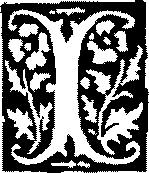
n working with this second book it is important to understand what was said at the beginning: 'the secrets, both Natural and Supernatural... operate by the power of
the Demons’. Ten out of fifteen secrets involve active participation by
spirits from the first parr of rhe book; this can also indicate a certain importance of particular spirits in the overall conception of the Grimoire, as for example with the spirit Frimost. By the same token, those secrets that do not employ such spirits may be adapted to do so, and this was likely the intention of the compiler.
For example:
-
i. The Mirror of Solomon: substitute Klepoth for Anael.
-
2. Tlx Word oj Uriel: Scirlin could substitute for Uriel as an intermediary spirit; also appropriate to Klepoth, or, given the necromantic element, to Nebiros.
-
3. Divination by the Egg: Plausibly one of the six spirits Lucifer, Frimost, Astaroth, Silcharde, Bcchaud, or Guland, attributed by Honorius to the days of the working week; alternatively Klepoth.
-
4, To See the Spirits of the Air: Khil as given - also perhaps Segal and Silcharde.
-
5. To Make a Girl Come to You: Suggested substitutions: Satanakia, Frimost, Sergutthy, Brulefer.
-
6. To Make Oneself Invisible: Sargatanas, Pentagnony; or more eso-terically, Scirlin.
: 7. To Make a Girl Dance in the Nude: Sidragosam.
a t
I
I
-
8. To See in a Vision Anything from the Past or Future: Klepotli, Proculo.
-
9. The Curse of the Nails: either as given or substitute Nebiros, Bucon &c.
-
10. Death Spell by Magic Image: as given or substitute Nebiros &c.
As will be seen the above listing places considerable emphasis on Klepoth and Frimost, going far to elucidate their role in relation to the wands &c. Evolving new spells on the Verum pattern is a relatively simple matter, involving the sigils and/or names, and the parchment form.
ON CONSTRUCTING
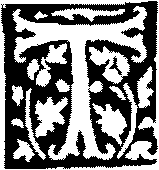
here are two spells in the medley of Supernatural Secrets that bear a resemblance to one another in form. Though these are not among rhe spells using names from the hierarchy they do point towards a formula by which further spells may be constructed, and selection of appropriate names from rhe hierarchy would be an admirable means of extending rhe process.
Take a virgin parchment, and write on it the name of the girl whom you desire to come. The shape of (on) the parchment is ro be as you see in the figure on the right (see below): On the other side of the parchment, write Melchidael, Bareschas. Ihen put the parchment on the earth, with the part where the name of the person is written next to rhe ground. Place your right foot upon rhe parchment, and your left knee, bent, upon the ground.


In this case the name of the object of the spell is written in the centre of the circle, and the names of two spirits on the other side. The paper is turned face down during the ritual, and the spirits are then bn topi Many of rhe intelligences invoked are connected with Mercury, and the chances are that the star intended is actually Mercury (his name in Hebrew means star, and like Venus he can appear as morning and evening star). It need hardly be said that the entire ritual could be amended to include appropriate names from the Grimoire itself -particularly spirits with whom the operator had a pact.
The two NN which you see in the second small circle mark the place where you put your name, ho know what you will, write the names in the circle on virgin parchment before sleeping, and put it under your right ear on retiring, saying the following Orison:
O Glorious Name of Great God the everdiving, to whom all things are present, I am thy servant N..., Father Eternal, 1 beg You to send me Thy Holy Angels, who are written in the Circle, and that they shall show me what 1 want to know, by Jesus Christ our Lord, So be it.
Having completed the Orison, lie down on your right side, and you will see in a dream that which you desire to know.
In this form the name in the circle is that of the operator, since this spell is for their benefit. 'Hie instructions regarding the spirit names are different, on this occasion they are to be written between the two circles. Ihere are of course several Verum spirits with powers over dreams and their names could readily be written in that fashion, and invoked in the Orison.
Deriving adaptations from this is relatively simple - supposing one wished to impart those dreams to a client, rather than oneself? Simply write their name in the centre rather than your own, and give the client suitable instructions. To afflict a victim with dreams another adapta-
On Constructing Verum Spells
tion would be necessary, perhaps with the appropriate names written on back as in example one, and the talisman then placed face down in a hidden place in the bedroom of the victim. A similar creative process could easily be applied to many other purposes, some considerations concerning the appropriate names and means of employment being all that is required.
More on Verum Spells.
Prepare your circle or magical workspace as normal, purifying and consecrating the same. State your intention to make a talisman for such and such a purpose. Take good quality paper, your magical pen and ink, and draw the standard Verum talisman design.
Inside the circle write your name or that of the client or target. Between the two circles making the rim write the names of the spirit(s) who have rhe appropriate powers. After making an appropriate invocation, say:
Ye powerful spirits, who are written in the Circle, do the NN matter, In the Names N & N. So be it.
Purify, consecrate and wrap the talisman, thank the spirits and license them to depart, and close the temple. If it is for your use wear it on your person; or if for dreams or visions, place it under your pillow and repeat the spell on retiring; if it is to influence another without their knowledge, hide it where they will pass; or if for the benefit of a client, let them wear it. Compare the spells in the Grimoire, and embellish the ritual or adapt to suit. For example, use the sigil of an appropriate spirit in rhe centre of the circle, and/or appropriate names around the outside, for example Heramael’s sigil for inclusion in a sachet, or an alchemical spirit for engraving or painting on equipment, and so forth. Also consider the star, sun, moon design as a suggestion to use astrological timing, and change the design to suit, for example, at a ritual of Sun, Venus and Moon, perhaps put a Venus symbol in place of the Star, and so on for other combinations. Uses for other
materials besides paper will also suggest themselves. Tile important element is selection of sigils and/or names, and a working knowledge of the Grimoire so the work is done with full understanding rather than by rote.
NOTES ON THE THIRD PART

The Preparation:
See Key of Solomon Book 11, Ch. n.
The Knife:
Used in making the circle.
See Key of Solomon Book n, Ch. xix.
The Wands:
See Key of Solomon Book 11, Ch. vm.
The Abognazar form of the Key of Solomon also includes two wands, of Venus and of the Sun. Generally an elder wand is for evocation of spirits, a hazel wand is for divination or for wishes. These meanings are powerfully reflected in a mass of relevant folklore. Nevertheless, alternative woods are suggested by various Solomonic works, possibly the most useful substitute is cane, as like elder such rods are hollow. The sigil illustrated, that usually given for the elder wand, is recognisably a reversed version of the Frimost sigil. The sigil given for rhe hazel wand does not match the Klepoth sigil of the Italian version, which is used there for the wand, though generically similar to other Verum symbols. Best practice may be to use a better form of the Frimost sigil in the first case, and to use the symbol given and perhaps add the Italian dancing Klepoth sigil in rhe second. The description of their use with rhe Penitential Psalms - for which obeisance or prostration would be a natural position, and in which a Confession is also implied - suggests a rite of self flagellation, either real or symbolic; which, it may be relevant to note, replaced human sacrifice in ancient Sparta.
'Hoe Lancet:
See Key of Solomon n, vm & xix.
The Pen, Inkhorn and Ink oj Art: See Key 0/ Solomon 11, Ch. xiv.
Manner of Aspergation and Fumigation: See Key of Solomon n, Ch. x & xr.
Manner of preparing Asperger, Water and Perfumes: See Key of Solomon 11, Ch. xi & x.
Very similar incense to that prescribed for charging the circle can be found in both Agrippa and the oldest of the grimoires, the Sworn Book of Honorius the Magician, Particularly close are the perfumes of the Sun and Venus, as also that for perfuming the Seal of God. The already cited section of Abognazar’s Key of Solomon dealing with rings of the Lunar Mansions mentions amber frequently. In all these works there is some confusion over whether amber or ambergris is intended. A consensus today take the sources to mean either ambergris or other aromatics named ambra that were intended to substitute for it. While helpful on occasion, this is an over generalised view; the electrical properties of amber have led to it being connected with magic from time immemorial, as also with rhe Sun. Pagan tribes, resisting the Teutonic Knights in Eastern Europe during the Middle Ages, offered amber in great fires set before serpentine images. In Greek tradition amber was formed from the tears of the Heliades, sisters of Phaethon, shed when he was struck down from heaven bv the thunderbolt of Zeus, His fall from heaven and other parts of this legend have resonant associations with the legend of Lucifer, as recognisable in the past as in the present. While ambergris may be considered more aromatic than amber this is very far from being a decisive consideration, other fumigations recommended by Abognazar include hair and flies!
Notes on the 'Third Part
Of the Virgin Parchment:
See Key of Solomon 11, Ch. xvu.
Or as others say, the characters of Guland and Surgat:
The Italian has the character of Khil, though again Segal is probably intended.
The Preparations for the Ritual:
See Key of Solomon n, Ch. i.
The Prayer:
This is my reconstruction and also an interpretation. The series of names preceding the prayer is shorter and corrupted in the various editions of Verum, for example: Astrachios, Asach, Asarca, Abedumabel, Silat, Anabotas, Jeubilin, Scioin, Domos; or Astrachios, Asach, Asarca, Abedumabal, Silat, Anabotas, Jesubilin, Scigin, Geneon Do mo I.
It is evidently derived from a more complete version, several of which are to be found in the mss of the Key of Solomon. My interpretation of the three words concluding the series translates as'Scirlin; spirit of the house’ addressed to the intermediary spirit of the system. Mathers’ rendering of the first word has no authority in the mss so here a Verum reading is preferred, likewise Silat is preferred to the various alternatives, it is a Verum reading and a known spirit name; also Adonai is chosen over Edoniel - since this name is much used in Verum and even more so in the Grand Grimoire and is also found in some versions of the prayer in the Key. This prayer is absolutely central to the system, and is intended for use several times a day in the lead up to conjurations. Qabalistically inclined magicians may attempt their own interpretations of the names, exactly as some magicians do with the rite known variously as the Bornless Rite or Headless One. Thelemic magicians may also consider adding the prayer to their performance of Liber Resh and vice versa, especially as the solar stations equate with the times recommended for its performance.
THE RITUAL PROCEDURE OF THE GRIMOIRE
t has been said, with next to no justification, that the mS Mflmethod dqe Griworinw Verum is incomplete and unworkable. Nothing could be further from the truth, although the inferior quality of some editions may excuse such an impression. A thorough comparison of the variant texts can overcome this difficulty, especially when complemented with experimentation. From such an analysis it becomes clear that there are three distinct stages to the operations of the Grimoire. Firstly there is the manufacture or obtaining of the magical weapons, and their careful and painstaking preparation. Secondly, and centrally, there is the preparation of the magical parchment, complete with sigils and conjurations. Thirdly there is the stage of active conjuration. The text tends to skip backwards and forwards between these stages — when describing the use of one of the instruments it often goes off on a tangent explaining its preparation — but once these three stages are identified the operating procedure becomes fairly straightforward, though it could not be called simplistic or undemanding.
So far as the demands of the practical operation of the system are concerned informed opinion is that corners should not be cut unnecessarily. When the difficulties involved are those of inconvenience they may as well be surmounted if possible, after all they are in the spirit of the process and the majority were no easier when the rite was composed. Similarly, rational objections or prejudices regarding timing and other factors should be put aside rather than indulged. The use of planetary days and hours is simple enough, and enables the whole process to be 'special' and outside the normal run of experience. The use of rare or hard to obtain materials is also something the operator must carefully consider. Effort and resources expended are in keeping
with the process, ’this kind of creature does not give anything for nothing’. Perhaps the only place where substitution may be justified is in the slaying and skinning of a goat to make the parchment. The Grimoire gives a simpler alternative process for preparing virgin paper; but it is also eminently possible and in accord with magical thinking to go through the motions of preparing this paper as if it were the skin of a goat — obtaining or making the materials needed and performing a symbolic slaying, scraping, coating with salt and weighting with stones for the required time before placing it in a Liming Pot prepared in accordance with the procedures described in the Grimoire. For the authors of the grimoires the killing of an animal would be an everyday act accompanied by no strong feelings. For many modern westerners it would be an extreme experience accompanied by feelings of revulsion and horror unintended by the original text and therefore inappropriate to the ritual.
Among many reasons for approaching the process as wholeheartedly as possible is the cultivation of the mythic sensibility. The parchment being such an important part of the whole theoretical and practical conception of Goetic magic there should be as little skimping as possible in its preparation. As said earlier, when it comes to making a Liming Pot - symbolic or not - there are several versions of the inscription given, but since the pot needs to be fairly large the operator could include more than one version. If for some reason a choice has to be made, then the sigils of suitable spirits are the best for reasons that should be clear from much that has been said above.
If there is an element of the ritual that requires clarification it is undoubtedly the formation of the Circle to be employed in the Verum rite. This is not clearly described, nor depicted, in any of the known texts. There are however numerous hints among them, as well as some very helpful correlations with the methodology of the Grand Grimoire and illustrations in other French grimoires, such as the Black Pullet.
The Ritual Procedure of the Grimoire

Circle from Le Dragon Rouge
The best form is a double ring containing an equilateral triangle that touches the circumference of the inner circle, all preferably drawn in red. The top of the triangle should point East — or other direction as may arise - and immediately within it is the position of the brazier. Behind the brazier stands the conjuror,’with the knife and asperser at his feet’, two possible companions stand behind the conjuror, so that the trio also form a triangle. At the four cardinal points are placed images of the Pentacle of Solomon. A more compact form of the Circle could place these between the Cardinal points, permitting the Circle and Seals to be contained in a square of approximately nine feet.


Ideal Verum Circle
PLANETARY DAYS AND HOURS ❖
Timing of Operations
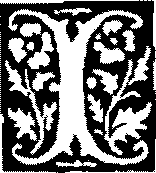
n general Verum requires all activity to take place under a waxing Moon, and preferably soon after the New Moon. In addition it requires planetary days and hours to be used and the operator is advised to learn how to calculate these. The days and hours of Mercury are chiefly employed in making the tools, with some exceptions, while the days and hours of Mars are prescribed for the writing of the Pact and for the Conjurations. The first hour of each planetary day is also the hour of that planet, so Dawn operations are at least implied. There are several traditional sources that recommend Dawn for the cutting of wands as well as for magical operations or meditations; we may infer that the first hour of the day is generally preferred, with exceptions; when we are buying our materials, for example, a later hour of the planet will suit the situation.
The Planetary Days
Hopefully all are aware that in traditional sources rhe Sun rules Sunday, the Moon Monday, Mars Tuesday, Mercury Wednesday, Jupiter Thursday, Venus Friday and Saturn Saturday. These names of the days are derived from names of Norse gods plus Sun, Moon and Saturn. The attribution of the planets to rhe days is encountered in the Gr.ivo-Egyptian papyri (where Saturday becomes Kronos, Sunday Helios, Monday Selene, Tuesday Ares, Wednesday Hermes, Thursday Zeus and Friday Aphrodite), as well as the much later grimoires, and is likely of Chaldean origin, as is the seven day week. The planetary hours schema is an adaptation of Egyptian ideas encountered at
around rhe same time. As well as coming together at the dawn of the Western magical tradition the planetary days and the planetary hours are also mathematically inseparable.
The Planetary Hours
If we allocate the hours of the day to the seven planets in a regular cycle commencing with the planet whose day it is, then the next day will start with the hour of the planet ruling it, and so on continuously. Tlris pattern evidently depends on a close relationship between seven and twelve. At this stage it should be pointed out that the traditional planetary hours are not the same as our one o'clock, two o'clock and so forth. The Planetary Hours of rhe Day are calculated by finding the number of minutes between Sunrise and Sunset and dividing by twelve; thus the first hour begins at local sunrise and consists of one twelfth of real daytime. The same process is then applied to the time between local Sunset and Sunrise, to obtain the Planetary Hours of the Night.
Since Saturday illustrates the pattern best we shall illustrate it with the Day of Saturn as our example. Sunrise on Saturday begins the hour of Saturn, followed by the hour of Jupiter, then that of Mars, Sun, Venus, Mercury and the Moon, the eighth hour being again that of Saturn, and Jupiter, Mars, Sun, Venus ruling the remaining hours. Sunset on Saturday makes no change to the cycle, being ruled by Mercury and so the cycle continues through the night, until Sunrise on Sunday begins with rhe hour of the Sun.
The first hour of each day therefore is ruled by rhe same planet as the day itself Very often in the grimoires we are told to do such and such in the day and hour of Mercury (for example). This frequently means Sunrise, which saves a lot of calculation. It also gives us the energy of the day at source (and when the Sun is on the Ascendant, the Moon is automatically conjunct the Part of Fortune). However it does not always mean Sunrise, if for example we are told to buy such and such in the day and hour of Mercury, we may have difficulty finding
Planetary Days & Hours
a shop open at Dawn, so very likely the Eighth planetary hour is intended.
There or may not be a measurable relationship between the planets and rhe days and hours to which they are attributed. What there is however is a clear relationship between the evolution of the week and the lunar month of 28 days, the Sabbaths once marking the four quarter days of a lunation. The magician, seeking to make reality malleable via his symbols, has much to gain from the Days and Hours of the Planets. Thus we tap into rhythms that reverberate through our entire culture; impose a rhythm on our magical activities that increases our momentum, and enrich and deepen the fabric of our experiences.
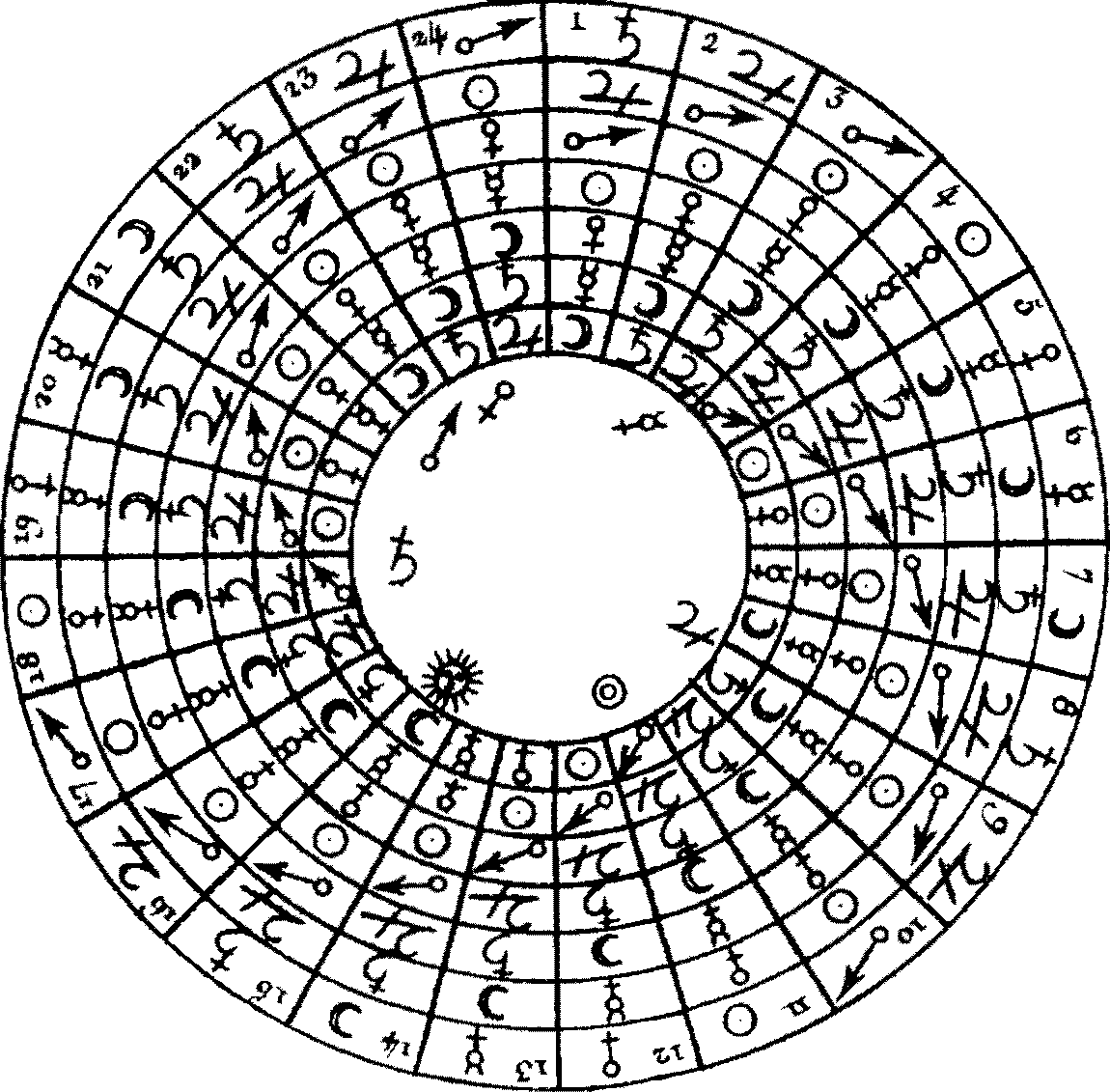
77h> Circle of Hours
The circular Table of Hours appears in some editions of Verum as a full page plate. It is wrongly referred to as if it were a table of the sigils of spirits, whereas it actually represents the planetary hours and strongly resembles a similar plate in Robert Fludd’s Utriusque Cosmi Historia published at Oppenheim in 1617. Judging by references in the text it apparently replaced a lost plate showing the correct attribution of sigils.
THE SPIRITS OF THE SEVEN DAYS

n the later Italian editions of Verum rhe conjurations of rhe three chiefs, Lucifer, Belzebuth and Asraroth are supplemented by conjurations of four additional spirits, the whole representing rhe days of the week from Monday to Sunday. This
material appears to be derived from versions of Honorius that in turn had borrowed Verum spirits, with the usual disregard for correct placing or labelling of sigils. Contemporary French editions of Verum omit this material, possibly because a French edition of Honorius was printed at a similar time. Another reason for omission is that the modus operand! of Verum in the existing form does not support the Honorius schema, indeed it contradicts it: for example, the four extra spirits would be conjured by an existing Verum conjuration of inferior spirits' (in addition the Verum method presupposes that formal conjurations will be performed on the days of Mars exclusively), and the Honorius version is therefore superfluous. Hie planetary attributions in Honorius also make little sense, with some arguable exceptions.
However, given some flexibility regarding the contradictory timing rules, the modus operandi of Verum could be adapted to experiments with demons of rhe days’. Some technical observations deserve to be noted regarding such an attribution. Firstly, rhe main listing of spirits in Verum consists of 28 spirits and the 168 hours of the week divide exactly by this number. It is possible to attribute the chiefs and their deputies to the Qabalistic Tree of Life, with the three chiefs plus Scirlin attributed to the Middle Pillar and the pairs of deputies to the side pillars. List these ten names in the order of the Sephiroth, add the names of the eighteen ’inferiors’, then repeat the entire list five times to give 168 names. Note then that rhe first name in each group of 12 correspond in five out of seven cases with those attributed to the
week days by Honorius (1670 edition). It seems extremely unlikely that this is due to coincidence, suggesting that an older attribution of the spirits of the True Grimoire to rhe hours of each day and night may well have preceded the published editions. Attributions of spirits to the hours are known in Byzantine and other sources; also, the days of the week derive from divisions of a 28 day Lunar cycle, with the Sabbaths corresponding to the four quarters of rhe Lunar month. It follows then that an attribution along these lines would be both traditional and ancient.
Despite its merits, such a hypothetical schema is our of place in this reconstruction, and must be left for individual research or a later work. Included here therefore is a comparative chart of the spirits as they appear in the various editions of the two grimoires. The rimes given are likely corrupt and it is likely that in earlier mss they were originally all 3rd and 4* and 10* and 11th, as these are the appropriate planetary hours of rhe night of each planetary day in every case,
Times of Working
Day of the Moon |
Lucifer |
Between 11'1’ & 12'*’ hours, (or 3": & 4'1’ of rhe night) |
Day of Mars |
Frimost or Belzebuth |
Between 9"’ & 10th hours of the night |
Day of Mercury |
Astaroth |
Between 10* & 11 * hours of the night |
Day of Jupiter |
SlLCHARDE |
Between 3rd & 4* hours of the night |
Day of Venus |
Bechaud |
Between ll'1’ & 12* hours of the night |
Day of Saturn |
Guland |
Between 3rd & 4” or 10* & 11* hours of rhe night |
Day of the Sun |
SURGAT |
Between 10* & 11* hours of the night |
ON THE CABALA OF THE GREEN BUTTERFLY

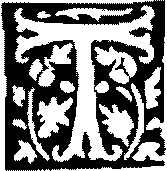
his part of the evolution of rhe True Grimoire is ably I9dl century Italian, but for various reasons it de inclusion here. Firstly, it does not appear in any <
probserves if the French editions I have seen, or their dependent English translations,
although The Prayer of the Salamanders is apparently common to all. This prayer appears in other noteworthy French sources: in Le Comte de Gabalis first published in 1680; and subsequently in the writings of Eliphas Levi in the middle of the i9rh century, who includes further prayers for the other three elements, 'fhe Comte credits it to the Oracle at Delphi, as recorded by the Neoplatonist Porphyry, which — as the Comte includes genuine Oracles from his writings - may yet prove to be the case, lite fiery nature of the spirits invoked is in accord with the nature of the main hierarchy of Verum. Another reason for inclusion is the presence in Golden Dawn rituals of the prayers of the Elemental Spirits (added below). It is unlikely that initiates of the 4=7 Grade are consciously performing the Cabala of the Green Butterfly'. There is also a Cabala of the Black Pullet, and apparently further Cabalas (Secrets) of the Queen of the Hairy Flies and of the Black Screech Owl. It is entertaining, though the notion is improbable, to imagine that these could be attributed to the other elemental grades of the Golden Dawn. But it is certainly interesting that a magical Mass is also to be found among the Elemental rites of that society, and both
the Prayers and the Mass form part of the Watchtower ceremony derived from these rituals. In conclusion, note that one of the deputies of Astaroth has as their sigil a representation of a large butterfly like creature. If drawn on an emerald (or in green ink), as might be inferred from the First Part of the Grimoire, the basis of a talismanic rite could readily be derived from these materials. Taken all in all the promise of the Grimoire to supply the secrets of invoking the spirits of the four elements is perhaps not unfounded.
The reference in the Cabala of the Green Butterfly and of the Black Pullet to a conjuration from the Red Dragon also relates to Elemental Spirits, as may be seen from the Grande Appellation, which is the conjuration referred to:
I conjure you, O Spirit, to appear at once by the power of the great Adonay, by Elohim, by Ariel, by Jehovah, by Agla, Tagla, Mathon, Oarios, Almouzin, Arios, Membrot, Varies, Pithona, Magots, Sylphae, Gabost, Salamandrae, Tabots, Gnomus, Terrae, Caelis, Godens, Aqua, Gingua,Jauna, Etitnamus, Zariatnatmik. A T E * A * J * A * T * M * O * A * A -? M * V * P T M * S * G T S * T * G T T -? C T G * A T G T J T E T Z * &c.
The remaining Elemental Prayers follow below.
Prayer of the Sylphs
Spirit of Life, Spirit of Wisdom whose breath gweth forth and with-draweth the form of all living things; Thou, before whom the Life oj Beings is but a shadow which ehangeth, and a vapour which pas-seth; Thou who mountest upon the clouds, and who walketh upon the wings oj the wind; Thou who breathes! Jorth, and endless Space is peopled; Thou who drawest in Thy breath and all that cometh from Tljee returneth unto Thee; ceaseless Movement in Eternal Stability, Be Thou eternally blessed! We praise Thee and we bless
On the Cabala of the Green Butterfly
Thee tn the changing Empire of created Light, of Shades, of reflections, and of Images and we aspire without cessation unto Thy immutable and imperishable brilliance. Let the Ray of Ebine Intelligence and the warmth of Thy Love penetrate even unto us; then that which is volatile shall be fixed, the shadow shall be a body, the Spirit of Air shall be a soul, the dream shall be a thought. And no longer shall we be swept away by the Tempest, but we shall hold the bridles of the Winged Steeds of Dawn, and we shall direct the course of the Evening Breeze to fly before Thee. O Spirit of Spirits, O Eternal Soul of Souls, O imperishable breath of Life, O Creative Sigh, O mouth which brearhest forth and withdrawest the Life of all Beings tn the Flux and Reflux ebb and flow of thine Eternal Word which is the Divine Ocean of Movement and of Truth. Amen.
Prayer of the Undines
Dread King of the Sea, who hast the Keys of the floodgates of Heaven and who enelosest the subterranean Waters tn the cavernous hollows of Earth; King of the Deluge and of the Rains of Spring; Thou who openest the sources of Rivers and of Fountains; Thou who commandest moisture, which is like the blood of the earth, to become the sap of plants: We adore thee and we invoke thee! Speak thou unto ns Thy inconstant and changeful creatures in the great Tempests of the Sea, and we shall tremble before Thee. Speak unto us also in the murmur of limpid waters, and we shall desire thy love. O Vastness wherein all the Rivers of Being seek to lose themselves, which renew themselves ever tn thee. O Ocean of infinite perfections! O Height which reflectest Thyself in the Depth! O Depth which exha lest thyself into the Height! Lead us into Immortality through sacrifice, that we may be found worthy one day to offer unto Thee the Water, the Blood, and the dears, for the remission of Sins! Amen.
Prayer of the Gnomes
0 Invisible King Who, taking the Earth for Foundation, didst hollow its depths to fill them with Thy Almighty Power. Thou Whose Name shaketh the Arches of the World! Thou who causest the Seven Metals to flow through the veins of the rocks! King of the Seven Lights! Rewarder of the subterranean Workers! Lead us into the desirable Air and into the Realm of Splendour. We watch and we labour unceasingly, we seek and eve hope, by the twelve stones of the Holy City, by the buried Talismans, by the Axis of the Lodestone which passes through the center of the Earth. O Lord, 0 Lord, O Lord! Have pity upon those who suffer. Expand our hearts, detach and upraise our minds, enlarge our natures. O stability and Motion! O Darkness veiled in Brilliance! O Day clothed in Night! O Master who never dost withhold the wages of Thy Workmen! O Silver Whiteness! O Golden Splendour! O Crown 0/ Living and Melodious Diamond! Thou who wearest the Heavens on Tliy Finger like a ring of Sapphire! Tmi who hidest beneath the Earth in the Kingdom of Gems, the marvellous Seed of the Stars! Live, reign, and be Thou the Eternal Dispenser of the Treasures whereof Thou hast made us the Warders! Amen.
BLACK PULLET
"jHis cabala or secret, from the Ted ’'Dragon, is included Ijhere as it is a relevant part of the late French grimoire cycle. •Jit has several connections to rhe Cabala of the Green Butterfly, while a black hen also features in the Divination by the Egg in the
True Grimoire. Tire ritual is also apparently quite difficult to find. As a result of this scarcity perhaps, it is often confused with a well known grimoire of the same name (whose real title is The Old Man of the Pyramids), which also has connections with the True Grimoire. A summary of this rite, and its illustration, can be found in Waite's Book of Black Magic, why he did not include it in its entirety, given its brevity, is difficult to understand. While obviously decadent, it is nevertheless not without interest. For instance it bears comparison with perennial folklore rhemes, as well as with rituals of surprisingly early vintage such as PGM Xl.a 1-40. Based on this and other considerations my feeling is that the evil spirit in this rite is to be identified with Astaroth, as in the Cabala of the Green Butterfly.
The famous secret of the Black Pullet, a secret which one cannot rely on resulting from any cabala, which had been lost for a long time, and is now retrieved, we transcribe hereafter:
Take a black hen which has never lain eggs or been approached by a rooster, do nor permit it to cry out as you take it; to assure which you must take it at the eleventh hour of the night while it is asleep. Take it by the neck so as to prevent it crying out. Go then to rhe highroad, and walk until you reach a place where two roads cross. There, at the stroke of midnight, make a circle with a rod of cypress, and standing in the centre rear the body of the hen in two, while pronouncing these words
three times: Eloim, Essaim, Jrugativi ct appellavi. Turn then to the East, kneel and make an oration, which done recite the Grand Apellation; then will the unclean spirit appear in a scarlet frockcoat, a yellow waistcoat and breeches of pale green. Its head will resemble that of a dog, with asses ears, surmounted by two horns; its legs and hoofs will be those of a cow. It will ask For your demands; make these as you see fit, and it will not be able to refuse you; thus will you be able to render yourself very wealthy and the happiest of men.
It is well for you to understand before commencing what is said above, that it is necessary for you to have recited yout devotions, so as to have no guilt with which to reproach yourself. Uris is moreover most essential as you will then nor be subject to the will of the evil spirit, but they to yours.
ASTAROTH
LADY OF THE CROSSROADS

staroth is a spirit of the True Grimoire, and one of the three chiefs of the spirits. In the system of the True Grimoire, Astaroth shares rule over the world with Lucifer and Belzebuth. In this division Lucifer rules Europe and Asia, Belzebuth
Africa and Astaroth the Americas. In supposedly traditional systems of demonology Astaroth is often seen as a male. This is something which will be discussed later. For our immediate purposes Astaroth is considered as similar to, if not identical with, a goddess of rhe pagan Canaanites and others, known as Astarte, and associated with Venus and the Moon.
Tin's is not necessarily a contradiction of the grimoires, which are remnants of older magic as well as systems in their own right. Tliey are by definition incomplete, and improved understanding requires research, patience and experience. Despite their shortcomings, and their frequent inaccuracies, it is unwise to make changes without first gaining this understanding and experience. To do so can often worsen the results rather than improve them. The difference between the grimoires and the approach described here is a consequence of the more individual and personal nature of the spirits as they are encountered in this manner of working. It is also a result of the correspondence of this approach to magic as it existed long before the medieval period.
Astaroth has as her deputies in the True Grimoire the spirits Sar-gatanas and Nebiros, who in turn rule over many spirits, particularly Nebiros. Besides these important hierarchical relationships Astaroth has an affinity with one, and only one, of the other spirits of rhe True Grimoire, This affinity is with the Emperor Lucifer himself and no other spirit has such an affinity. As with the affinities other spirits of the True Grimoire have, one with another, this affinity is not one of
rulership but of kindred spirits. As a relationship between Chiefsit is an important affinity, and one with many consequences and implications.
While Lucifer is the ultimate ruler of all the spirits, and is seldom invoked directly, Astaroth’s affinity with him, along with her own important position, makes her the ideal Chief for magicians to work with. Astaroth is by far the most approachable of the three Chiefs, and the magician who works with her will find her affinity with the Emperor a most useful quality. Together with the relationship with Scirlin that every magician working the True Grimoire must have, a relationship with Astaroth has the potential to draw the favour of Lucifer towards the magician. In addition, the affinity between these chiefs can confer on the magician many of the benefits that Lucifer would bestow. This is in marked contrast to working with Belzebuth, who is harder in nature, and less forgiving of failings in ritual procedure.
The Powers of Astaroth
According to the Grimoire of Honorius Astaroth confers the favour of the great and powerful, and this is in accord with her association with the star Sirius, which also confers other gifts associated with her in ancient times. According to Weyer, Scot and the Goetiu, Astaroth can answer truly concerning all matters past, present and future, and of all secrets. According to the Grimoire of Armadel, and confirmed in less detail by the three above mentioned, Astaroth can also reveal all matters concerning the Fall of the Angels, including their life before the Fall, their creation, the origin of their names and so on.
Tire conjunction cycles of Sun and Venus, which form the upright and averse pentagrams in the course of their eight year cycles, are particularly connected with Astaroth, as is the New Moon. She is also associated with particular stars, including Sirius (13'57 Cancer) the Greater Dog Star. This star has a long history in mythology and conjuring magic, and there were Sirius sanctuaries in Egypt, Persia,
Greece and Rome. Its precious stone is the beryl, a marine stone. Its plants are savine, mugwort and dragonwort. Among animals it is associated with rhe tongue of the snake. Its magical image is of a hound and a young virgin (Anubis and the goddess Sothis). Astrologically this star is associated with luck, pride, wealth, ambition, good reputation, fame, honours, occult interests, and dog bites. Magically it can confer honour and good will, the favour of men and of aerial spirits, giving the power to pacify and reconcile kings, princes and other men. Care should be taken to avoid adverse connection with Mars when Sirius is rising, for fear of overweening ambition leading to either accidents or attempts on one’s life.
She is also associated with Jupiter's exaltation degree, 15 ° Cancer. Conjunctions of the Ascendant, the Moon, Jupiter and Venus with this degree are all powerful, and can be worked under her auspices. The stars of the twins, Castor (18 “ Cancer) and Pollux (21 ° Cancer) are also under her. With these it is wise to work when Castor is above the horizon, and Pollux still below.
So also is Procyon (24 ’ 24 Cancer) the Lesser Dog Star. Its stone is agate, its plants the flowers of marigold, and pennyroyal. Its magical image is the image of a rooster or of three maidens (an image of Hecate Triformis). This star can be worked with magically to confer the favour of the gods, spirits and men; it also protects from evil magic and preserves health.
Astaroth in the Middle East and in Egypt
The history of Astaroth in the Middle East and Egypt is long and complex. It involves millennia of time, a vast swathe of geography and several language groups, besides a multiplicity of roles. Just one of her oldest forms, the Sumerian Inanna, has been called the many-faceted goddess, Inanna. Besides this there are the syncretic associations; the goddesses with whom she has been identified, or who she has absorbed, or who have absorbed qualities from her. To resolve all these complex issues clearly and meaningfully here is an impossible task.
To serve a useful purpose, appropriate to the work in hand, it is enough to trace the main line of descent - from Sumeria to Ptolemaic Egypt - and clarify her most important roles.
Sumerian Inanna
A principal role of Inanna was fertility, initially perhaps in relation to the dare palm, bur exrending to wool, meat and grain. One ofher key symbols in relation to this role was the gate post of the storehouse. Her myth involved a marriage on the day of harvest, to her lover Dumuzi, who is a form of rhe dying god common to the fertility cults of the region. This form of Inanna probably involved one ofher other key roles, as a deity of storm and rain. In this guise the lion is - as with other storm deities - a key attribute. She drives a chariot drawn by seven lions, rides a lion, or is herself a lion. In one of her myths she also borrows rhe other thunder animal, the Bull of Heaven, the roaring of both animals was heard in the thunder. Among her titles are: 'Inanna, the great storm of heaven’. This attribute relates both to her fertility aspect and to her warlike nature, as thunder she is ’the destroyer of mountains, who lent the storm wings’. As the rain her nature is gentler, and life giving:
I step onto the heavens, and the rain rains down,
1 step onto the earth, and grass and herbs sprout up.
It is in her role of thunder goddess that her warlike nature likely originates. Certainly one of the key manifestations of Asraroth from this point on is as a lion-headed war goddess, and Inanna is known as a war goddess from very early myths.
Another key role of Inanna is as goddess of Venus as both Morning and Evening Star. Interesting in this respect is that in this form the goddess holds court at New Moons to hear petitions from those in distress. As Evening Star too she judges the just and the unjust. As the Morning Star represented productive work, so the Evening Star represented rest and recreation, and another key role of Inanna follows from this; Inanna as harlot, goddess of music and dance, the
As taro th
protector of prostitutes and of alehouses. The Morning Star on the other hand was also associated with her as goddess of war, a symbolism of surprisingly wide distribution among peoples of Asiatic descent. Implicit in her warlike role it is a fair inference to see ideas of punishment and vengeance following on her judgements.
All these roles are found in the Akkadian (and general Semitic) Ishtar, with whom Inanna was identified. The name Ishtar derives -through the intermediary form of Eshtar - from that of Attar, the name of a West Semitic god of Venus as Morning Star, and of rain. As his female counterpart Astarte (the older form is Attart, the feminine form of the male name), she represented Venus as Evening Star, as well as rain, war and sexual love. These are only the main qualities of rhe goddess, whose multi-faceted nature possesses ar the same time an abiding unity of characterisation.
There are certainly other complexities that are at present beyond rhe resolution of the deepest scholars. For example the precise nature of her relationship to the goddess Anath, and to Asherah, has yet to be discerned. What matters here is chat the principle symbol of Asherah, the ceremonial pole that bears her name, is also associated with Astarte. This important symbol is also the post sacred to Inanna. As Astarte or Ashtorerh she was the foremost goddess of the Semitic Phoenicians and Canaanites. Under the name Tank she was also the principal goddess of the Phoenician colony of Carthage, who bore all the same attributes.
The Mysteries of ists and Osins is the title of an important work by Plutarch from which most of our knowledge of those Mysteries is derived, and which studies of monuments and papyri have only enlarged upon. Ute story is familiar enough, and only some details concern this study. When Set closes Osiris in a chest and throws it in the Nile, it is carried away by the river, out to sea, finally coming to shore again at Byblos. Byblos was an extremely ancient Phoenician city, and the centre of the worship of Tammuz, a form of the dying god akin to Dumuzi the lover of Inanna, The Greeks adopted the rites of Adonis from here as early as the 7'“ century bc, the name Adonis being derived from rhe Phoenician word Adon meaning Lord.
In rhe Egyptian story Isis traces rhe chest to Byblos, where an impressive tamarisk tree has swiftly grown around ir and been removed as a pillar for rhe palace of Queen Asrarre and her husband Melkarthus (Melqart, another important Phoenician deity', called by rhe Greeks rhe Celestial Hercules). Thar these two figures are as divine as Isis, or only as human as she, is certain. It is also extremely likely that this part of the story explains the relationship between the Mysteries of Isis and Osiris, and those of the Semitic goddesses and their dying consorts. It is in fact extremely likely that a wordplay has extended the word byblos (initially a reference to thoroughly Egyptian papyrus swamps; papyrus being what paper, and thus books or bibles, are made from), to the Phoenician city. The tamarisk tree is mentioned in Babylonian laments for the god:
A tamarisk that in the garden has drunk no water, whose crown in the field has brought forth no blossom.
One version of this myth has it that Isis did not take back the body of Osiris to Egypt, bur that he was buried at Byblos and ir was in his honour that the festival of Adonis was held. Ir is very apparent that Egyptian and Semitic religions had a potent mutual influence upon one another. In particular rhe importation of Asrarre and Baal into Egypt influenced the rites of Isis and Osiris; much as Egyptian art influenced rhe depiction of Semitic gods in their original homes. The lamentations of Asrarre for Adonis or Ishtar for Tammuz were little different from those of Isis for Osiris, as may be seen in Frazer’s dated but still useful Golden Bough.
While this connection is extremely significant, this is not the only appearance of our goddess in Egyptian religion and history. The adoption of rhe Semitic lion-headed war goddess Ashtoreth, by the Egyptians, probably occurred by about 1800 bc. Under the names Asthertet or Astharther she was strongly associated with the use of horse and chariot in war, which rhe Egyptians possessed no earlier than this rime. Her cult persisted from then, on through the Ptolemaic period, and on to the beginning of rhe Christian era. As a goddess of love she
was identified with Hathor or Isis-Hathor in one or more of her forms. The importance of the pole or pillar in the cult of Hathor is also well attested. As a goddess of war Asrhertet was identified with the Goddess Sekhmet. She was also associated with the Moon and called 'mistress of horses, lady of the chariot, dweller in Apollinopolis Magna’; (Behutet ro the Egyptians, the modern Edfu, seat of the worship of Horus of Behutet, known in modern occultism as Hadit). In the legendary conflict between Set and Horus both Asthertet and Anath are given as wives to Set in order to placate him for the terms of a peace settlement which favours Horus. Note also that Set was partnered with Taurt, the most ancient and popular of Mother goddesses in Egypt, as well as with Nepthys, the mother of Anubis.
Astarte in the Greek and Roman World
As seen, the assimilation of one goddess with another, from one nation to another, was an early feature of religion in the Middle East. This process accelerated with rhe conquests of Alexander, and throughout the Hellenistic period. With the rise of the Roman Empire the process accelerated still further, both in syncretic combinations and in the dissemination of Eastern religions in Europe. Astarte, Artemis and Isis became identified with one another and with other goddesses, such as Aphrodite; who had indeed originated in the East rather than Greece; and with equal justification was identified with Cybele and Rhea. As the Syrian Goddess, or Syria Dea, Astarte’s worship spread throughout the Empire, rivalled only by that of Isis, with whom in any case she was strongly associated. Her status, accordingly, at the beginning of the Christian era, from where she declines to the status of a demon of questionable gender, could hardly be greater.
Astaroth and Hecate
By the mysteries of the deep, by the flames of Banal, by the power of the East, and the silence of the night, by the holy rites of Hecate, I conjure and exorcise thee... spirit of N. deceased, to answer my liege demands, being obedient unto these sacred ceremonies on pain of everlasting torment and distress: Berai.d, Beroald, Balbin Gab Gabor Agaba: Arise, arise I charge and command thee.
The Discoverie of Witchcraft Scot, 1665
Hecate is an important figure in rhe history of magick and witchcraft. She was a mysterious figure in Olympian religion, being rhe only one of the Titans (the earlier Chrhonic deities) to retain her power and position under the new regime of Zeus, the leader of the posr-Chrhonic Olympians, She was honoured by all the gods, and identified with Selene or Luna in heaven, Artemis or Diana on earth, and Persephone or Proserpine in the regions below, the forerunner of our Hell, In the Magical Papyri also Hecate is identical with Selene, Artemis and Persephone (see pgm iv. 2523-2621, pgm iv. 27082784, pgm iv. 2815-2817 &c.), and her universal dominion led to her being considered the World Soul of the Chaldean Hermeticists, directly analogous to Isis as Anima Mundi in Renaissance occultism.
As a triple goddess she is often described as having three bodies, or three heads: in the early classical period these are human heads, later she is found with animal heads, as Mistress of Beasts. She can be found with rhe heads of a lion and a mare, and one either of a dog or a boar; in the Magical Papyri other variations occur: in pgm iv. 2120-2123 she has the head of a cow on the right, rhe head of a female dog on the left, and the head of a girl in rhe centre; in pgm iv. 28812884 she has rhe head of a goat on the right, a female dog on the left, and in the middle that of a horned girl. It is even occasionally suspected that three-headed Cerberus was an older non-human form of Hecate. This is reinforced by alternative descriptions of Cerberus with
a hundred heads, as Hecate is, apparently, related to the Greek word for a hundred, hekaton.
Her triple form led to her receiving the titles: Diva Trifomis, Fergemina, and Triceps. Dogs, black female lambs and honey were offered to her on highways and where three roads met, hence her title Trivia or three-ways, and at crossroads. Crossroads in many traditions represent a place between worlds, specifically the worlds of mortals and of immortals. In exchange for such offerings she could carry messages to and fro between these worlds, and as a power of justice she could intercede with them.
The Athenians considered her as a patron of families and of children (her title as nurturer of the young was Kourorrophos), as also of the poor and defenceless in general. Her statues were accordingly often to be found at the doorway of the house (as guardian of the Itmen, the doorstep she was Limenoskopos; a related title is Propylaia, the One before the Gate), The oldest forms of her image, whether at the crossroads or rhe doorway, consisted of a pole, which — as shown by Rabinowitz - is retained even in later statuary. Upon it were hung her masks, generally three in number.
At New Moon - which as seen earlier is the time when Inanna held court - it was the custom for the richest people to provide a feast and set it in the streets for rhe poor. Afterwards, as part of the rite, these beneficiaries of the custom duly reported that Hecate had devoured the feast. At this time too expiatory offerings were made, to placate the goddess for any evil done that might influence the public good. This again is reminiscent of rhe court of Inanna, where she judged the guilty and innocent according to their deeds; like her Hecate possessed authority to judge, and to reward or punish. So great was her power that it extended over land and sea, rhe heavens and rhe underworld, and kings and nations credited her with whatever prosperity they might possess.
She participated actively in the search for Demeter's daughter Persephone after her abduction by Hades, and became her constant companion upon her discovery. This mythic connection strongly reinforced her connection with rhe realm of rhe dead, which in time
eroded her more positive associations, as generally occurs with chthonic figures under rhe influence of more civilised religions. Thus in the Gnostic Christian text the Pi$ti$ Sophia she is spoken of as follows:
The third order is called Triple-faced Hecate, and there are under her authority seven-and-twenty arch-demons, and it is they which enter into men and seduce them to perjuries and lies and to covet that which does not belong to them. The souls then which Hecate beareth hence in ravishment, she handeth over to her demons which stand under her, in order that they may torment them through her dark smoke and her wicked fire, they being exceedingly afflicted through the demons. And they spend one-hundred-and-five years and six months, being chastised in her wicked chastisements; and they begin to be dissolved and destroyed.
In her role as an underworld deity in rhe late pagan period she was a major and formidable figure. She was able to release upon the earth all manner of frightful demons and phantoms, was the goddess of sorcery and witchcraft, dwelling at places where roads crossed, or in cemeteries and near the scenes of violent crimes. This last feature points to her earlier role in administering divine justice, but is here assimilated to the desire of the dead for blood in order to recover theit old strength. She herself wandered with the dead, and her approach was heralded by the baying of dogs.
Before the degeneration of the goddess into a figure of fear alone, her involvement with Demeter and Persephone made her a figure of great importance in the Mysteries of Eleusis. So too in the Samoth-racian Mysteries and elsewhere. In the Underworld Initiation she guided not the dead, but initiates. Like Hermes, the most important of her roles was that of guide and illuminator, Hecate Psychopompos, the guide of souls, Hecate Soteira, the saviour goddess. Her torch, referred to in the grimoires as 'The Flames of Banal’, guided initiates
through the Underworld and provided a ritual catharsis, by which they were transformed and regenerated.
Ihe Chaldean Oracles q/ Zoroaster, are probably Graeco-Egyptian in origin but influenced by Hermetically inspired Zurvanist Chaldean sources. In their deeply philosophical magical cosmology' Hecate's role of divine intermediary was developed to the utmost extent. Idle Oracles portray Hecate filled with and dispensing the life-giving fire:
... the Life Bearing Fire... filleth the Life-producing bosom of Hecate... [She] having first received the powers of all things in Her Ineffable Bosom, pours forth perpetual generation on all things.
Because she receives and holds within her bosom, and transmits onwards the ’Life Bearing Fire’, she is for these initiates the ultimate goddess not merely of generation, but of spiritual regeneration.
This fiery theology incidentally, is identical (if not in source then in inspiration) to that expressed in The Prayer oj the Salamanders by which Astaroth is conjured in the so-called Cabala oj the Green Butterfly in rhe True Grimoire. The 'Fire Philosophy' of the Oracles is that espoused by rhe titular hero of Le Comte de Gabalis. Therein, as far as can be ascertained, that same prayer originates, and beside it are several direct quotations from the Oracles, which the prayer itself may yet prove to be.
Much of the number and star lore of Gnosticism also originates in the systems of Babylonia and Chaldea. There too a central feature of the Gnostic sects derives. The mystical marriage of Sophia and her heavenly bridegroom is a direct descendent of the union of Ishtar and Tammuz, recreated on earth by priest and priestess in a shrine known as the bridal chamber. T o the Sumerians and the cultures immediately descended from them this ritual was an assurance of life through fertility of the crops and herds. It may certainly have had a more esoteric significance among initiates of Chaldea and Babylonia prior to rhe Gnostics, but whether or not it did so, with the Gnostics it was an assurance not of fertility but of salvation, of return to the celestial
source of life. ITiis rite was enacted by Valentinian Gnostics on the 14th of February. So potent was this rite’s appeal that the Church had to invent a Saint Valentine martyred on that day to combat its influence. Accordingly Saint Valentine’s Day is a testament to the influence of Gnosticism, and of Astaroth, that has survived for centuries. It is striking too that Sophia - rhe Gnostic deity of Wisdom - possesses several qualities originating with Ishtar or Astaroth, divine harlot not least among them.
In many respects the nature of Astaroth as developed in the magical traditions is similar or identical with that of the Goddess Hecate. There is, to be sure, a gulf between some portrayals of Inanna or Ishtar - who in some forms resembles a head-strong and selfish young aristocrat — and Hecate, whose empathy with the marginalized and defenceless is abiding. However, Hecate’s positive qualities are not absent from portrayals of Astarte as intercessor, protectress and dispenser of justice.
Not only was Hecate similar in nature and origin to Astarte, but whether in the ancient period or more recently they have also developed very similar roles in magic. They are often invoked at crossroads, they command numerous spirits, they are both associated with Cerberus aka Nebiros, they both have a lunar nature, the lion and the horse belong to them both, and the pole or pillar is their common symbol.
Given the ancient connections drawn between Hecate and Artemis on the one hand, and Artemis and Astarte on the other, a similar linkage of Hecate and Astaroth in magical tradition — with one name giving way to the other - is unsurprising.
This connection may be perceived at work in the Testament oj Solomon. Here’the bonds of Artemis' are predicted (by the seventh of the Pleiades, presumably Alcyone) to be the cause of Solomon’s ultimate downfall. Similarly, in the Bible it is Astaroth whose worship supposedly leads to Solomon’s fall (I Kings, n, 6.), while in the Magical Papyri contemporary with the Testament Artemis is fully identified with Hecate. The same text speaks of sinister events at the crossroads, using terms that may easily refer to Hecate, such as her title Enodia.
It is a notable fact that an amulet of the Roman period was discovered ata crossroads in Ostia, depicting on one side King Solomon, stirring a magical cauldron, and on the other the triple-bodied form of Hecate, both figures surrounded by magical symbols, of which some are recognisable in Solomonic grimoires.
While some modern associations between ancient deities and spirits are very tenuous, particularly in relation to magical practicalities, this association is very close and also eminently practical. It is practical in a magical and cosmological sense. The ancient associations of Hecate transfer very readily to Astaroth in our own times. While rhe role of Hecate appears to gradually lessen after the medieval period, the same role is picked up by Astaroth, and increases in inverse proportion as that of Hecate diminishes. Going back to the Magical Papyri we also see a possible analogue to the gender flipping nature of Astaroth in the nature of Hecate. This is in the magical fusion of ideas concerning Hecate as Goddess of the Crossroads and Hermes as God thereof. In the Magical Papyri, and indeed long before, a marked sharing of attributes can be seen between these messenger deities, so that for example Hecate was portrayed with the caduceus wand of Hermes. This was in fact a long established feature of Greek mythology and the Mystery cults from which much of the magic of rhe Papyri is derived, for example char of the Idaean Dactyls. In addition the magical name Hermecate — a combination of their names - appears in rhe papyri. Given this near interchangeable quality it is not unlikely that a flexibility of gender resulted. Ulis may in turn have complicated the partial picture resulting from the decline of the magical tradition and the loss of much of its original lore.
Among the losses in ancient mythology which could clarify our understanding are to be counted the persistent bur incomplete connections of the legend of Perseus and Andromeda with both Astarte and Hecate. For example: Hecate is called Perseis or Persian, and the name of that race in Greek myth was supposed to derive from Perses, son of Perseus and Andromeda. So Hesiod makes Hecate the daughter of Perses and Asteria. Astarte on the other hand, in an Egyptian myth that is unfortunately very incompletely preserved, is rescued
from a sea-monster who wishes co have her as its mace, by none other than the fierce and cunning Set; this clearly resembles rhe myth of Perseus and Andromeda. It is known that in some of her forms Astarte was represented as fish-tailed and had many marine connections (many of her images resemble a mermaid or Siren). Hecate's dominion similarly, while often spoken of as Heaven, Earth and Hell also paralleled the three worlds of Zeus, Poseidon and Hades, the Sky, Sea and Underworld.
Whatever the solution ro these mythic conundrums, a great deal is to be gained by considering Hecate and Astaroth as similar in nature, even reflections of each other. It is distinctly to our advantage to consider Hecate as a higher manifestation of Astaroth. Thus we increase our magical options. We may certainly conjure Astaroth by means of the adapted format of the Grimoire; however, we also have the option of performing a divine invocation of Hecate. Then, by identifying ourselves with her, with her authority Astaroth may be bidden to appear as a hypostasis.
The Gender of Astaroth
The depiction of Astaroth as male in the Goetia of Solomon is an error that appears ro originate in translations of the writings of Weyer (the original Latin contains no references to gender, which appear only in the English, rhe use of he in translation is largely a formality). Scot, who was using a very faulty transcript into English, unwittingly imitated this error; from references ro Astarte in his own writings it is unlikely he would have made it otherwise. From both these sources it /
found its way into rhe grimoires, which contrary to popular imagination are largely late compilations. The error was frequently remarked upon by later writers, and even lightly lampooned by the witty author Colin De Plancy, who portrayed the male Astaroth marrying - or rather re-uniting with - a Phoenician Moon Goddess (Astarte). This same identity was also evidently known to Eliphas Levi, in whose alleged fragment of the Key of Solomon appear the words:
Hie Chief or Guide of these Demons is Astaroth or Astarte, the impure Venus of the Syrians, whom they represent with the head of an ass or of a bull, and the breasts of a woman.
Nevertheless, the incorporation of details derived from Weyer and Scot into influential grimoires has unfortunately perpetuated the error to the present day.
In some respects however, this is unimportant, as Canaanite deities occasionally undergo gender flips in their original historical contexts. Also rhe planets Mercury and Venus frequently have male/female pairs of deities associated with them, personifying the Morning and Evening Star forms of those planets. Indeed the Canaanite Athtar, the male form of the name of the planet Venus, is the origin of the feminine form of the name. Ihus rhe gender of Astaroth on a particular occasion may be determined by rhe position of Venus in relation to the Sun. As a male when Venus rises before the Sun, and as a female when Venus rises after the Sun. However, since the male female pairs are not a constant feature of Astarte's identity, it is equally likely rhat both forms will be female.
Many modern magicians (of the Western revival specifically) insist that the identity of Astaroth the demon and Astarte the goddess should nor to be made in practice. Their arguments are sometimes difficult to comprehend, and apparently consist of treating the exact form of rhe grimoires as in some way sacrosanct: mistranslations, omissions, errors and all. In doing so they set aside the identification of pagan deities with demons by early Christian authors — from which the entire problem originates - as well as the same identification by profound occult scholars, and in broader culture and literature. For example, Robert Turner who in the 17* century translated many of rhe grimoires into English, plainly identified the ’devils’ with their pagan namesakes; not as approximations, but as one and the same. So too did Milton in his epic poem, Paradise Lost.
The position of these modern traditionalists may be based on their perception of the practicalities — that the demon is best treated with
via the grimoires, and the goddess by resort to pagan religious forms. However, goddesses with Chthonic roles and dominion over the Underworld are frequently encountered in the grimoires and the older sources that underlie them, such as the Magical Papyri. The distinction therefore, while perhaps fair enough for purist approaches to specific grimoires, certainly does not apply when approaching Astaroth as a Chthonic or Underworld deity.
Needless to say, such an approach would also involve a departure from the usual grimoire format. It should be kept in mind that the gradual demonising of Chthonic religion has been an ongoing process, in Greek, Roman and Semitic cultures among others. Accordingly a neo-Chthonic reclamation of these figures in our time is entirely justified, regardless of their roles within the demonising culture. Any intelligent and responsible exponents of the grimoires should be capable of seeing this is exactly what is taking place here. The identification of a demonised deity with the original is therefore theoretically and historically correct so long as an appropriate ritual structure and cosmology is employed. In other words, if as the result of an antagonistic theology deities can be transformed into demons, by force of a more compatible perspective the process may be reversed.
The Brazilian syncretism of gods, spirits and demons of Western culture with their Exus and Pomba Giras has another way of resolving this apparent difficulty: Astaroth (the male demon) is associated with Exu Rei das Sete Encruzilhadas; Astarte (the female deity) is associated with Pomba Gira Rainha das Sete Encruzilhadas.
Ihis eminently practical and magical approach to the problem has much to recommend it, it is what we might expect from a living tradition rather than the best efforts of an occult revival divorced from its roots. The individual magician should carefully consider all these points and find their answer through practical experience. Bear in mind that neither is necessarily right or wrong and the astrological conditions in force at the time of working may determine which of the two forms appears. This is a magical consideration, and thus worthy of serious attention. In time the magician will become aware of
what forms and preferences the spirits demonstrate in rhe relationship they develop together, and that is what really matters.
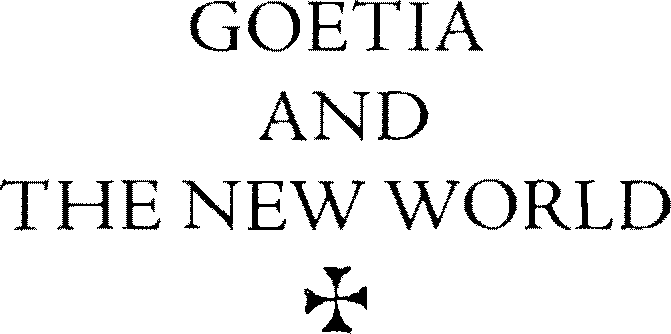
It is too often forgotten that Voodoo, for all its African heritage, belongs to rhe modern world and is part of our civilisation... The westernisation of an African religion has brought to light all the features which it shares with the religions of the ancient world, so that anyone acquainted with the classical universe can easily enter the mysterious world of Voodoo... Voodoo is a paganism of the West.
Voodoo Alfred Metraux, 1959.
■ etraux, as a highly educated Westerner of his generation, was of course f amiliar with Classical mythology, as well as acquainted with Haiti as an anthropologist. Fifty years later comparatively few Westerners are as knowledgeable concerning the mythology of the ancient world, and this leads more or less neatly to
an important question. To what extent were the grimoires the province of a highly literate elite, and how far do they represent popular traditions of various periods? In considering a literature extending from at least the i2lh to the 19* century, with origins, influence and development both sides of that period, this is a complex question which naturally cannot be finally settled here. It is necessary to ask it however, as there are powerful factors in the development of New World magical traditions which cannot be understood without doing so, as well as many issues relating to the whole sphere embraced by this book. It is known that the grimoire tradition had a significant and increasing influence upon the magical practices of the African Dias
pora in the Americas, and upon New World magical traditions from at least the 19th century onwards. Adapted versions of the talismans of the so-called Blaek Pullet are found in New Orleans Voodoo practice from at least the 1940s. In fact however the influence of such books, and the cultural traditions reflected in them, was felt over a century earlier. Many French grimoires were available in Haiti fairly early on, as well as in New Orleans and elsewhere, and their influence has steadily increased. Not only the books, which were probably not numerous initially, but European people themselves had a direct influence on the magical beliefs of Africans in Haiti and elsewhere both during and after the colonial period. As Metraux says:
A great many beliefs and practices in Haitian magic originate from Normandy, Berry, Picardy or ancient Limousin.
Ihe influence of the Book of Saint Cyprian, as well as the Europeans who brought it with them, was felt in Spanish and Portuguese colonies from at least the i9d’ century. Tills is quite besides the known influence of Kabbalistic magic upon Hoodoo, via Books of Moses from German sources, which again increased from the 1940s onwards, bur was preceded by books like The Long Lost Friend from the first half of the 19* century.
From some perspectives, those that over emphasise purely literary expressions of culture, the True Grimoire might appear to have been particularly influential. The reality is that, as a populist grimoire with strong folk magic connections, it reflects more extensively than others widespread folk magic traditions of European origin which had a powerful impact on those of the New World. It was not rhe main vehicle of those traditions, but a singularly rich literary reflection of them. The real vehicle of these traditions was people, including thousands of gypsies in the case of Brazil, whose impression on Quim-banda and indeed the whole culture is still powerfully felt. Hie populist grimoires were an aspect of the tradition, but while they are amongst the last remains of that tradition in Europe, they are but a small part of its survival in the New World. In other words, much that
Cinetia and the New World
was lost to European magical traditions prospers still in the New World religions.
Tire tact remains that there are elements of old European magic which have influenced the New World traditions that are nor represented in rhe grimoires aside from Verum. The primary example is rhe use of graveyard dust; this and other magical dirts were known in Spanish magic of the i6oos, and are common motifs in Hoodoo and other New World traditions. It is not however encountered in earlier Western grimoires. As Sirdar Shah tells us:
...experiments were accomplished by witches in their secret laboratories; and rhe first discovery of a laboratory of this kind was made in rhe year 1622, in Madrid. The owner, Josef Carranza, had - in an earthenware pot - resin and turpentine para las caderas de las mujeres; in another, a small quantity of something resembling pitch, together with small models of human legs, arms, and other things... One jar contained a cloth in which was wrapped a substance labelled Cemetery Earth, and Earth of Dead Bodies... Other discoveries at the same place included a human skull, frogs, and earth in a container whose label mentioned that it had been swept from the three prisons of Madrid.
There is also a process involving a Magical Head that, besides some associations in Western astro-magical lore, nevertheless possesses equally strong New World implications. Most importantly, there is the role of rhe intermediary spirit who must be conjured before the others, a classic feature of New World religion and sorcery, nowhere else explicitly stated in rhe grimoires. The use of sweet herbs in Holy Water also resembles New World practices. Another feature of Verum, which impressed modern commentators Hyatt and Black, is the sophistication and elaboration of ritual processes compared to texts such as the Key of Solomon. This is reminiscent of the complex liturgies encountered in Voodoo. It is of particular interest that in Brazil's Umbanda and Quimbanda traditions the hierarchy of Verum
has been widely associated with spirits known as Exus, and many of the correspondences between the two are strikingly appropriate.
Verum also refers to the Americas very specifically as part of its occult worldview. Just as Verum and other grimoires have been influential upon the magical and religious traditions of the African diaspora in the Americas so we can learn much from such traditions in our approach to Goetic magic; the centrality of a relationship with the spirits, and the approach to them as living beings with personalities, attributes and individual style and other characteristics is a useful one. This approach contrasts strongly with the supposedly traditional attitude of threatening the spirits with knives and considering them without distinction as agents of evil in terms of a theology that is alien to their origins. Similarly a cold, dispassionate and mechanistic approach is incomplete and unsatisfactory, and certainly gives no inkling of the approach employed by its authors and the magicians of their day. Whether or not we believe in a separate world of spirits is not the issue here. There are parts of our mind that respond to myth and symbol, and these are the parts stimulated by Goetic procedures, resistance to which is simply unhelpful, whatever we believe.

VERUM AND THE BRAZILIAN CULT OF QUIMBANDA *
KRVZ?||t is appropriate to accompany the collated and ratio-nal*se^ material from various editions of the Grimoire and EcMjijqg related texts with further material from the Brazilian cult of Quimbanda. This material concerns the Legion of Exus, or People of the Cemetery, a vast class of entities, many of which in various Brazilian traditions have as alter egos the demons of the Grimoire. The Brazilian cults of Umbanda and Quimbanda include a good deal of diversity. Among them are strands that have long recognised the demons of the Grimoire as direct equivalents of their Legion of Exus
or People of the Cemetery. These alter egos are known as qabalistic demons and the equivalences are listed below. The collective symbols of the Legion are skulls and skeletons, and their dwelling place is the cemetery and crossroads. Some spirits from the Goetia oj Solomon also have Brazilian forms, significantly these spirits are mostly those shared with the Grand Grimoire, which hierarchy has affinities with Verum, Again however, Western writers often speak of the Goetic influence on Brazilian traditions as if the Goetia of Solomon was the main, or even the only such influence. This is particularly unfortunate as several of these writers are evidently well informed about Brazilian magic, but much less well informed about the grimoires as a genre, rather than those most prominent in recent English speaking occultism. Closer examination will quickly verify that the most prominent Goetic contribution by far is not from that over estimated source, but directly from Verum. At least 44 Verum spirits have equivalents in Brazil, which is to say every single one mentioned in the Italian edition, which also supplied the hierarchical structure. This is compared to fifteen who may be from the seventy-two mentioned in the Goetia, which has
1 had no hierarchical influence. As Pruslas appears alongside these, at least some are more likely to have reached Brazil via the Grand Gii-moire or the "Ted Dragon, especially given the links between these and Verum.
While Brazilian occultism may be becoming more influenced by English speaking occultism comparatively recently, the influence of Portuguese, Spanish and French occultism has enjoyed a considerable headstart. How far back the association between Verum spirits and Exus goes is difficult to establish absolutely. It is very likely Verum first arrived in Brazil in the I9<h century. There have also apparently been editions of the very popular Book o] Saint Cyprian which included tables of spirits from Verum. Closer to our time the facts are much easier to ascertain, in the current form the connection of Exus and spirits from the Grimoire can be traced to the writings of Antonio Teixeira Alves Neto, in the late 1960s. David St. Clair who was in Brazil at this time makes extensive references to the same associations, which appears to have been already influential. Incidentally, Saint Clair’s groundbreaking book is recommended to Western readers even by practitioners who do not work with these qabalistic equivalents, so cultural differences aside, he appears to be a reliable and impartial witness.
The edition of the Grimorium Verum used in this deliberate comparative association (1 avoid rhe word syncretism, as it occasionally has negative connotations in New World religions), was apparently a contemporary Italian edition. I base this deduction on several points. To begin wirh, on the form of the sigils employed, which follows the easily distinguished Italian forms, in Brazilian use these are quite recognisable in several cases despite local adaptations. Another indication is the order of spirits in tabulated form appearing in Antonio Alves Teixeira’s 0 Livro dos Exus; Kiumbas e Eguns, which exactly follows that of the contemporary Italian edition. This order differs unmistakably from the order given in French and English editions (in tny opinion rhe correct one, though this is only important to the European side of things). Another significant indicator in this respect is the absence of Scirlin, common to all Italian texts known
co me. As all Exus are essentially intermediary in nature this does nor create any difficulties in the Brazilian cults, merely indicating rhe origin of the textual influences.
In Quimbanda and other Brazilian sects the term for indigenous sigils is ponto rtscado; the vast majority of these are unique to Brazil, but occasionally one encounters adaptations of the European sigils. Generally, when rhe sigils from rhe Grimoire are used they are called qabalistic signatures, as distinguished from indigenous pontos risca-dos, although the distinction is not always followed. Among those Exus listed below there are some instances, such as Exu Quebra-Galho (Frimost), where the pontos riscados are identical to the equivalent European sigils. Given this interchangeable quality the potential exists for use of pontos riscados where sigils are lacking and vice versa. In other cases, particularly the Pomba Giras, there are a huge amount of pontos riscados, and only a selection has been included. Take note that given the enormous number of quite distinct Pomba Giras, equivalence with the Verum spirit Klepoth should never be merely assumed.
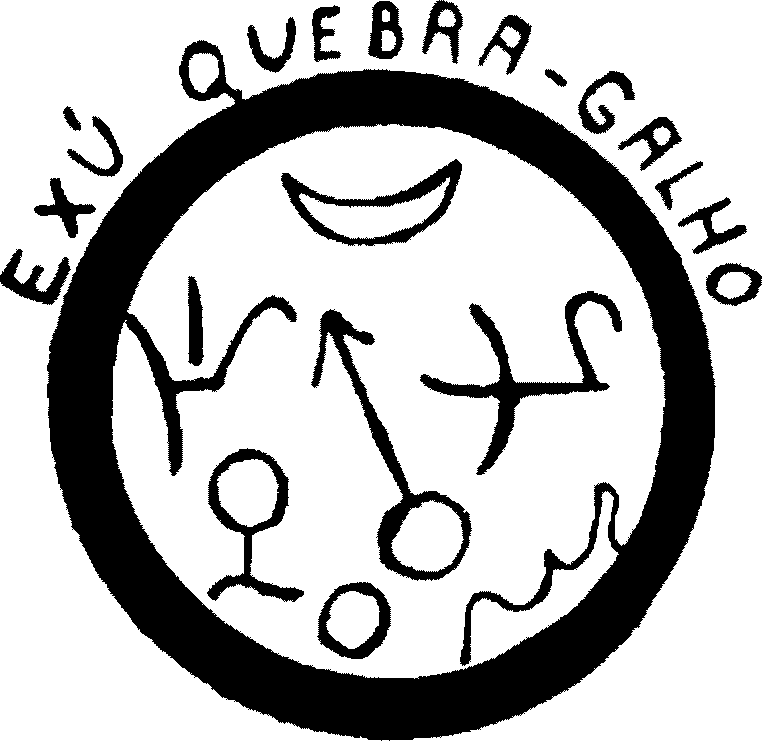
Qabalistic signature of Quebra Gidho, derived from Frimost sigil
The Quimbanda altars incorporate wrought iron pitchforks, sulphur and other diabolic imagery. Part of this is perhaps a reaction to Catholic demonisation of the Exus, as well as the influence of the grimoires themselves. Brazilian opinions concerning this diabolic symbolism are complex and varied; however there is little doubt that Quimbanda has a fearsome reputation. It is certainly' not to be idly played with by anyone ill-prepared or uncommitted in occult matters. Like Goetic magic, it is the preserve of those with real experience of, and familiarity with, the traditions concerned. On the other hand, critics of the association between Verum spirits and Exus would do well to understand the real significance of the True Grimoire before assuming such an association is either negative or superficial.
Spirits from Verum and their comparative
ASSOCIATIONS AMONG THE E.XUS
Lucifer:
Exu Lucifer

Pantos Riscados of Exu Lucifer
Belzebuth:
Exu Mor and Exu 9 Luzes; Exu the Great and Exu Nine Lights.
Astaroth:
Exu Rei De Sete Encruzilhadas,
The Exu who is King of the Seven Crossroads. This Exu belongs to the Line of Oxala, the god who created humanity. He commands all the Exus who vibrate at crossroads, whether of paths, streets, highways or railroad tracks. These are considered to be the preferred places for the Exus to receive offerings, as it is where they reside, and where their influence is most strongly felt.
Hie three chiefs constitute a counterpart to the Holy Trinity (Father, Son and Holy Spirit, themselves equated with Obatala, Oxala and Ifa). The Exu equivalent of the One God (as opposed to the Trinity) is the Maoiral, the Highest Exu. Another very major Exu is Exu Rei, or King Exu. It is important to recognise that these figures are essentially all distinct from one another, lhe ponto riscado ofMaioral clearly involves elements of the sigil of Lucifer in Verum.

Ponto Riscado of Maioral

Pantos Riscados oj Exu Rei
Satanakia:
In Quimbanda he is identified with Exu Marabo, a name for Exu in rhe Angolan tradition. Ihis Exu works in the Line of Oxossi, rhe hunter god. A similar word, maraba, means Indian and White crossbreed and is used as a friendlier name for Marabo.

Pontos Riscados of Exu Marabo
Agalierap (variant Agaliarept):
In Quimbanda identified with Exu Mangueira, an Exu who is the chief of the Legion within the Line of Exu. There is also a tree of this name, rhe mango, the leaves of which are used in initiation ceremonies. This Exu and Exu Marabo are deputies of Exu Lucifer, or as is sometimes said, of Exu Rei das Sete Liras. The resemblance to the hierarchical structure of Verum, where each Chief has two deputies, is readily seen.

Pontos Ri$cados of Exu Mangueira
T archimache:
Exu Tranca-Ruas - the Exu who Locks-Streets, an idiomatic expression that means Locker of rhe Ways, One of rhe proprietors of rhe crossroads, often depicted as a nude copper-skinned man with pointed ears and cloven hooves. There are variants of this Exu, like Tranca-Ruas das Almas, who may be closest in nature to Tarchi-mache. Tire Grand Grimoire alternative is Lucifuge Rofocale equivalent to Exu Rei 7 Cruzeiros, Exu King of the Seven Cemetery Crosses.

Pantos Riscados of Exu Tranca Ruas
Fleruty, Fleuretty, Fleurity:
Exu Tiriri (Exu Great Merit) — the Exu who is the messenger of Ogum. He uncrosses hexes and rights injustices, and is one of the most dangerous of Exus, Ogum is the Orisha of War. dhis Exu and Exu Tranca-Ruas are deputies of Exu Mor, compare Verum hierarchy.
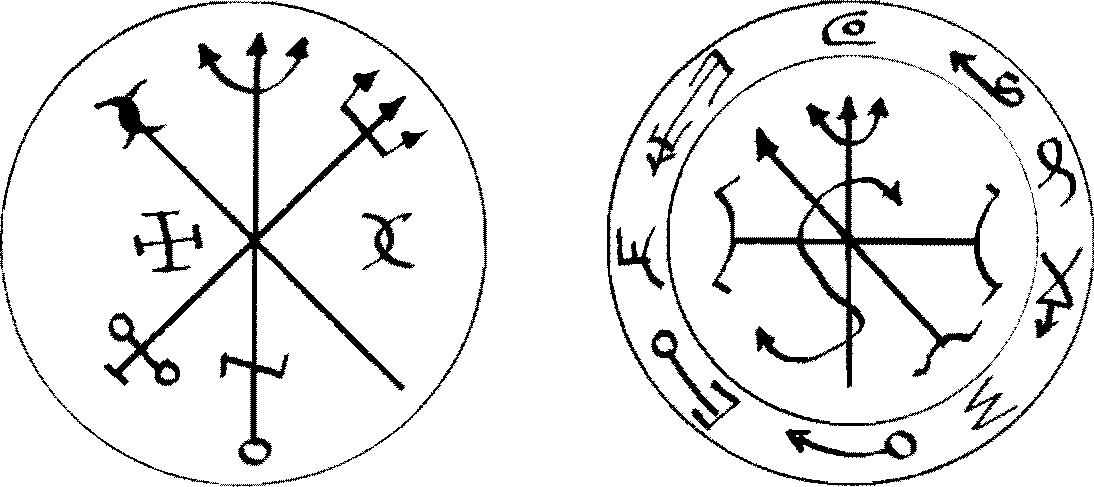
Pantos Riscodos of Exu Tiriri
Sagatana, variant Sargatanas, Sayathana:
Exu Veludo, Exu Animal Hide or Shaggy' Exu, a messenger tor Oxossi, the hunter god, who is covered with vela, animal skin. Another source calls him Exu Velvet Night. The real meaning of veludo is velvet.
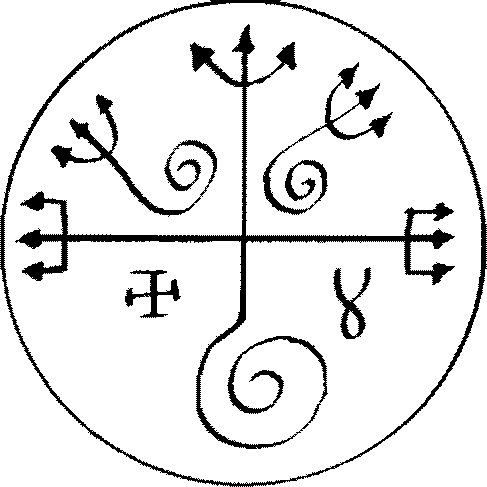
Panto Riscado of Exu Veludo
Nebiros:
Exu Dos Rios, the Exu of the Rivers, who works with the element of water. This Exu and Exu Veludo are deputies of Exu Rei das Sete En-cruziladhas, compare Verum hierarchy.

Pontos Riscados of Exu Dos Rios
Duke Syrach:
Exu Calunga, the Exu whose precinct is the cemetery. Calunga is also a title or alternative name for the Orisha Omulu, who in the Quimbanda adaptations of Verum rules the second group of fifteen spirits in essentially the same way that Syrach rules the first group of eighteen. Calunga is both the name of the Cemetery (Calunga Pequena) and Ocean (Calunga Grande), the lesser and greater Calunga. Both meanings point towards associations with Binah.


Pantos Riscados of Exu Calunga
Claunech:
Exu da Pedra Negra, Exu of the Black Stone.

Ponto Riscado o/ Exu da Pedra Negra
Musisin:
Exu da Capa Preta, Exu of the Black Cape, a spirit with a fearsome reputation.

Pontos Riscados of Exu da Capa Preta
Bechaud or Beebard:
Exu dos Ventos, Exu of the. Winds.

Panto Riscado of Exu dos Ventos
Frimost:
Exu Quebra-Galho, Branch-Breaker.
Klepoth:
Exu Pomba Gira (also Bomba Gira) or Pomba Gira Rainha da Praia; female counterpart of Exu Lucifer (or Exu Rei), the name means Spinning Dove. Despite this romantic title Westerners should be careful not to confuse Pomba Gitas with modern ideas about ’The Goddess’, some of these entities are distinctly dangerous.

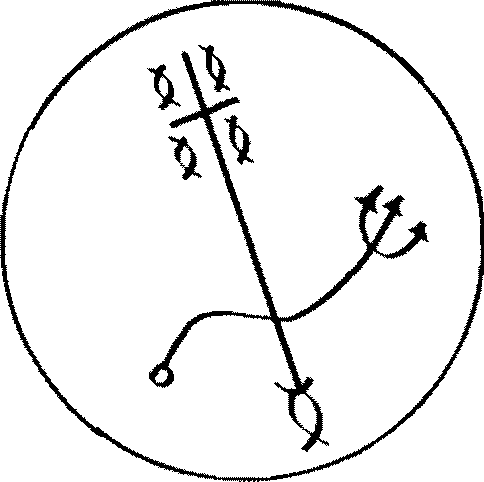
Pontos Riscados of Exu Pomba Gira
Khil:
Exu Sere Cachoeiras, Seven Waterfalls.
Mersilde:
Exu das Sete Cruzes, Exu of the Seven Crosses.
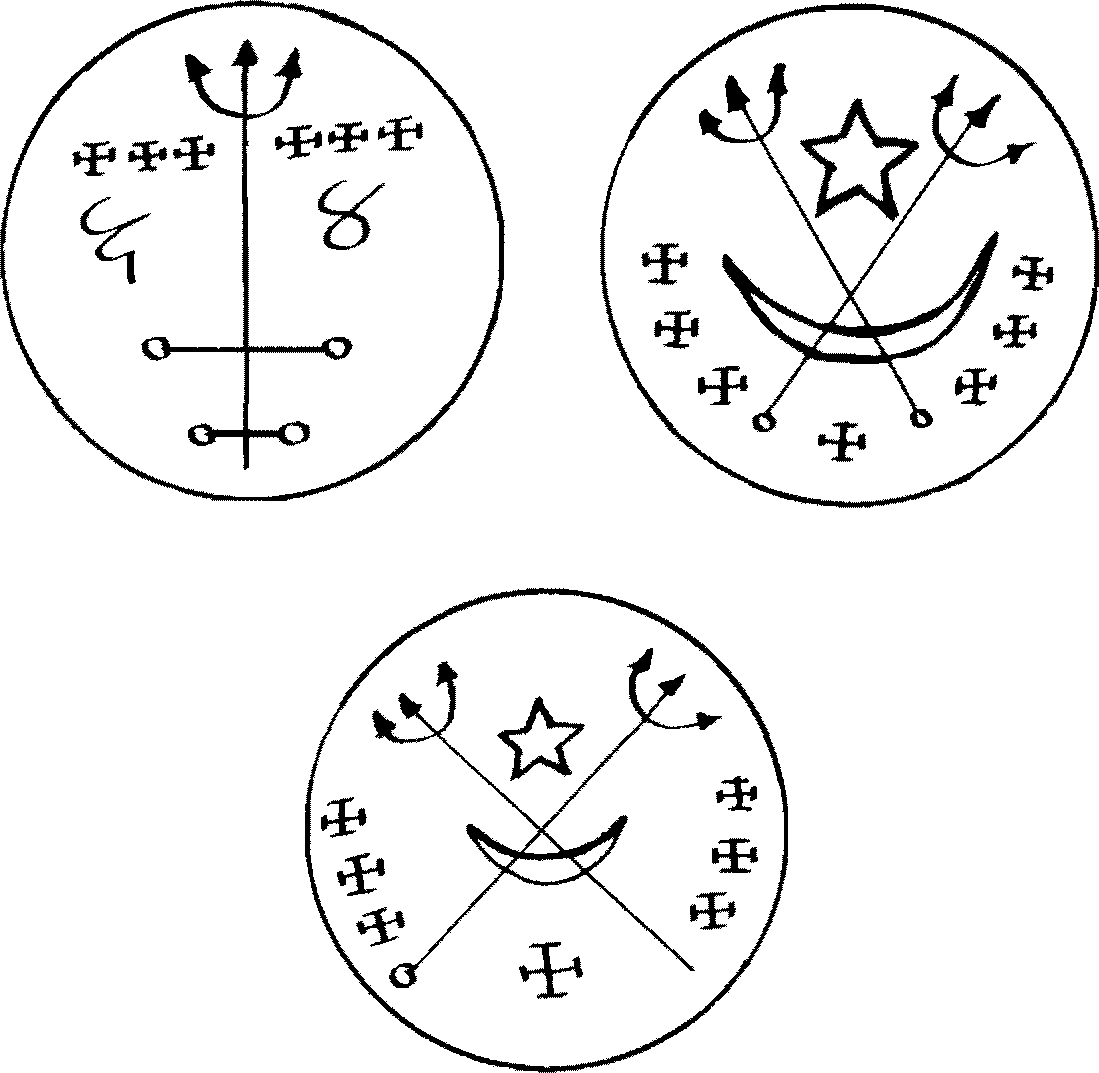
Pantos Riscados of Exu das Sete Cruzes
Clislhert:
Exu Tronqueira, Exu Offertory Niche, or Dark Sanctuary,

Ponto Riscado of Exu Tronqueira
Stlcharde:
Exu das Sete Poeiras, Exu of Seven Powders.

Ponto Riscado of Exu das Sete Poeiras
Hicpatth:
Exu das Matas, of the Forests, or Exu of the Bushes.
Hutnots:
Exu das Sere Pedras, Exu of the Seven Stones.
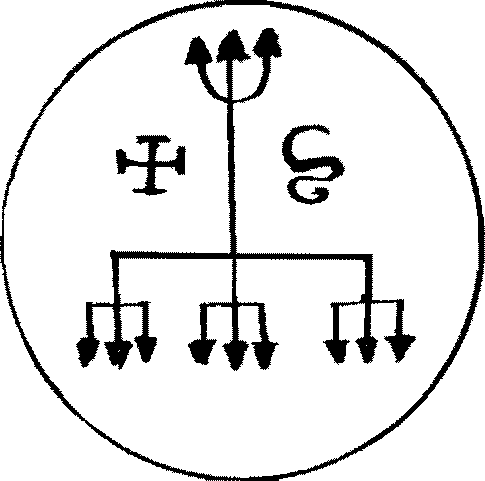
Ponto Riscado of Exu Sets Pedras
Segal:
Exu Gira-Mundo, World Turner or World Twister.

Pontos Riscado Exu Gira-Mundo
Frucissiere:
Exu dos Cemiterios, Exu of the Cemeteries. This name indicates an entire class of entities besides this spirit in particular.
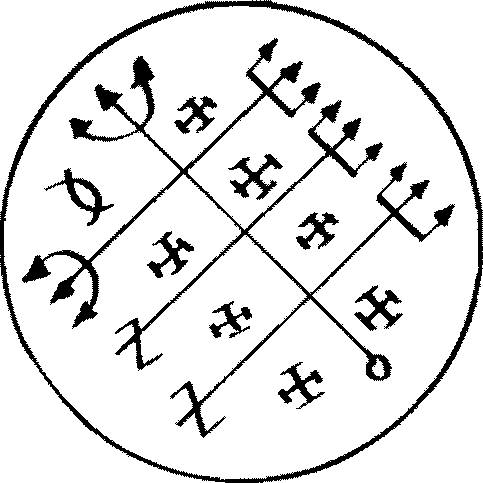
Ponto Riscado of Exu dos Cemiterios
Guland:
Exu Morcego, Bat Exu.
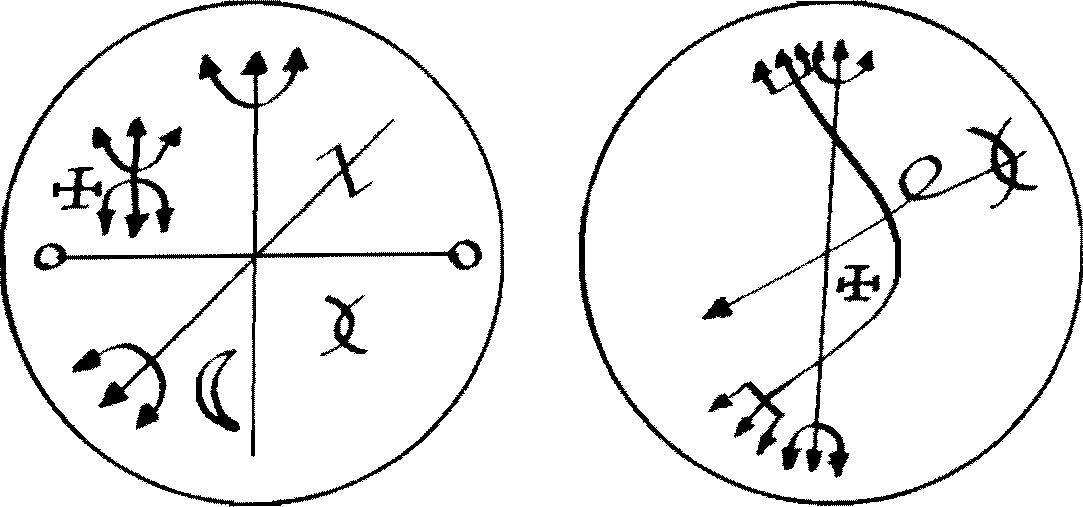
Pontos Rtscados of Exu Morcego
Surgut:
Exu das Sete Portas, Exu of the Seven Doors, there is another related Exu, called Exu Sete Porteiras, who, according to my Brazilian contacts, is much more powerful.
Morail:
Exu da Sombra, Exu of the Shade, or Shadow Exu.
Frutimiere:
Exu Tranca-Tudo, Exu Locks-Up-Everything, or Exu All-Locker.

Ponto Riscado oj Exu Tranca-Tudo
Huidigaras:
Exu Maraba, Exu Crossbreed.
SergHttby:
Exu Mirim. Mirim is an Indian word for child, thus Exu the Child or Young Exu. This name indicates an entire class of entities besides this spirit in particular.
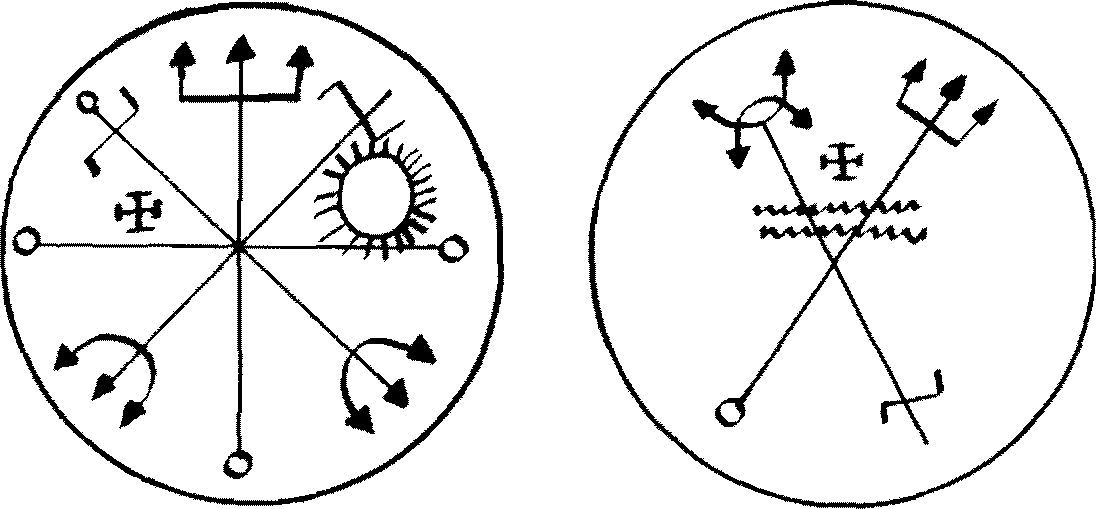
Pontos Riscados of Exu Mirim
Heramael:
Exu Curador, Exu rhe Healer.
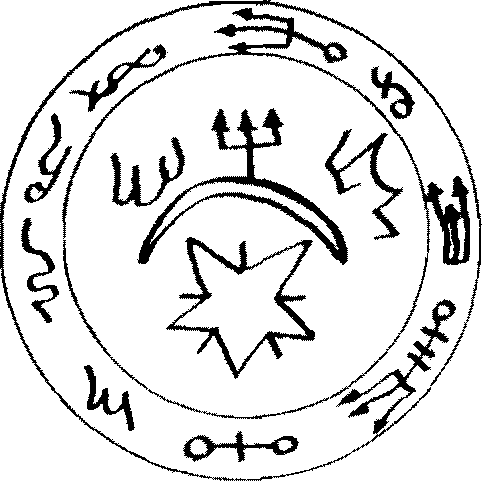
Ponto Riscado of Exu Curador
Trimasael:
Exu Pimenta, Exu Pepper.
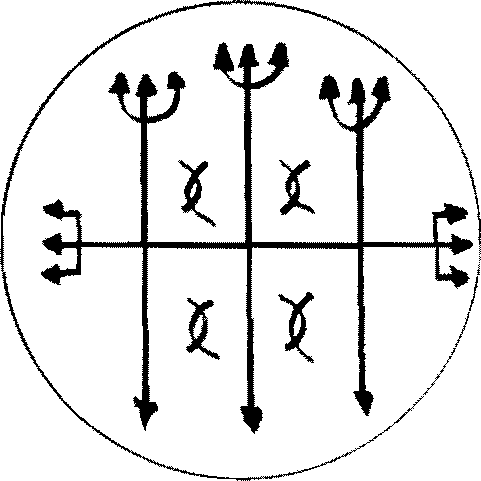
Panto Riscado of Exu Pimenta
Suflugriel:
Exu Male, Exu Rebel Slave.

Pontos Riscados of Exu Male
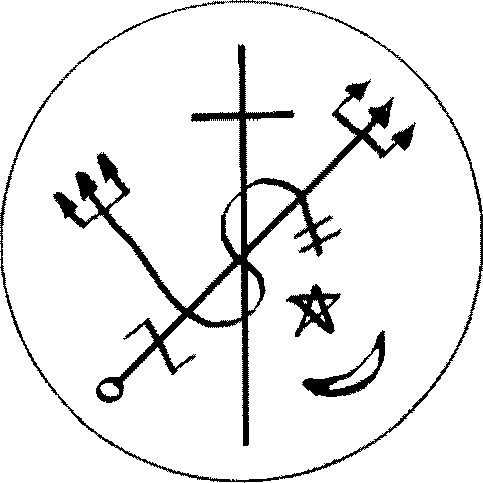
Another Ponto Rtscado of Exu Male
Tarihimal:
Exu Kaminaloa.
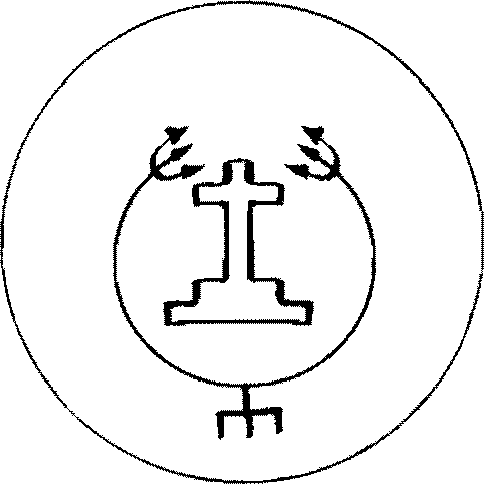
Ponto Riscado oj Exu Kaminaloa
Elelogap:
Exu 7 Montanhas, Exu Seven Mountains.
Hael:
Exu Meia Noire, Exu Midnight.

Pantos Riscados oj Exu Meta Noite
Sergulath:
Exu Caveira, Exu Skull.
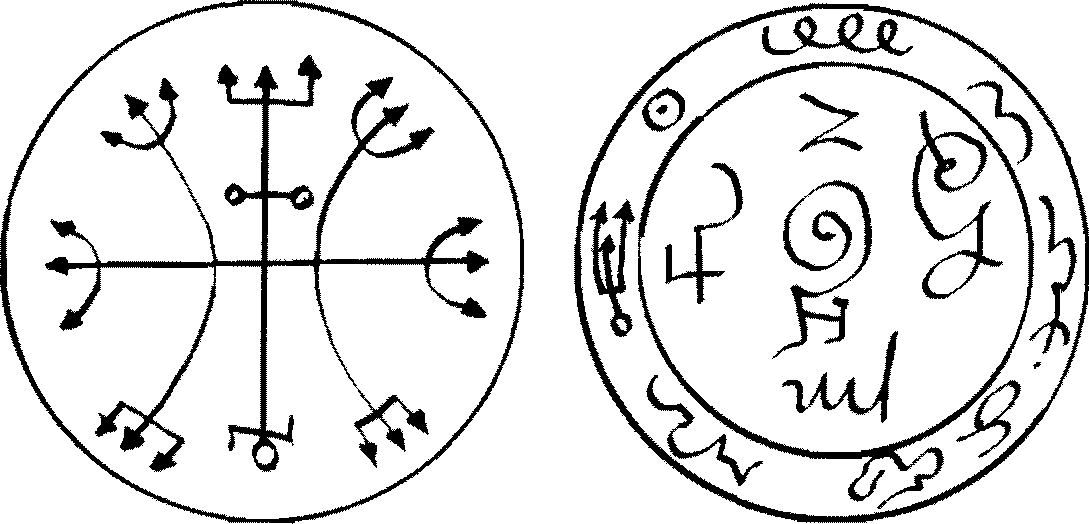
Pantos Riscados of Exu Caveira

Another Ponto Riscado of Exu Caveira
Proculo:
Exu Tata Caveira, Exu Skull the Elder; Tata, or Elder, also indicates an initiate of Palo Mayombe who has received his nganga.

Ponto Riscado oj Exu Tata Caveira
Hariilum:
Exu Braza; Exu Hot Coal.
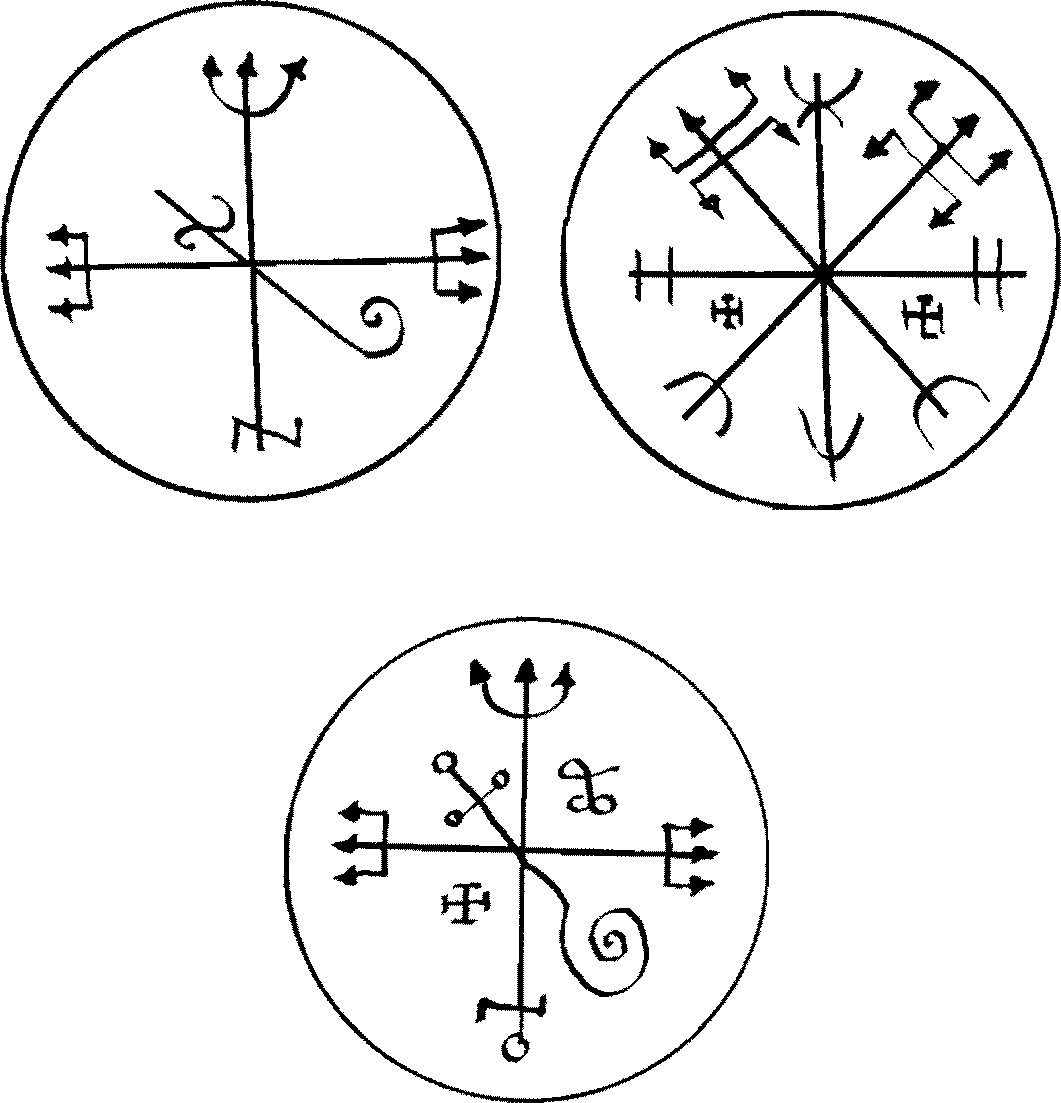
Pontos Riscados of Exu Braza
Brulejer:
Exu da Pemba, Exu of the Pemba; Pemba is a special chalk for drawing pontos riscados.
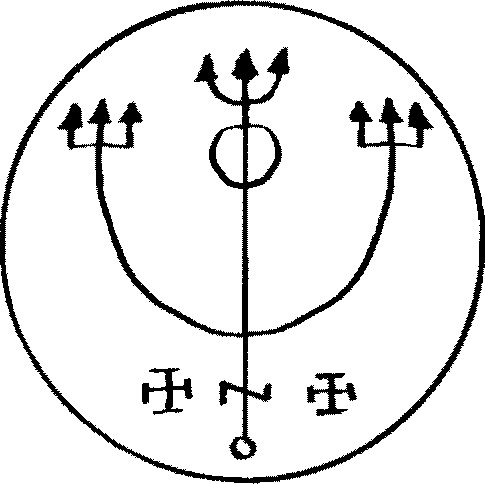
Ponta Riscado of Exu da Pemba
Pentagnony:
Exu Mare, Exu 1 ide.

Pontos Riscados oj Exu Mare and Exu Tide
Aglasis:
Exu do Cheiro, Exu of Smell.
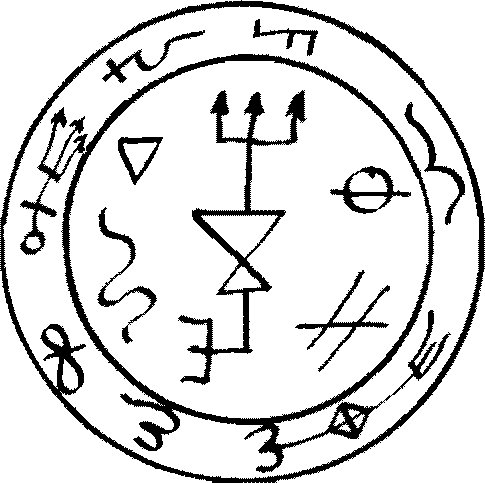
Ponto Riscado of Exu do Cheiro
Sidragosam:
Exu Carangola. Carangola is a town in Minas Gerais State, where Umbanda and Quimbanda are extremely strong in the countryside, this rather than the meaning of the town name is rhe real indication here.
Minoson:
Exu ArrancaToco, Exu Wood-Puller m the sense that he removes rhe obstacles in the way of the Quimbanda practitioner.

Ponto Riscado oj Exu Aranca Toco
Bucon:
Exu Pagao, Pagan Exu. Pagao indicates unbaptised rather than, for example, Wiccan. An unbaptised Exu is a term with a specific meaning, generally they are more involved in black magic, being amoral. On the other hand baptised Exus, who are often seen as more traditional in nature, have scruples consistent with the spiritual path of more enlightened practitioners.


Pontos Riscados of Exu Pagao
EXU EQUIVALENCES OF SPIRITS from Weyer and the Goetia
Pruslas:
Exu do Lodo, Exu of the Silt.
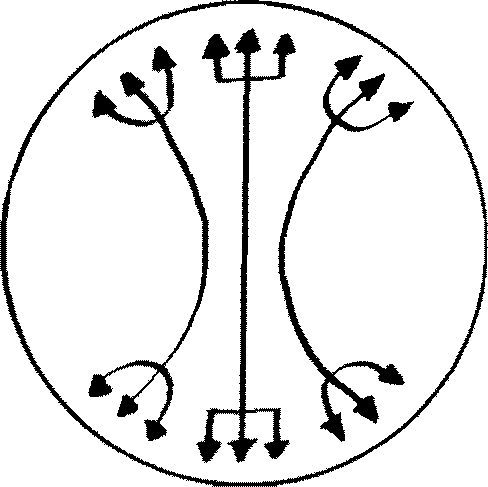
Ponto Riscado of Exu do Lodo
Murmur:
Exu 7 Liras, Exu Seven Musics or Seven Harps.
Raum, Raim, Raym:
Exu da Serra Negra, Exu of the Black Mountains.
Orohas:
Exu do Coco, Exu of the Coconut.
Bael:
Exu Rei da Mata, Exu King of the Forest, or of the Bushes.
Sbax, Scox:
Exu Ze Pelintra this name has no esoteric translation, Pelintra is a name of its own, and Ze is somthing akin to Jack, thus similar to John Doe.

Panto Riscado of Exu Ze Pelintra
Andrealphus;
Exu Marinheiro, Exu Sailor.
Aym:
Exu dos Infernos, Exu of the Hells.
Eligor:
Exu Guerreiro, Exu Warrior.
Vale/or:
Exu Malandro, Exu’Streetwise Bad-Ass', a Robin Hood character in some respects,'Exu rhe Smart is also appropriate.
rr-f r-| 1 y—i • .
lhe 1 rue Grimoire
Malphas:
Exu Sere Cruzeiros, Exu Seven Cemetery Crosses.
Andras:
Exu Sete Catacumbas, Exu Seven Catacombs.

Ponto Riscado oj Exu Sete Catacumbas
Stolas:
Exu das Campinas, Exu of the Prairies.
Asmoday or Asmodeus:
Exu Rei da Kalunga Pequena, Exu King of the Cemetery, see Calunga, title of Omulu.
Gaap:
Exu Sete Encruzilhadas, Exu of Seven Crossroads.
Amduscias:
Exu Sete Trovoes, Exu of Seven Thunders.
Postscript
One of the consequences of writing on subjects close to your heart is you often learn more in the process than you knew at the outset. Obscure matters become clearer, as previously undetected connections and implications come to light, so that understanding can not only improve but undergo transformations. This has certainly been the case in the long process of reconstructing and commenting the True Grimoire. Among the points clarified for me by this project is the way grimoires mutate, absorbing new ideas, contemporary beliefs and exotic elements from the time in which they were composed, as well as transmitting elements from earlier times.
The Key of Solomon is more a generic title than a monolithic and unchanging source. The idea of an Ur book in back of the variations of the Key oj Solomon, is misleading. There may be firsts in terms of particular elements or strands, but behind each are other interpretations and traditions leading in a variety of directions.
The later grimoires were often aimed directly at an increasingly literate lower class, or at magicians among them, and simultaneously reflected and influenced popular belief. In the same way the much earlier magical papyri may have been owned by ritual specialists, but reflected the beliefs and view of the world, both natural and supernatural, of the people around them, with whom these specialists were in close contact.
In the history of the grimoires there are many themes relating to popular beliefs, perhaps surprisingly given the illiteracy of much of the population during the greater part of that history. In fact illiteracy is less of a factor than appears, given that in some periods the Church actively sought to not suppress but adapt magical thinking in the wider culture. Preaching, word of mouth and folk memory played active roles in disseminating or changing ideas, that in turn are reflected in written works. In addition what people believe about magical books and those who own them is often as important as the actual contents of those books.
Select Bibliography *
Manuscripts and Editions of the Grimoires
Le Dragon Rouge, ou I’Art tie Commander les Esprits celestes, aeriens et infernaux. Milan, chez Gaspard Buffanelli.
Le Veritable Dragon Rouge, plus la Poule Noire, edition augmentee des secrets de la Reine Cleopatre, secrets pour se render invisible, secrets d’Artephius, &c.
Les Veritables Clavicules de Salomo. Tresor des Sciences Occultes, suiv-ies d’un Grand Nombre des Secrets, et notamment de la Magic du Papillon Vert. ND, various editions.
La Vera Clavtcola del Re Salomone, Tesora delle Sctenze Occulte con molti Altri Segreti e principalmonte La Cabala della Farfalla Verde, tradotte dalla Lingua Straniera alls Lingua Italiana da Bestetti. Milano, 1868 and Firenze, Armato Muzzi editore, 1880.
The Book oj Abramelin. Compiled and edited by Georg Dehn, translated by Steven Guth. Ibis Press, 2006. (From German manuscripts).
The Book oj the Sacred Magic of Abramelin the Mage. Translated and edited by S.L. MacGregor Mathers. Thorsons, 1976, 1977. (From a French manuscript).
The Discoverie oj Witchcraft. Scot, Reginald. 1665 edition (with excellent critical notes by Br. Nicholson 1973).
The Goetia of Solomon the King. Various editions and ms.
The Grtmoreum Verum. Compiled by Jon Symon, Acorn, ND.
The Grimoire of Armadel. Translated and edited by S.L. MacGregor Mathers, Routledge and Kegan Paul, 1980.
The Grand Grimoire. Compiled and edited by Darcy Kuntz, Holmes Publishing Group, 2001,
The Key 0/ Solomon. Translated and edited by S.L. MacGregor Mathers, Routledge and Kegan Paul, 1972.
The Sixth and Seventh Books of Moses, or Moses' Magical Spirit Art. ND.
Works on Solomonic Magic;
Sources of Goetic Magic;
Studies
Abbe N. de Montfaucon de Villars. Le Comte de Gabahs. 1670, Paris.
Agrippa, Heinrich Cornelius. Three Books of Occult Philosophy. 1531, Paris, (attrib.) The Fourth Book oj Occult Philosophy.
Betz. Hans Dieter (Ed.). The Greek Magical Papyri in Translation (Second Edition). 1986.1992-996, The University of Chicago Press.
Black, S Jason & Hyatt, Christopher S. Pacts with the Devil. 1993, New Falcon.
Flint, Valerie I.J. The Rise of Magic in Early Medieval Europe. 1991, Clarendon Press Oxford.
Bibliography
Flowers, Stephen Edred. Hermetic Magic, The Postmodern Magical Papyrus of Abaris. 1995, Weiser.
Givry, G. De. A Pictorial Anthology of Witchcraft, Magic and Alchemy. 1958 (reprint of 193 1 edition), University Books, N.Y.
Leitch, Aaron. Secrets of the Magical Grimoires. 2005, Llewellyn Publications.
Marathakis, loannis. From the Ring of Gyges to the Black Cat Bone: A Historical Survey of the Invisibility Spells.
http://www.hermetics.org/Invisibilitas.html
Mclean, Adam (Editor). The Magical Calendar - A Synthesis of Magical Symbolism from the Seventeenth-Century Renaissance of Medieval Occultism. 1994, Magnus Opus Hermetic Sourceworks, Phanes Press.
Peterson, Joseph. Twilit Grotto. CD with Search Engine, and online archive: http://www.esotericarchives.com
Peterson, Joseph, and Stratton-Kent, Jake. Email group devoted to the Grimorium Verum and goetic studies: griniorium_verum@yahoogroups.com
Shah, Idries Sayed. Oriental Magic. 1956, Rider. The Secret Lore of Magic. 1957, Muller.
Shah, Sirdar Ikbal Ali. Occultism, Its Theory and Practice. 1952, Rider.
Waite, Arthur Edward. The Book of Black Magic. 1972, Weiser.
Webb, Don. The Seven Faces of Darkness, Practical Typhonian Magic. 1996, Runa-Raven Press.
Works on Quimbanda and Related Traditions
Bittencourt, Jose Maria. No Reino Dos Exus; Estudo Cuidadoso, sobre todas as entitades que baixam nos terreiros. 1970, Rio de Janeiro, Editora Eco.
Deren, Maya. Divine Horsemen. Thames and Hudson. 1953, republished as: The Voodoo Gods. 1975, Granada Publishing Limited.
Dow, Carol L. Sarava! Afro-Brazilian Magic. 1997, Llewellyn Publications.
Goodwin, Charles Wycliffe. Fragment of a Graeco-Egyptian Work upon Magic. 1852, Cambridge.
Metraux, Alfred. Voodoo. 1959, Andre Deutsch Ltd.
Montenegro, Carlos Galdiano. Palo Mayombe. 1994, Original Publications.
St. Clair, David. Drum & Candle - First Hand Experiences and Accounts of Brazilian Voodoo and Spiritism. 1971, Bell Publishing Company.
Seabrook, W.B. The Magic Island. 1929, Harrap & Co.
Teixeira, Antonio Alves. Pomba Gira: Rituals to Invoke the Formidable Powers of the Female Messenger of the Gods. 1990, trans. Carol L. Dow. Burbank, Calif. Technicians of the Sacred. O Livro dos Exus; Kiumbas e Eguns. 1967, Rio de Janeiro, Editora Eco.
Yronwrode, Cat. Hoodoo in Theory and Practice. 1995-2003, Lucky Mojo.